I tumbled down the aeroplane steps onto Costa Rican soil with virtually no plan whatsoever.
Jagged silhouettes of jungled-strewn mountains cut a lightening bolt outline into the reddening evening sky.
Humid air clung clammily to my skin as I waited in line at the arrivals terminal before it was my turn to be called up to the check-in counter.
Attempting my first real-life Spanish in years, my brain ordered “hola” whilst my tongue went for “hello” leading me to half-shout “HOLLO”! Everyone looked at the odd-seeming, profusley sweating gringo.
Fast forward several weeks and I was waking up from an especially nasty hangover in Jaco; a seaside surf-party town along Costa Rica’s central Pacific coast.
Jaco was a place that I came to both love and loathe; loved it I did for the endless array of zany characters that skipped down it’s every street, loathe it did I because party there too much I did.
It became my home-base for the next 12 months; I rented an apartment there to which I returned frequently to get funky (consume copious amounts of drugs and alcohol) between diving trips spent in other parts of Costa Rica and Central America.
I could tell you all sorts of cool things about Jaco; but the truth is that the scuba diving there kinda sucked and you probably don’t got all gawd-dayum day, so let’s skip merrily ahead and proceed with the main adventure.
Sitting comfortably? Ok, here we go:
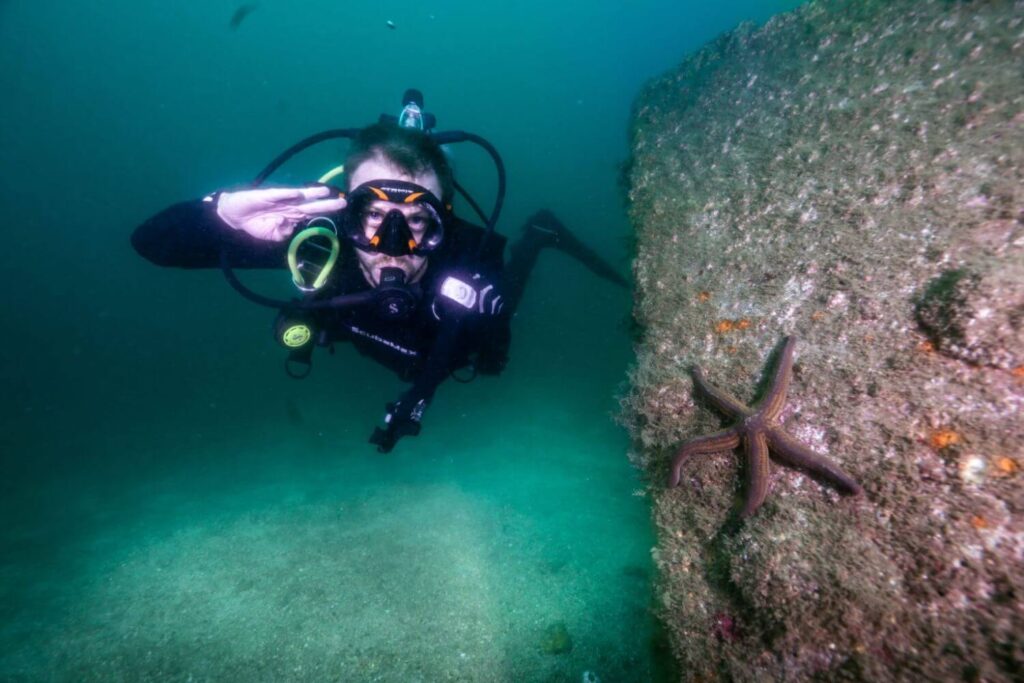
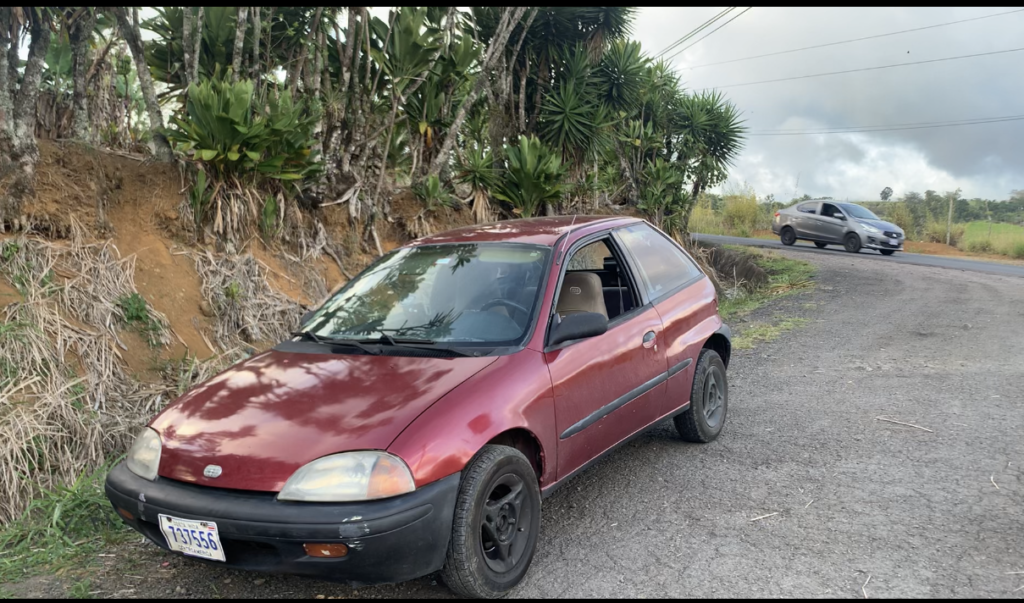
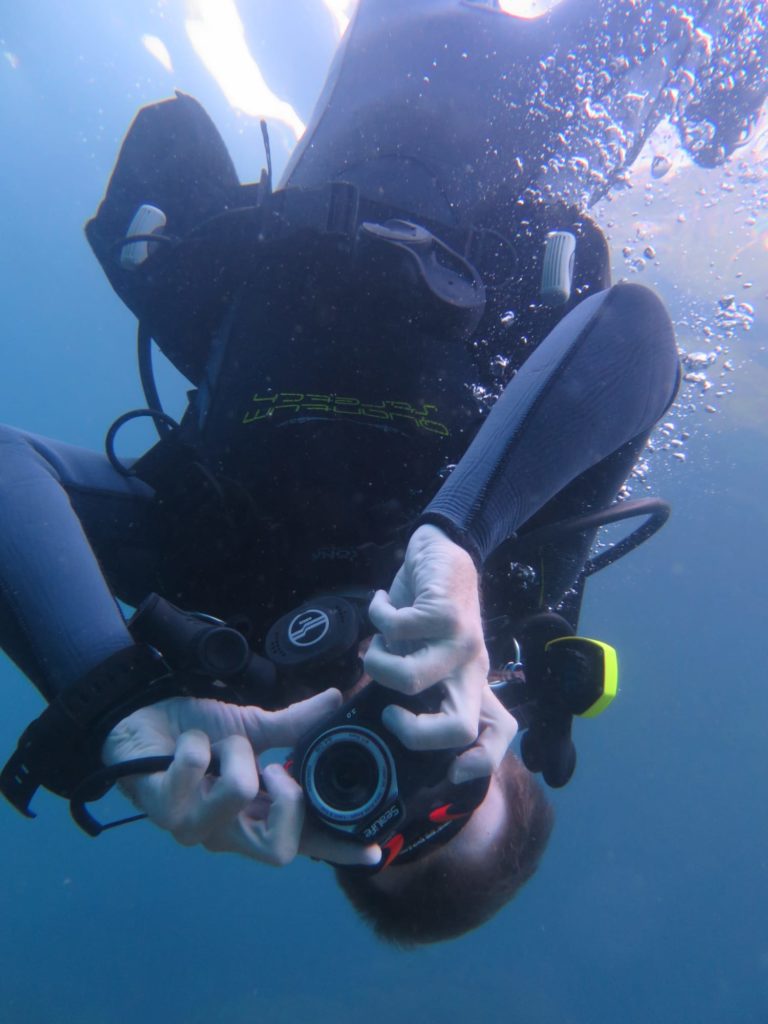
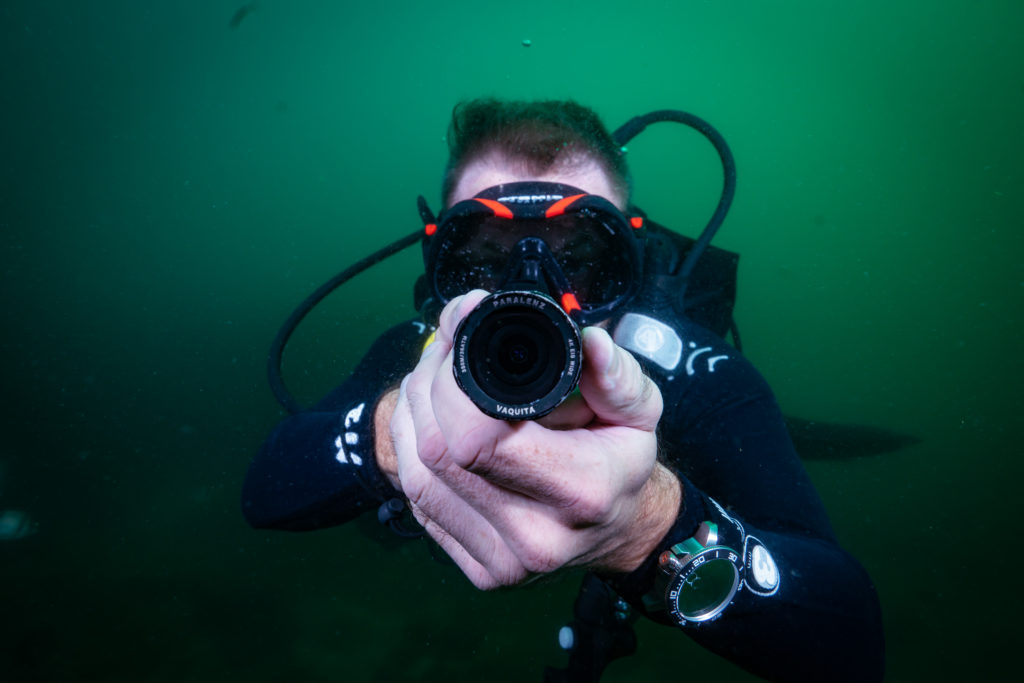
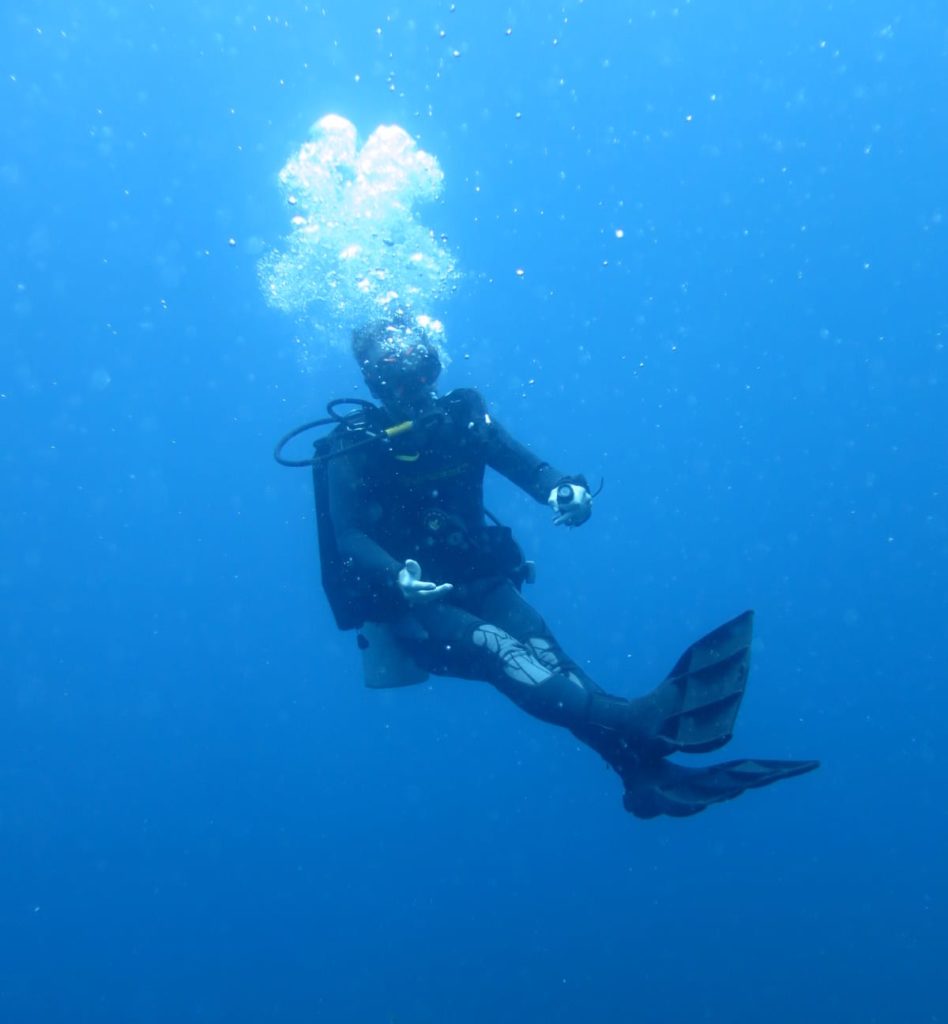
But first, in case you have no idea where the fuck Costa Rica is: it’s on the Western Hemisphere of Planet Earth:
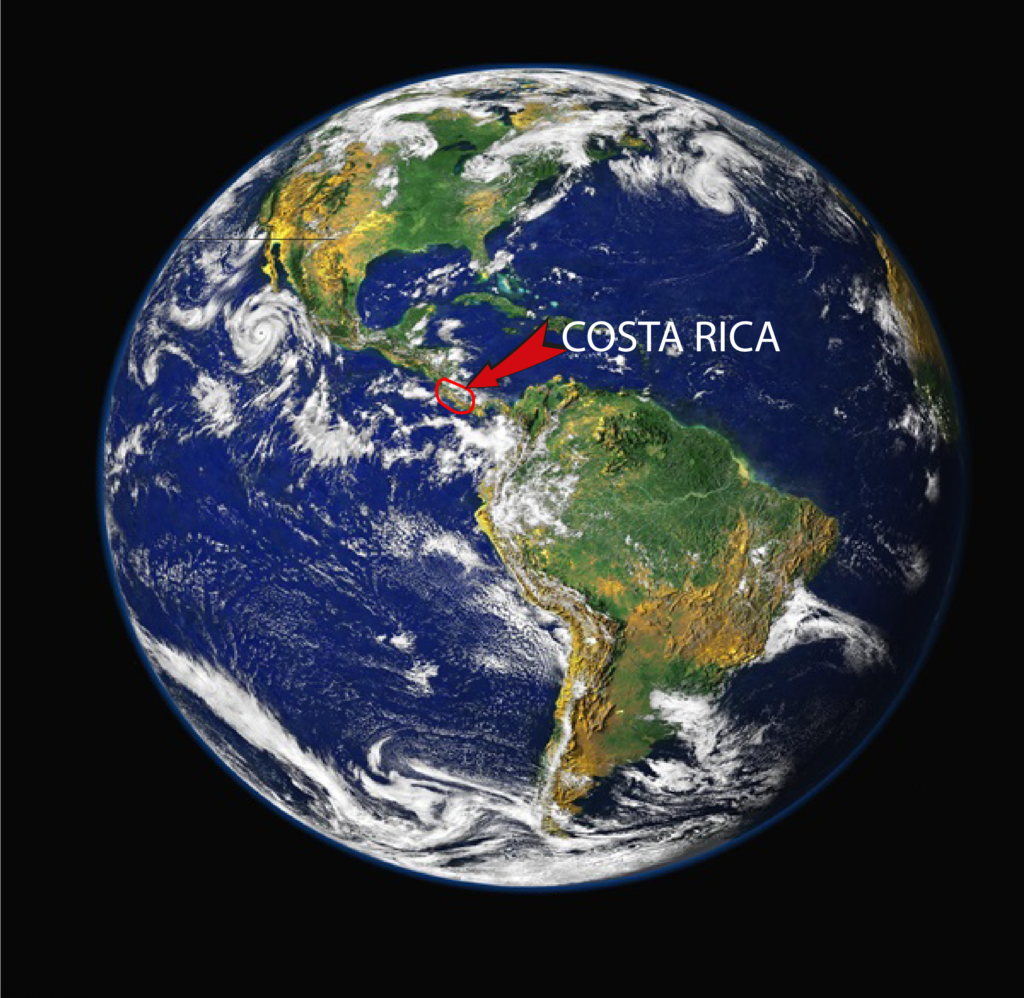
Costa Rica is one of 7 countries comprising Central America (which geographically-speaking is the southernmost region of North America). Central America is bordered by Mexico to the north, the Caribbean Sea to the east, Colombia to the south and the Pacific Ocean to the west:
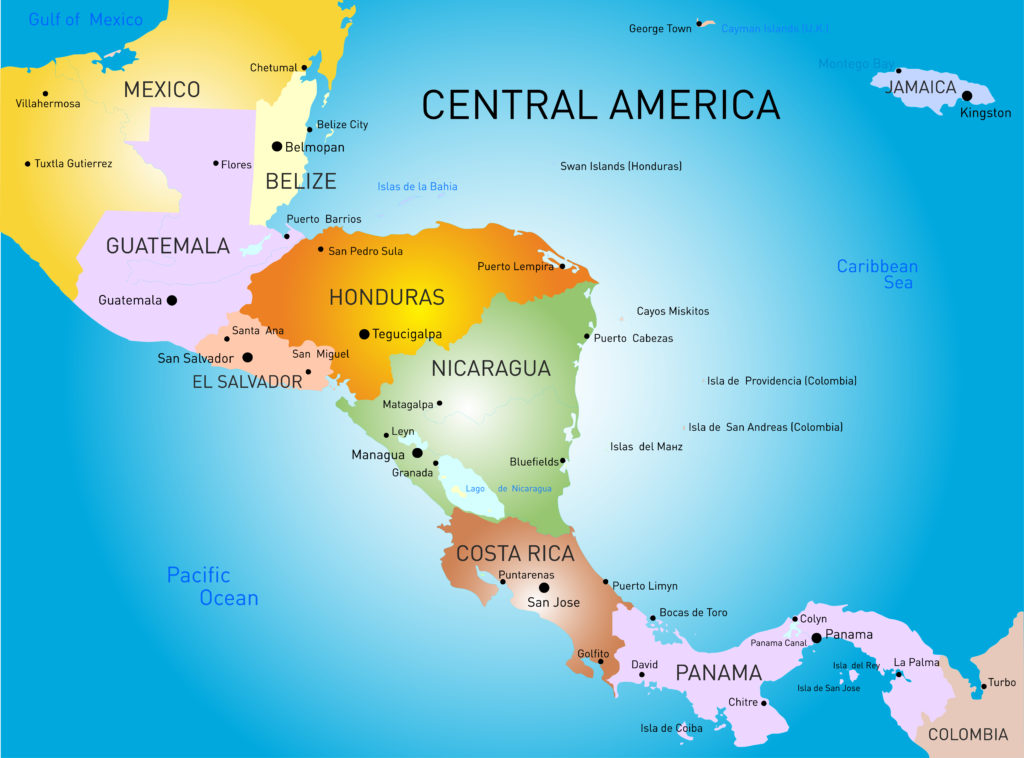
From 05/07/21 – 05/07/22 (1 year exactly!) I travelled the following routes through Costa Rica and it’s two neighbouring countries; Panama to the south and Nicaragua to the north:
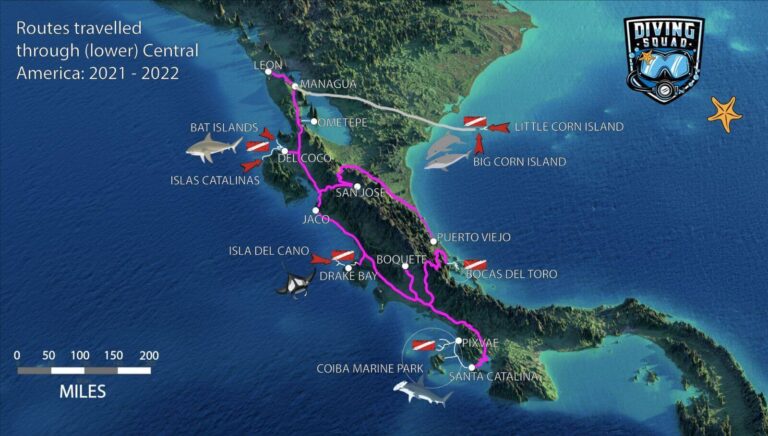
Ok, now you’ve got a feel for where this tale takes place, let’s get the fuck on with it!
So there I was in Jaco, enjoying the partying but soon realising that the local scuba diving weren’t so good.
But fret not gentle reader – 200km further north up Costa Rica’s Pacific coast, nestled along the north-western edge of the Nicoya peninsular in Guanacaste province, lies another beach-town: Playa del Coco.
As well as having over a dozen local dive sites, Playa del Coco is a launch pad for two of Costa Rica’s most favourite scuba diving destinations: the Catalina islands (Islas Catalinas) and the Bat islands (Islas Murcielagos).
Whilst solo travelling, I would stay at Playa del Coco on four separate occasions over the next twelve months.
Like most areas along the Pacific coast of Central America; Playa del Coco’s diving is defined by big marine animals. Its water’s are filled with schooling fish, turtles, rays and white tip reef sharks.
The seabed was strewn with boulders; however no coral grew from them, barring a very few bedraggled looking patches less than a foot wide.
Locals told me that only a few decades ago there’d been scores of reef but now it was long gone due to over-development from people.
Still, there was plenty of other life in the water.
Moray eels and lobsters poked their heads from the rocks and dozens of spiky porcupine fish hovered nearby whilst scores of sergeant and butterfly fish painted the water yellow and white.
Ten-foot-wide eagle rays with dark blue bodies covered in white spots swooped gracefully over entirely grey southern stingrays slowly that cruised lazily over the seabed.
Scattering in all directions were their much smaller cousins, the Costa Rican round stingrays; their half-foot-wide, sandy coloured bodies decorated with black and brown markings for camouflage.
Turtles were everywhere: Playa del Coco is home to leatherbacks, green, olive ridley and hawksbill turtles; the ones here were some of the friendliest I’d ever met, often swimming right up to divers.
Resting along the seabed there was always one or two and sometimes as many as half a dozen white tip reef sharks; usually 5 (but up to 7) foot long sharks that rest by day and hunt fish in packs by night.
With narrow, supple bodies; they’re known for weaving between rocks and tight crevices when hunting for fish which upon finding they swarm with ruthless efficiency; often biting one another in the process.
Any creature hapless enough to be rugby-scrummed by a gang of white-tipped sharks is highly unlikely to escape – but white-tip reef sharks don’t share so it’s usually only one of them who get’s to eat-per prey that they swarm.
Things moved slowly during my first two stays at Playa del Coco; I was still getting used to my new back-inflate bcd: an Apeks Black Ice whilst also trying to decided what I wanted to focus on with Diving Squad.
Then out of the blue, Paralenz: a revolutionary underwater camera manufacturer offered me their new Paralenz Vaquita – for free! (So long as I promoted it…which I’ll do now:
I really do love the Paralenz Vaquita – it’s the best underwater video camera out there!
Designed exclusively for scuba divers; it’s insanely-tough aluminum body makes it waterproof to 1150ft (350m) whilst the 140 degree, rectilinear lens shoots incredible 4K videos at up to 60fp and super slowmo 1080p video at 240fps!
There’s several cool accessories to go with it; including a floating selfie stick, a trigger style hand grip and a mask mount – I got all of these for free as well and successfully broke every last one of them within minutes of their un-packaging.
(Don’t ask why or how but I actually melted part of the selfie-stick…)
(Read more about the Paralenz Vaquita in my main review of it here).
Fortunately though the actual Vaquita camera survived and it was with this that I shot the underwater scenes of my first scuba diving video in Central America; which set my mission objectives for the rest of that year
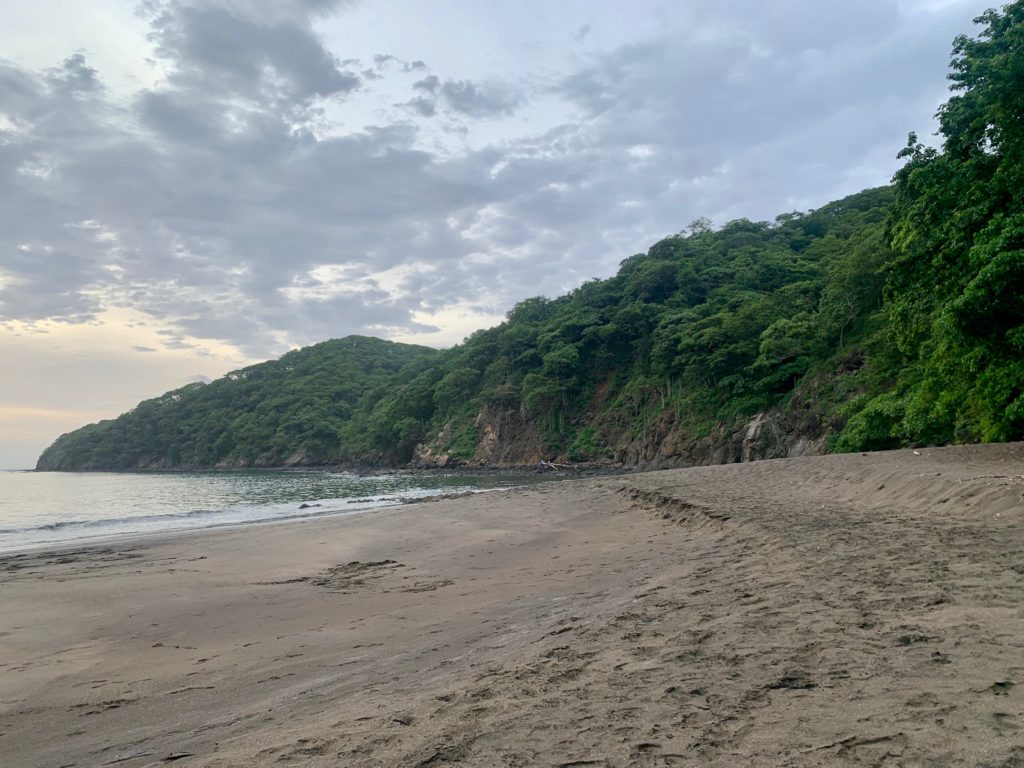
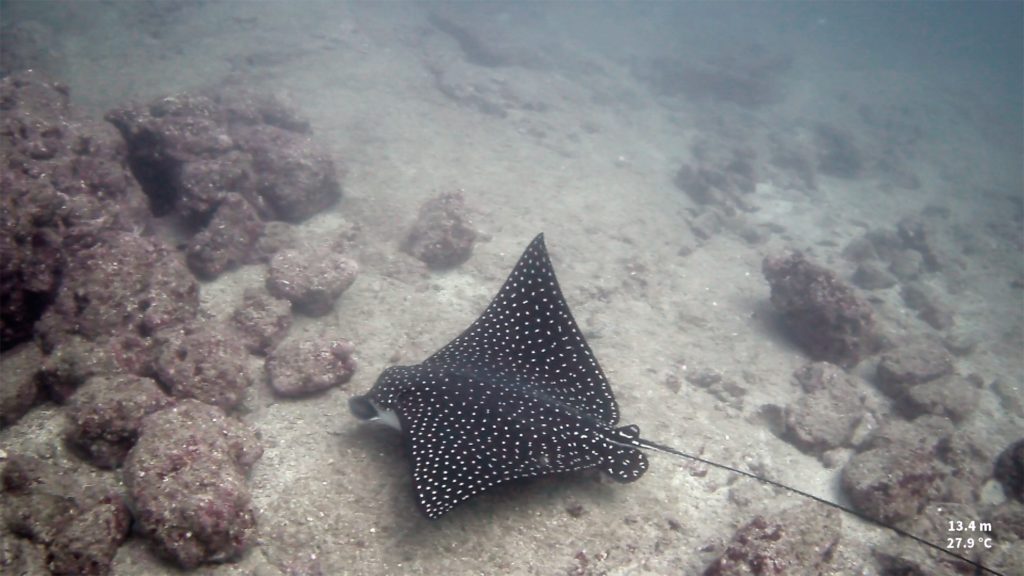
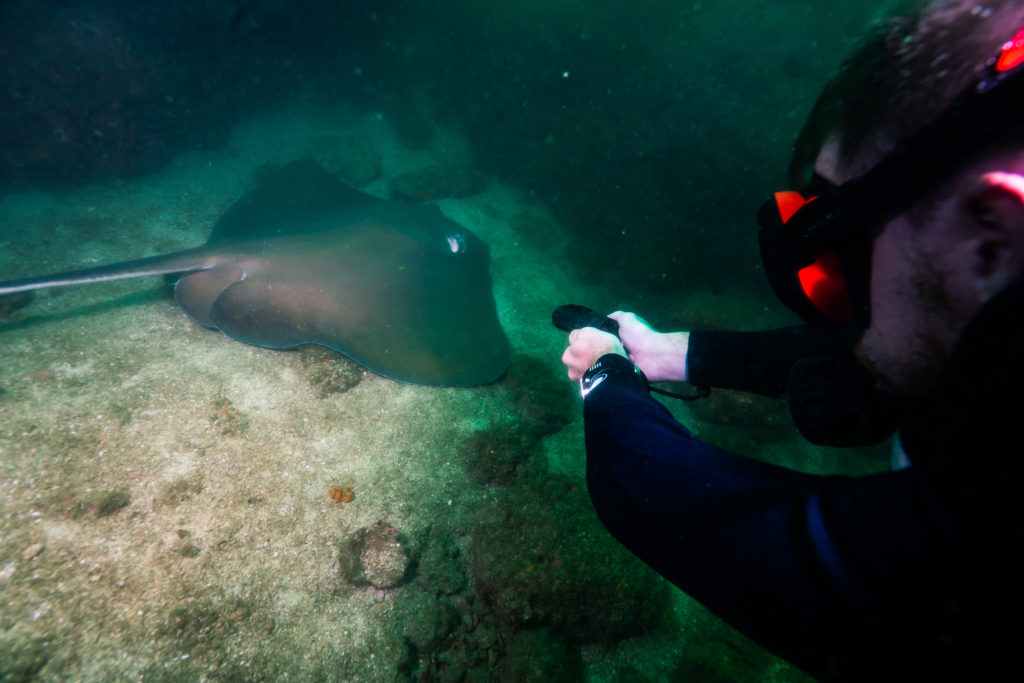
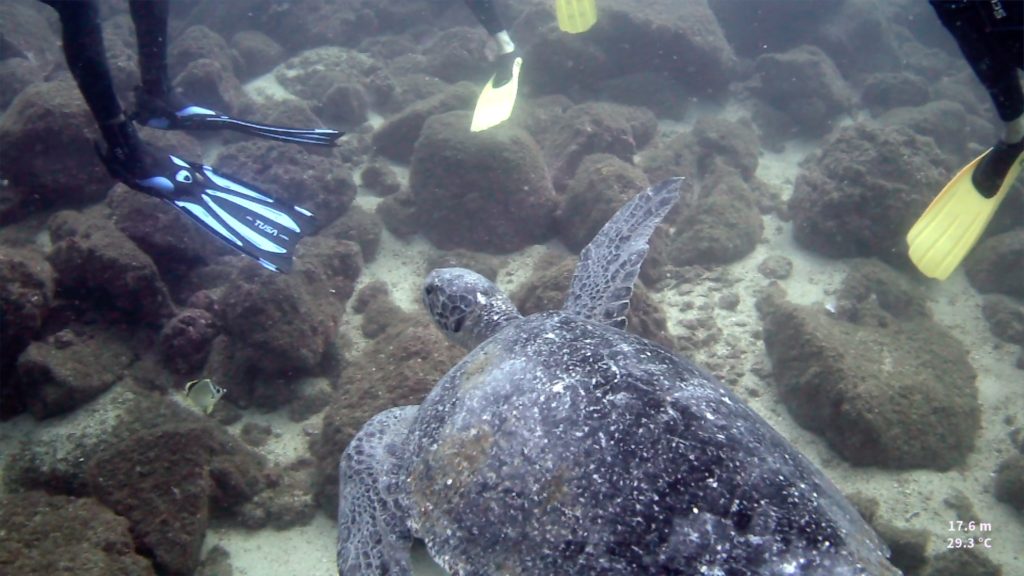
This turtle swam right up to a group of divers for a high-five
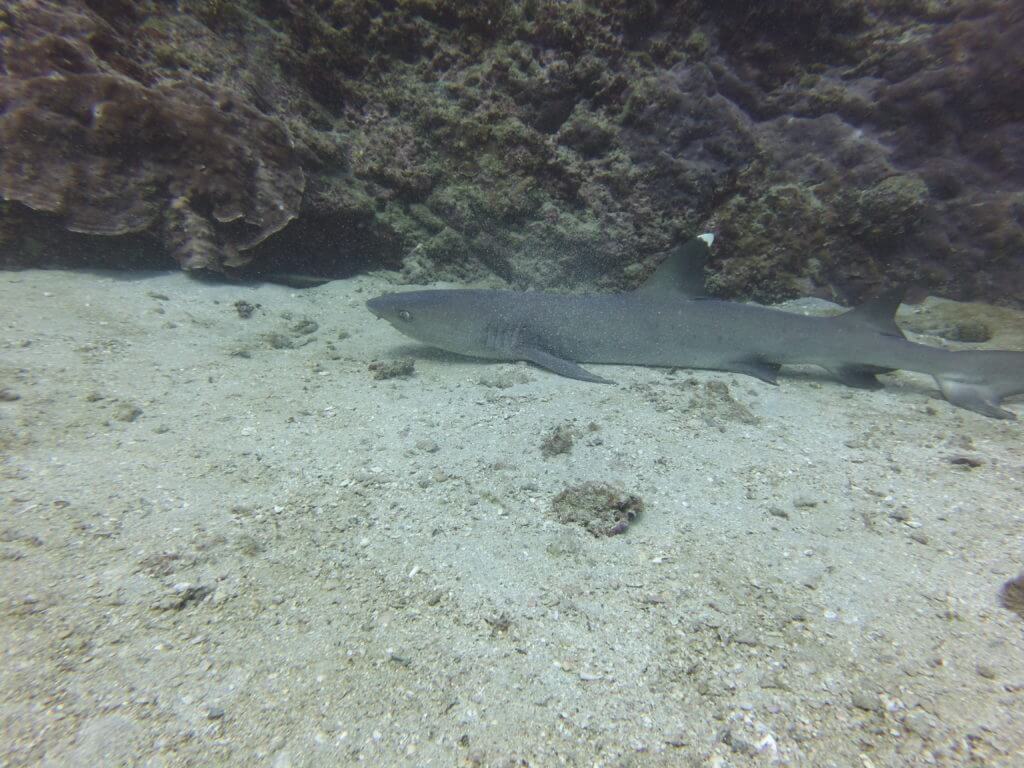

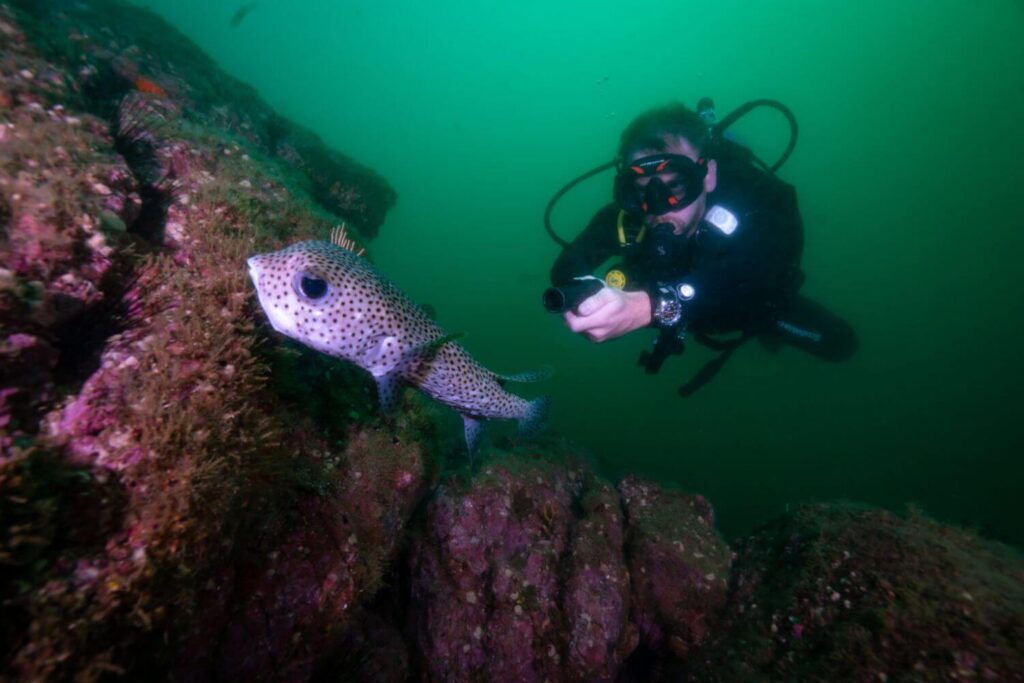
What did I learn from creating the above movie with my Paralenz Vaquita and after sharing it on the Diving Squad Instagram which at the time had less than 500 followers?
This:
- Poor water visibility is the bane of any diving video.
- People’s attention spans are getting shorter. Instagram places a maximum of one minute per video meaning I had to split this one into two parts when I uploaded it.
- Keeping a camera still whilst maintaining neutral buoyancy; sometimes amidst currents… is harder than it looks!
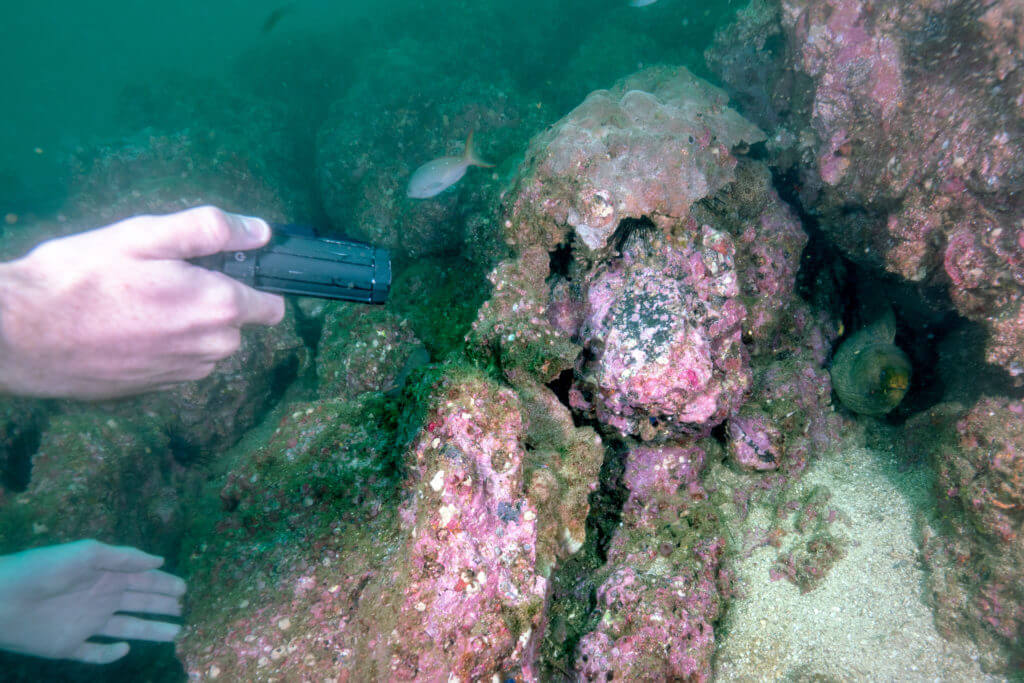
Although I had a lot to learn about shooting and editing underwater movies, now that I had an underwater camera capable of shooting incredible-quality diving videos, I was hooked.
I loved the idea of creating super short and punchy pieces that make the viewer feel as if they’re going on the dive themselves.
Looking around at other scuba diving blogs, I noticed that this was something many of Diving Squad’s competitors lacked: original movies of diving-on-location!
I wanted to create scuba diving movies that were so engaging and surprising that everyone – not just hardcore divers, would want to watch them all the way through.
One way I wanted to achieve this was by blending documentary-style video presentation with more surrealistic techniques like reversing clips or playing around with their speed and splicing in stills.
But first, I needed to get to grips with my equipment; I didn’t even realise until after several dives that the Paralenz Vaquita also shoots amazing slow motion vids:

^Above Video: We see a large school of Spottail Grunt fish; a common sight when diving deeper water’s off Costa Rica’s Pacific side, followed by Deep Blue Dive diving instructor Emanuel blowing bubble rings and finally an Eagle Ray swimming past behind him which we then zoom in on. Filmed with the Paralenz Vaquita at 1080 / 240fps.
At first, I mainly explored the local dive sites of Playa del Coco – despite it’s close proximity to the more famous Catalina islands and Bat islands.
My first stay at El Coco was during July; outside of manta ray season for which the Catalina islands are best known. During this time, I did visit the bat islands to see a bull shark but didn’t spot any.
On my second stay at Playa del Coco in late-October, I tried to arrange a bull shark visit at the bat islands again, but this time the problem was that none of the dive shops wanted to go unless at least 4 people were interested and I was on my lonesome.
I made several dives to the Catalina Islands in October but a red algae bloom reduced the water visibility to a mere few meters.
We saw just about every other kind of ray for which the region is known: devil rays – (not once did I spy them underwater but most frequently they were seen leaping forth from it whilst we were still on the boat),…
….numerous tiny costa rican spotted stingrays, 4-foot wide southern stingrays and eagle rays – they’re dark blue with white spots bodies up to ten foot wide and sixteen foot long. During a night dive around Playa del Coco, I even saw a guitar ray; a most odd looking creature indeed).
However – not a single manta ray did I see even though this was the main reason I’d been enticed to dive the Catalina Islands and the focus of the Diving Squad mission.
Truth be told, I was a little early – although manta rays can be seen at Costa Rica’s Catalina Islands on any month of the year – they’re more prominent from late November to early May.
Still it would be hard to complain with all the ray species I did get to see.
I’m now under the impression that rays are thriving around Costa Rica’s north Pacific side – the numerous species of them likely filling a range of ecological niches.
I found the eagle rays especially awe-inspiring. They were the biggest rays I saw diving Guanacaste and were extremely graceful as they swooped through the water; scouring the seafloor with electrosensory pores in their rostrum’s (noses) for the crustaceans and mollusks they primarily feed upon – crushing them up with interlocking jaws.
Similar to manta rays, the body pattern of each eagle ray is entirely unique to that individual.
Check out the short video below showing some of the rays I filmed using the Paralenz Vaquita’s slow motion effect once more:
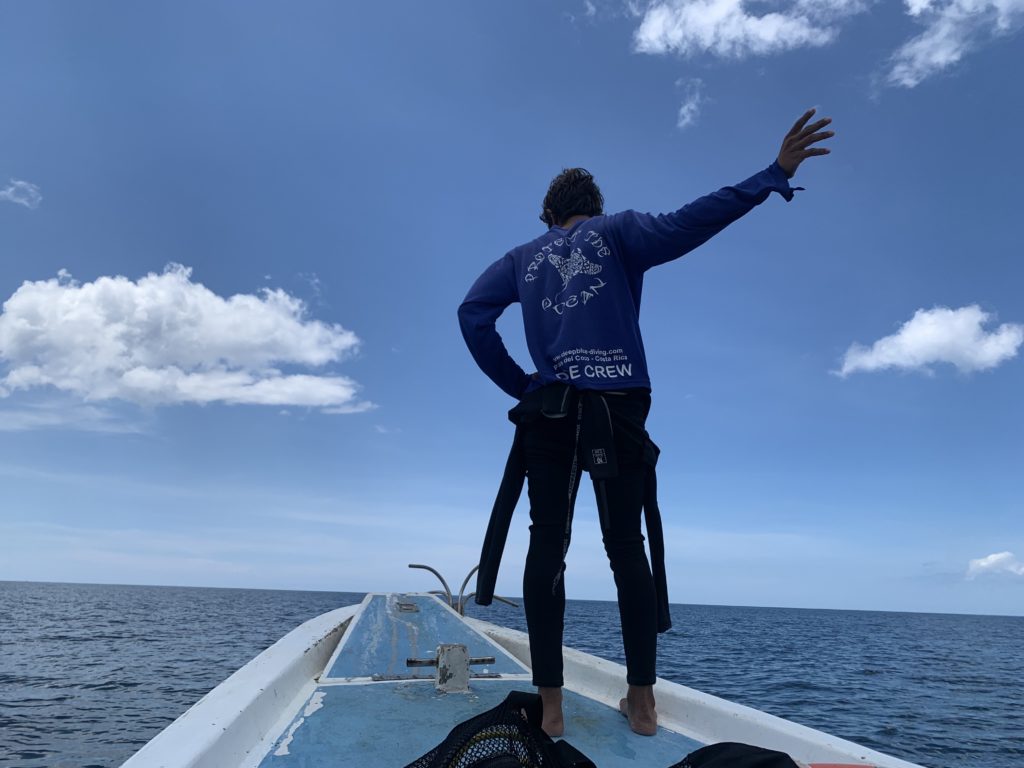
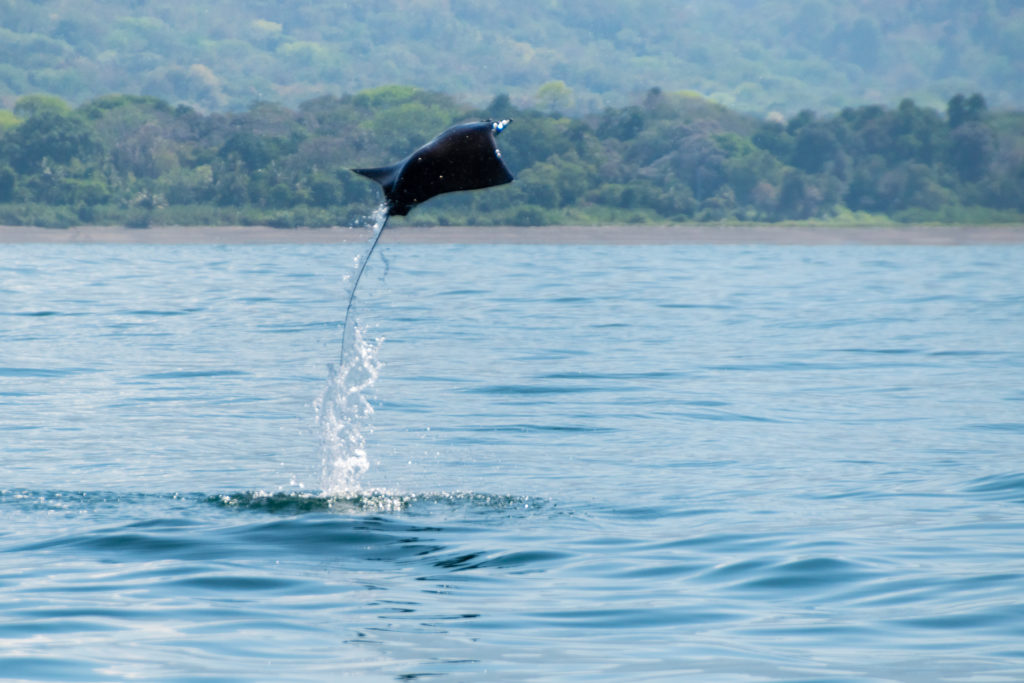
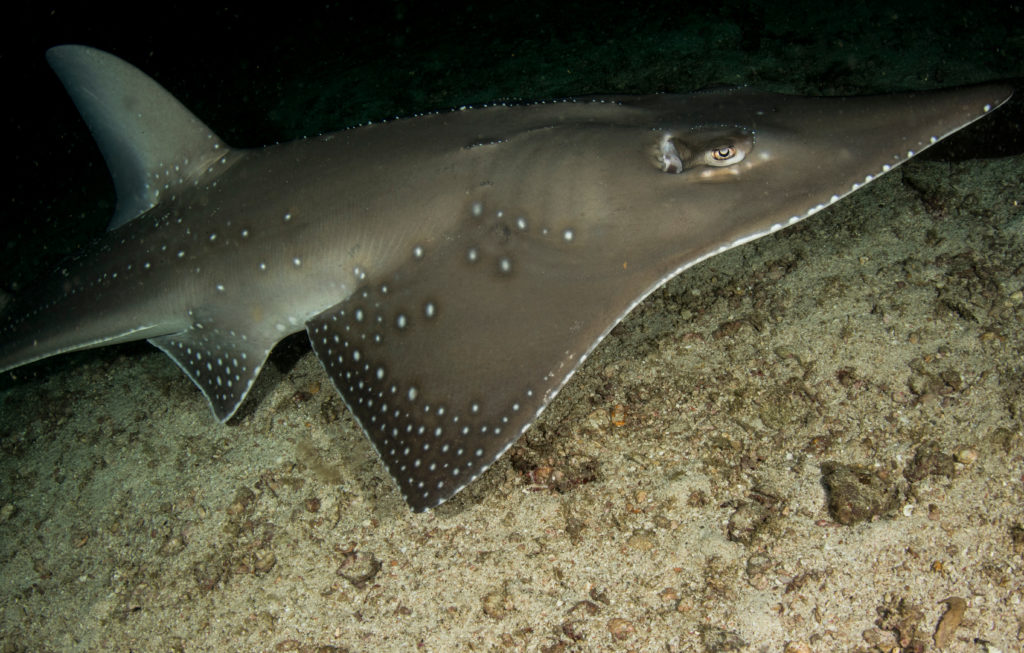
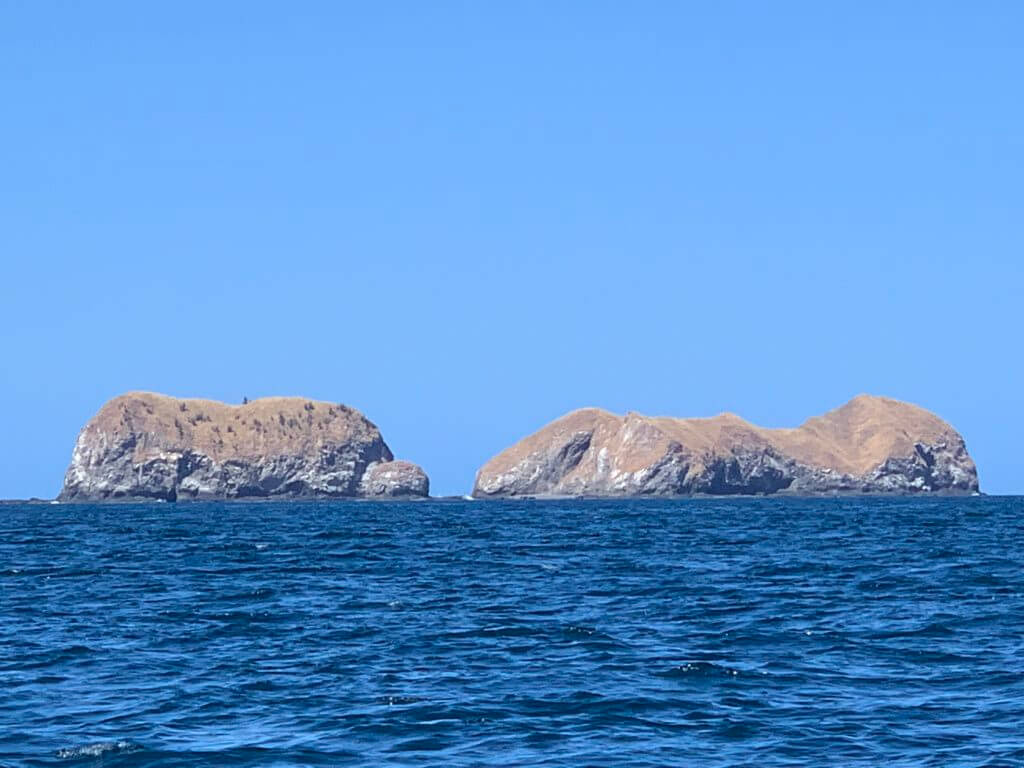
^Above Video: First we see a small Costa Rican Round Stingray, followed by an extremely graceful Eagle Ray (with the white spots) scanning the seafloor for prey and then a bottom dwelling Southern Stingray. Filmed with the Paralenz Vaquita.
By the end of November, 6 of the 12 months I would spend in Central America had already passed and yet the real adventure hadn’t really begun.
I’d spent much of my time experimenting with the Paralenz Vaquita; brainstorming new ideas for Diving Squad and updating old content whilst also admittedly partying most intensely during my Jaco visits.
Eager to enhance and expand Diving Squad, I made down south along Costa Rica’s Pacific coast; all the way to Drake Bay which sits on the country’s Osa peninsular, close to Costa Rica’s border with Panama.
Drake Bay is much harder to reach than Playa del Coco; without a 4 x 4, you must complete the last leg of the journey on a boat that tears down a twisting, allegedly crocodile-riddled river and when you finally arrive, you jump out and into the sea which goes up to your waist before wading across to Drake Bay.
Drake Bay village is a handful of half a dozen or so restaurant-bars and basic accommodation; power cuts are frequent, there’s no ATM’s and in a mere fifteen minutes of brisk walking inland you can have left the small cluster of buildings nestled around the bay and found yourself walking through pristine rainforest.
The reason I made so much effort to reach Drake Bay it’s the closest place to Isla del Cano which lies just 10km off-land away.
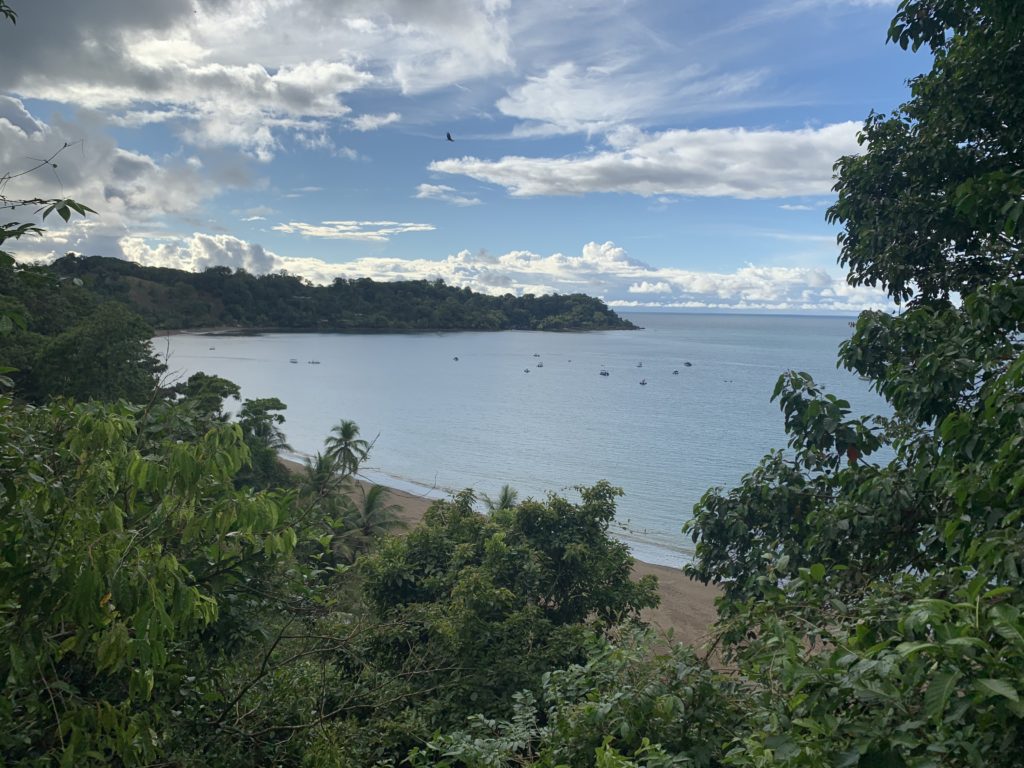
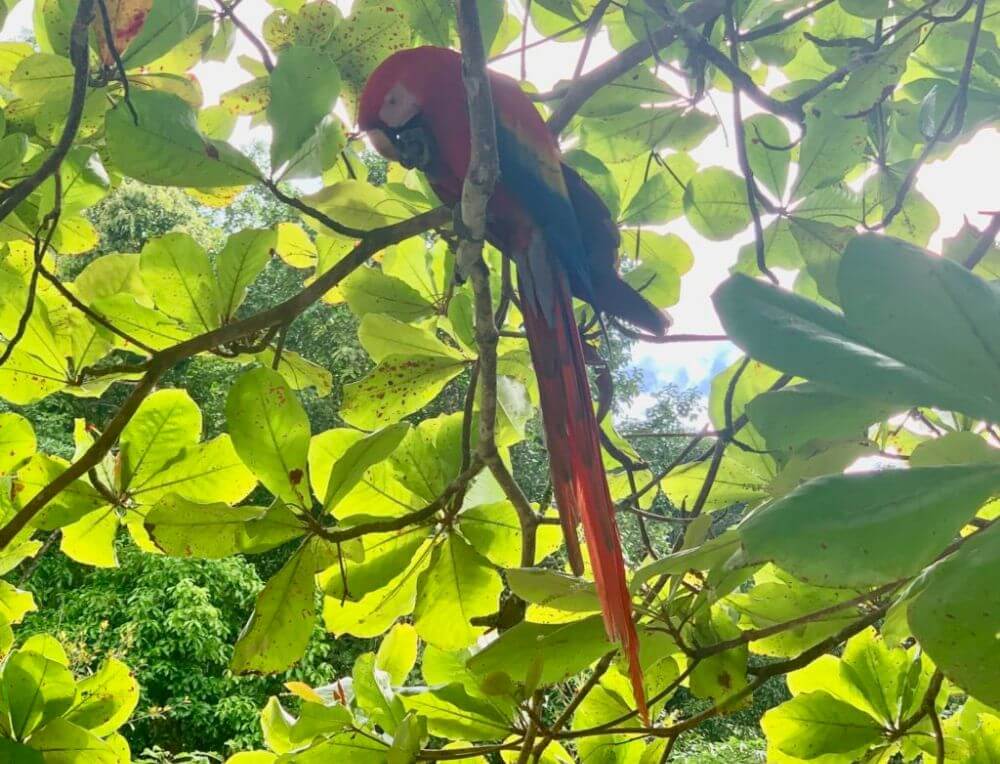
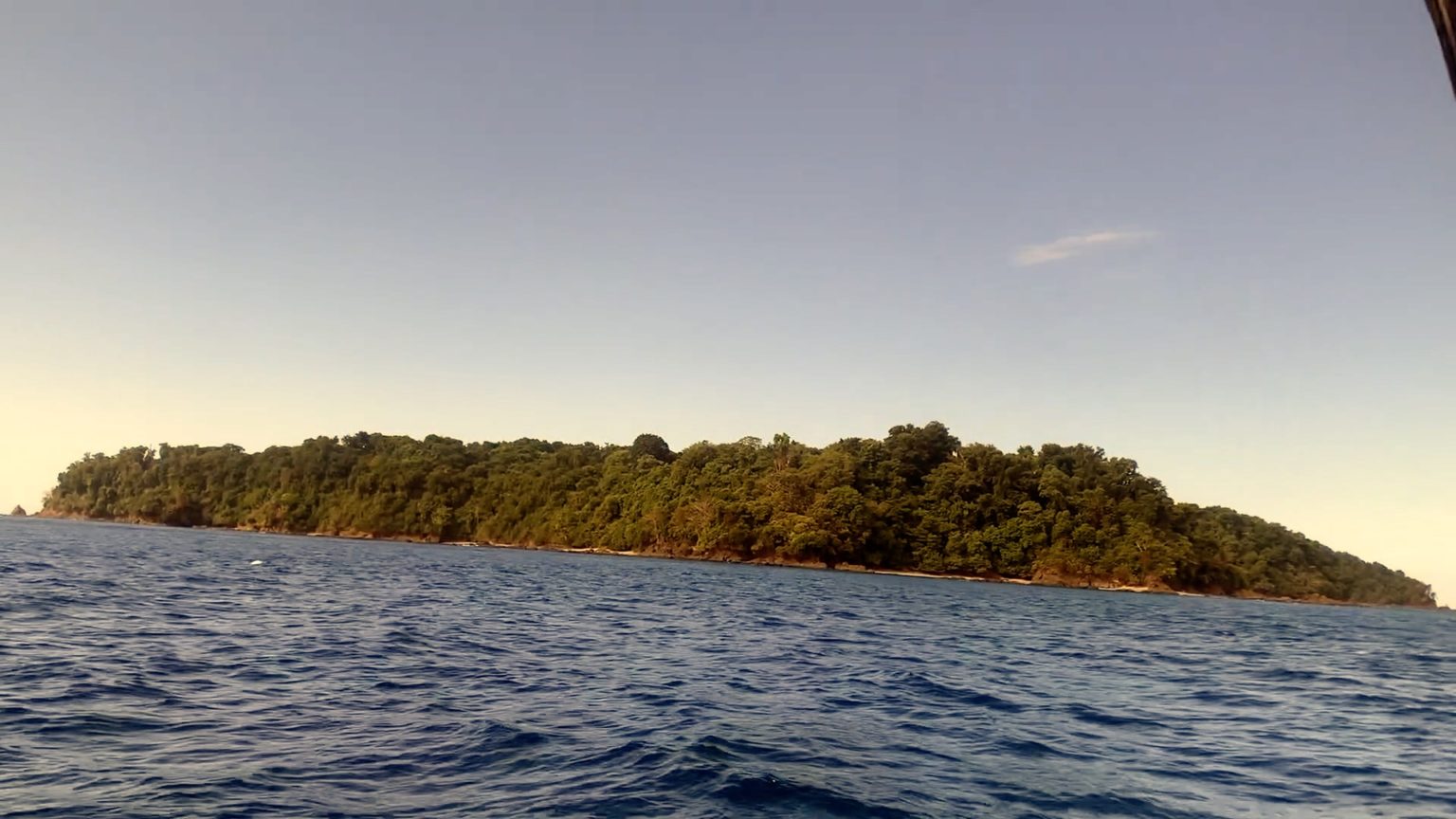
In Pre-Colombian times, Isla del Cano was used to grow medicinal trees and as a hospital location by indigenous communities where people could heal and recover from sickness.
(It also served as a graveyard; which must have been a little disconcerting when your village elder sent you there to either get better or get buried).
If you’ve ever heard of the ancient stone spheres of Costa Rica, Isla del Cano is where most of them were originally found!
(Although many have since been stolen away; you can even see some in San Jose, the countries capital).
Now the island is a Biological Reserve with some of the strictest protective-regulations in Costa Rica. The first time I went, we weren’t even allowed to step off of the boat onto Cano Island’s beach.
The few people allowed to stay on the 3.2 km squared island are all hardcore scientists; and only they can explore the entirety of its many surrounding dive sites, where they study the effects of coral death and recolonisation.
Just five of these dive sites are open to the public but after hearing how Isla del Cano is a Mission Blue Hope Spot; home to the last big remaining reef on Costa Rica’s Pacific side, I wanted to check it out!
The first time I went this was during November; during the height of rainy season which meant a lot of torrential downpours, grey days and murky waters!
Nonetheless, I was extremely impressed by what I saw on those dives.
The combination of crimson coloured sponges, soft yellow sun corals and thick plates of purple lobe coral draped over several towering pinnacles, boulders and underwater canyons was visually stunning.
Amidst these main species there were also branches of grey staghorn coral, white leaf coral and many orange sea fans that waved to and fro’ in the current.
In addition to the reef, there were a great deal many fish, turtles and white tip reef sharks plus from the boat we saw jumping bottlenose dolphins and a humpback whale surfacing!
As I’d done at Playa del Coco, I used my iPhone with a gimble to shoot the boat scenes and my Paralenz Vaquita to catch the underwater footage for the second (and in my opinion the weakest) movie of Diving Squad in Central America:
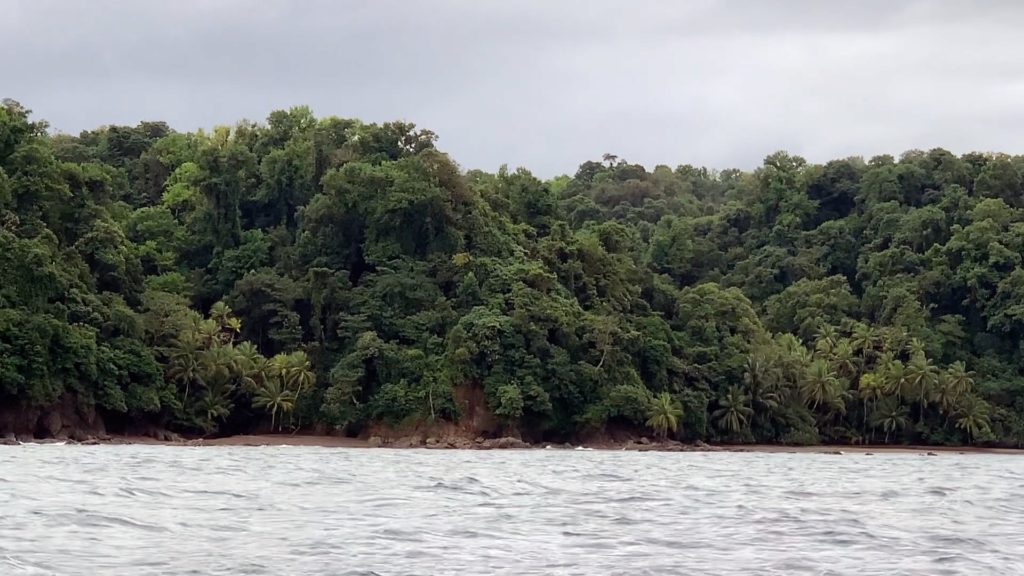
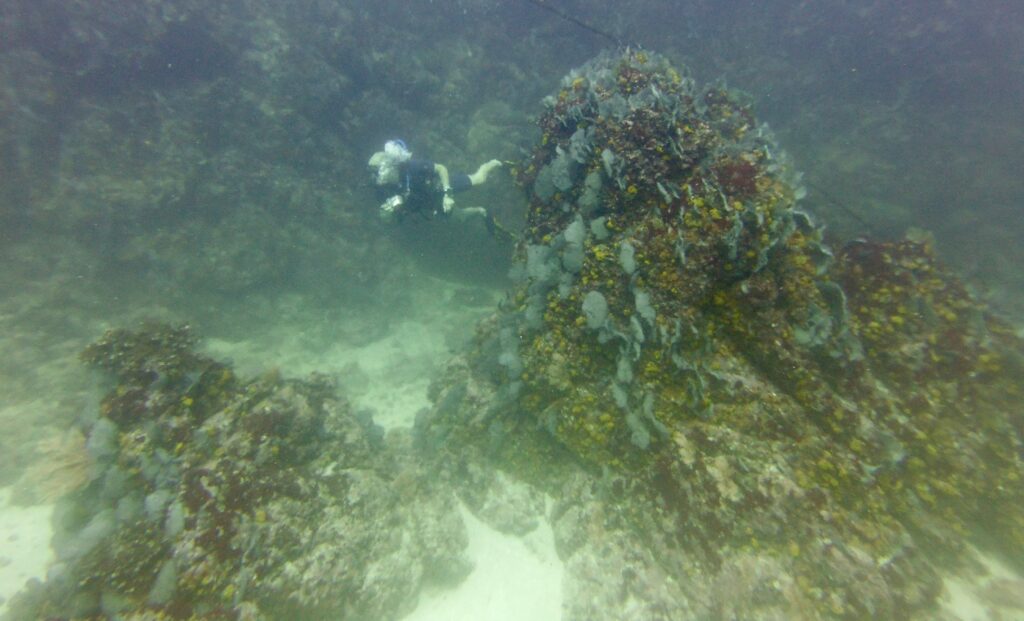
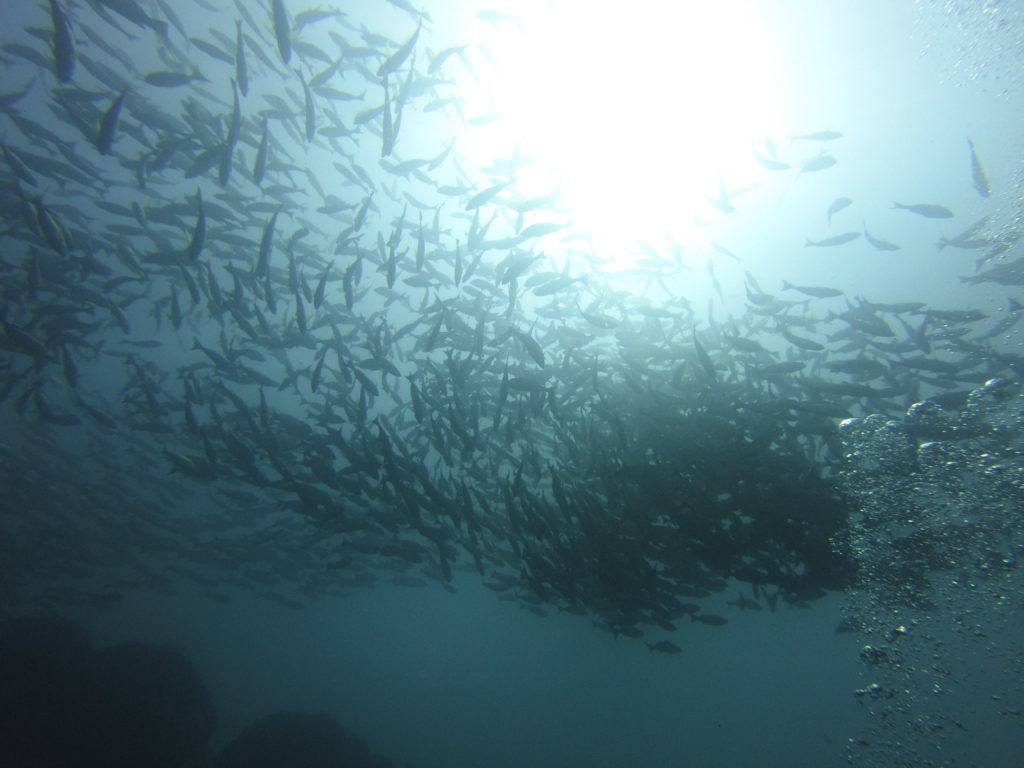
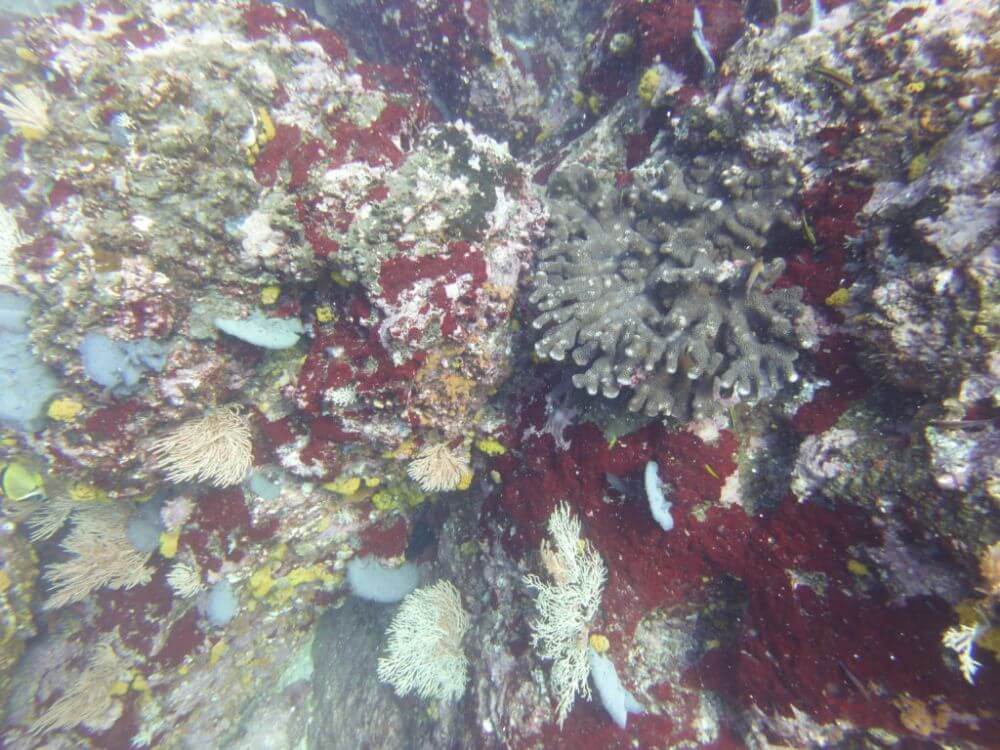
So what did I learn from making ^this movie?
- It was still too long! One of the reason for this was the boat scenes. Although fun to to do; filming on the boat took a lot of energy: what with calibrating my phone and gimble together whilst trying to also keep both dry on a bumpy boat journey, asking people’s permission to film them, etc. I also soon realised that once you’ve filmed one backroll entry, you’ve filmed them all! This was the last time I filmed on the boat in Central America.
- As you can see – once more I had an issue with murky water reducing water visibility and overall picture quality. This was during rainy season so a lot of river sediment from rivers coming out of the close-by mainland, whilst yet more sediment on the immediate seabed was being stirred up by strong currents.
- You may notice that in this movie there’s a lot of long distance shots of diver’s against the underwater landscape: coming round the sides of coral walls, venturing through canyons, seen from behind ridges, etc. Because noone was stopping and starting for me, I was swimming off ahead and to the side of the group to get these long shots. This used up a fair bit of energy and my air consumption wasn’t great! If I’d had an underwater scooter that could’ve made things a lot easier although it may well have scared off the marine life; understandably pissing people off…
After eight dives around Isla del Cano, I made a day trek through the outskirts of nearby Corcovado National Park; reputedly the very best of all of Costa Rica’s rainforest reserves.
There I saw monkeys, coatis, snakes, eagles and tapirs but photographed none because I wanted a break from seeing nature through a camera lens. Then it was time to leave.
In the beginning of December I headed back up north, first to Jaco and then to San Jose where I had was planning to buy a very special piece of equipment for future Diving Squad missions indeed.
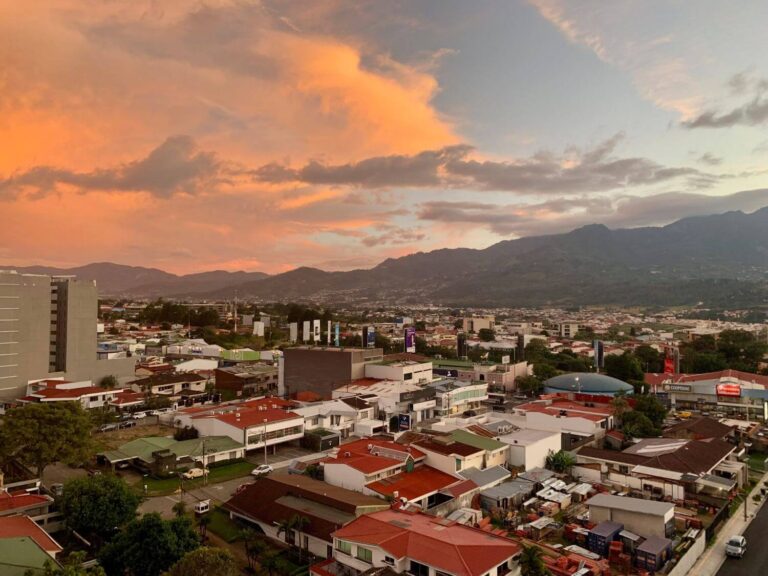
Up until this point, I’d been getting around Costa Rica via a combination of busing it, taxis and hitching a ride in the car owned by Jaco’s Buena Nota hostel owner: one Mr.William Charles Dickey – or as I for some reason called him: Billbro Baggains; a most righteous dude and all-round cool guy!
The thing was that my good chum Billbro wasn’t always free; he had his fine establishment to run and when he couldn’t chauffeur me to my designation it was a pain in the arse to get the bus: it especially put me ill at ease having to load my expensive scuba diving gear into the bottom of the bus where it seemed most steal-able.
And so, knowing that I had yet more places to visit and how many of them were harder to reach than those I’d thus far explored, I chose to resolve my transportation issues by buying the cheapest car I could possibly find and transforming it into a Diving-Squad-mobile.
So here’s what went down: I met a dude called Gerardo that sold all kinds of automobiles and he sold to me a red Geo Metro; a 1996 model it was only four years younger than me, making it twenty six years old! I named my steed of the road: Senor Carro (which translates to Mr. Car):
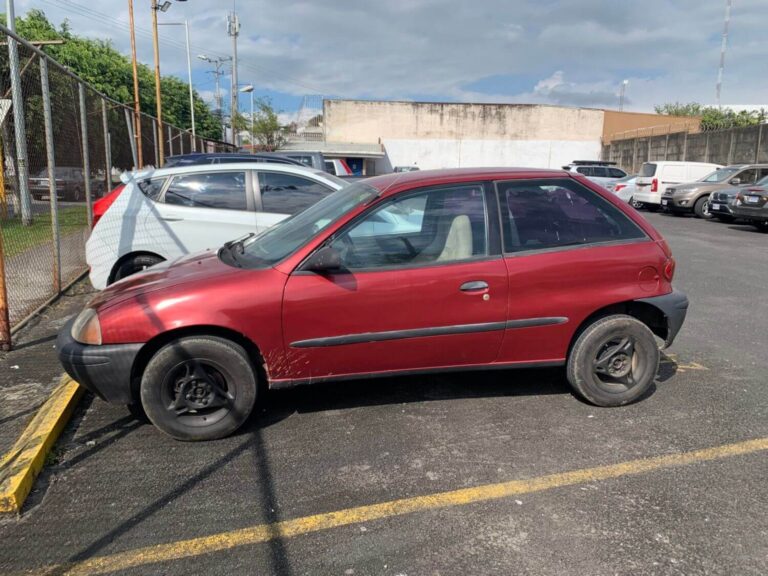
At first there was a lot of work to be done on Senor Carro; the clutch needed replacing, one of the windows didn’t wind up properly, the AC was broken and most importantly of all there was no sound!
After addressing all of the other issues, I had four speakers installed in Senor Carro along with a bluetooth radio transmitter to connect my iphone to.
(Soon, all of Costa Rica would come to know Infected Mushroom).
And then it was time. My first mission with Senor. Carro was to drive it 220km from San Jose to Puerto Viejo in Limon province on Costa Rica’s Caribbean coast.
Whereas I’d so far only scuba dived on Costa Rica’s Pacific side; characterised by deep dives with sharks, rays and big pelagic fish, Puerto Viejo was supposed to be the place to explore the shallow and abundant coral reefs that define the country’s Caribbean waters.
And so; in the last week of December 2021, I made the journey with my at-the-time Costa Rican girlfriend; who performed a bang up job as navigator, translator and all-round awesome co-pilot.
We made the last two hours of the journey in darkness; which was incredibly stressful due to the fact that only then did I discover that Senor Carro’s headlights didn’t actually work and it was also pouring with rain reducing my visibility of the road to about 5 feet; except for when I was blinded completely by the dazzling headlights of traffic hurtling towards me.
Only after arriving at our destination, did I realise that the headlights actually did work but had been rewired so that you had to activate them by stamping down on a switch by the clutch that I’d missed.
At any rate, we arrived unscathed and several days later found ourselves celebrating Christmas Day.
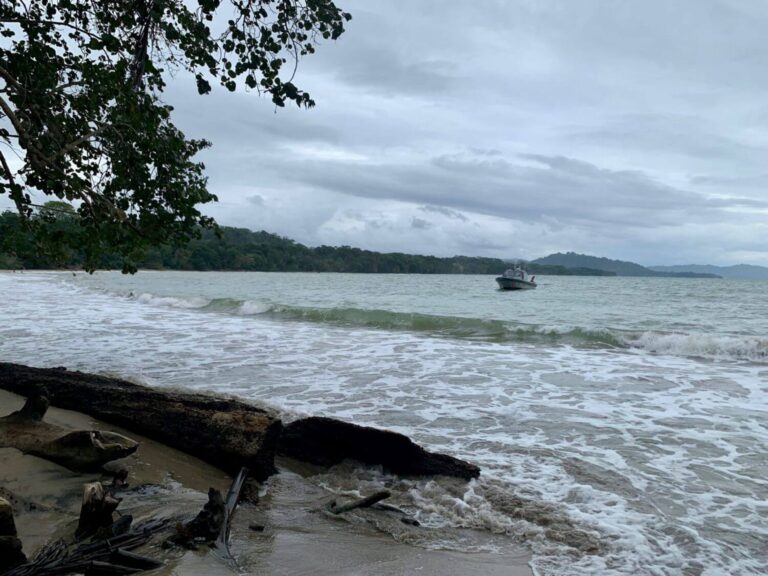
Over the previous weeks I’d been so busy with finding, buying, signing legal papers for and doing up Senor. Carro that I hadn’t properly researched Puerto Viejo meaning I didn’t know that the region is subject to unpredictable currents meaning it can only be dived for a couple of months each year. Which were September – November…not December!
So I didn’t get to scuba dive there and shortly after arriving back in San Jose; I fell ill for weeks. Fortunately for me, I was extremely lucky to be very well looked after by my girlfriend and slowly I started to recover.
At the end of January, I headed back up to Playa del Coco this time in the hopes of seeing Manta Rays at the Catalina Islands, which I’d already tried to visit in July and October with no luck so far.
Amazingly, the red algae bloom that had been present in October was still there; once more I saw nothing on the dives due to excessively cloudy water and this time as I walked along the beach; it’s black sands was littered with the corpses of hundreds of Porcupine fish that had suffocated in the dense algae-chocked waters.
Locals told me that algae blooms had never occurred to such an extreme in the past but were now happening more frequently due to human activity; some mused it was because of rising sea temperatures; others that it was from excess sewage chemicals drifting down from Nicaragua and providing food for the red algae.
Besides a few white tip reef sharks, eagle rays and some big schools of fish; all through extremely cloudy waters, we didn’t really see anything, I got no useable footage and no new experience to write about.
However, we could hear humpback whales singing close by on most dives; they could have been less than ten meters away and we wouldn’t have been able to see them. The eerily beautiful sounds were so close they sometimes made the cloudy water vibrate. I wandered if the whales were singing about not being able to see shit.
This was the second time in a row I’d made a trip up to Playa del Coco and forked out a load of money on accommodation and scuba diving and hardly get any photos, videos or experiences I could use for Diving Squad.
It was extremely depressing to walk amidst what was probably thousands of dead, dried up fish on the beach of Playa del Coco and wander whether people would even still be able to dive there in the future if red algae blooms became so frequent that they choked to death all the local marine life.
At least I got to do an amazing photoshoot around the local dive sites of Playa del Coco with Emanuel from Deep Blue Diving dive centre. Emanuel is a truly awesome underwater photographer / dive instructor and probably the best damn bubble ring blower I’ve ever met.
Check out Emanuel’s instagram of awesome marine photography here!
Any time you see a photo in this chapter of me using the Paralenz Vaquita against a green background – it was taken by Emanuel; he did a bang up job and I’d say both I and the Paralenz shape up pretty good in green murky water!
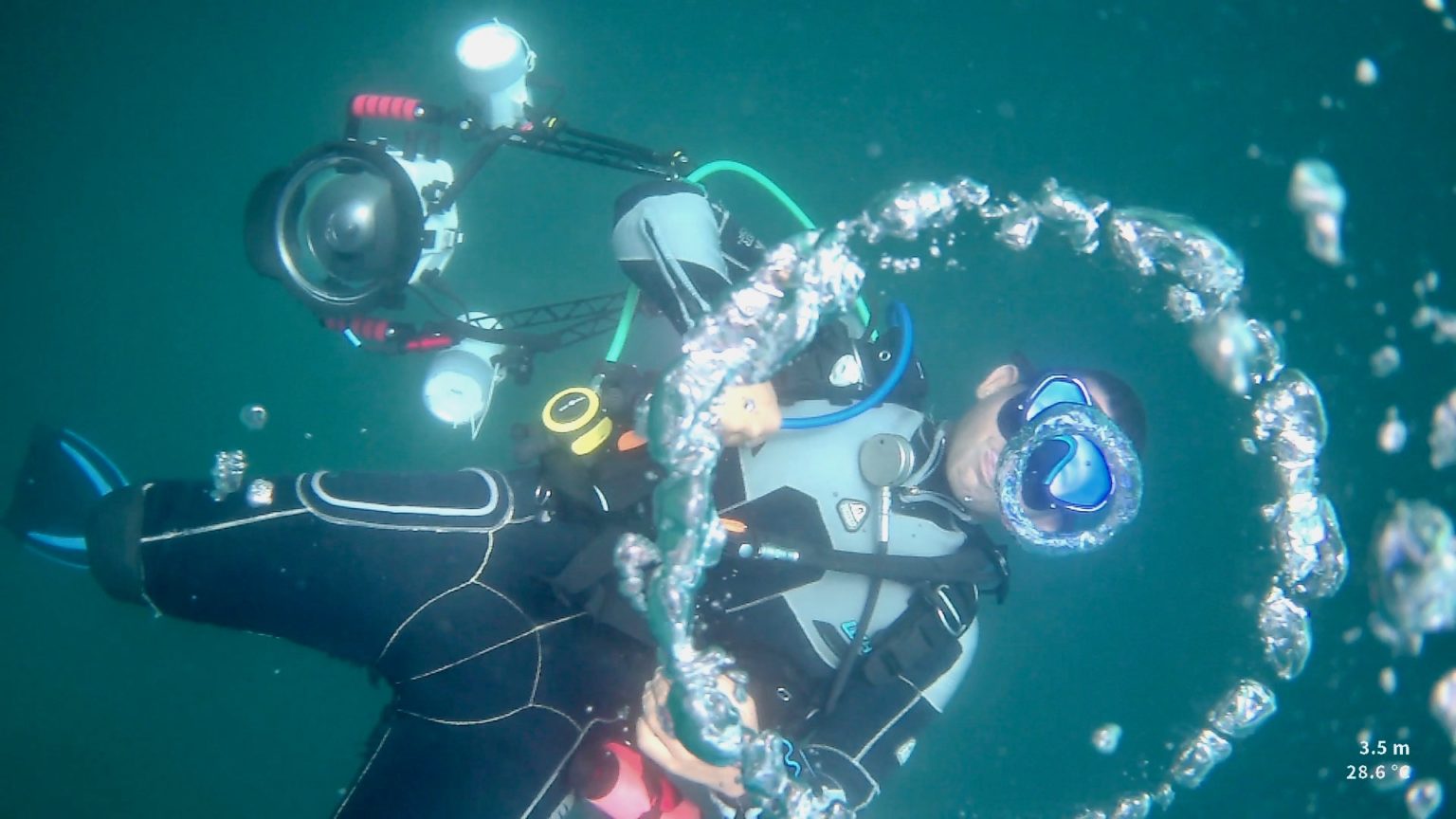
^Above: Emauel takes a break from being a kickass underwater photographer to blow some kickass bubble rings.
Also I got to share the Catalina Islands letdown experience with an other awesome scuba diving instructor; this one a dude I’d met at a Jaco party: Simona from Italy: dive instructor, travel-tour operator and owner of this badass travel blog.
Simona and I made the most of our cloudy-as-fuck dives; with numerous games of underwater-rock-paper-scissors and trying to creep up on eachother through the murky waters.
When I left Playa del Coco at the start of February and drove Senor. Carro back to San Jose; twas Simona who came with me in the Diving-Squad-mobile as co-pilot.
Maybe it was because we truly hammered down those 243km of road…
…(…at one point Simona informed me that according to his phone map app we were travelling at 140km an hour, which was fascinating to me as due to the fact that the speed gauge of Senor. Carro was forever broken; the needle permanently fixed at 0 km I never actually knew how fast I was going…)…
… maybe it was because we got lost several times and spent the entire day driving round perhaps overheating the engine or some other car-type thing (which I know next to nothing about); but it was just a few km away from my airbnb in San Jose that Senor. Carro broke down for the first of what would be several occasions.
It was less than twenty minutes before a very dodgy seeming individual strode up to the car and offered to fix it, saying we need only let him sit behind the steering wheel and that he had friends nearby who could help to…
It was awesome news for me that I had Simona; being Italian he could basically understand Spanish (Spanish and Italian are pretty much the same thing right?) so despite the car breaking down on the side of road, we were able to call Gerardo who sent a reliable dude out to us to tow away poor Senor. Carro to a reputable mechanic friend of Gerardo’s.
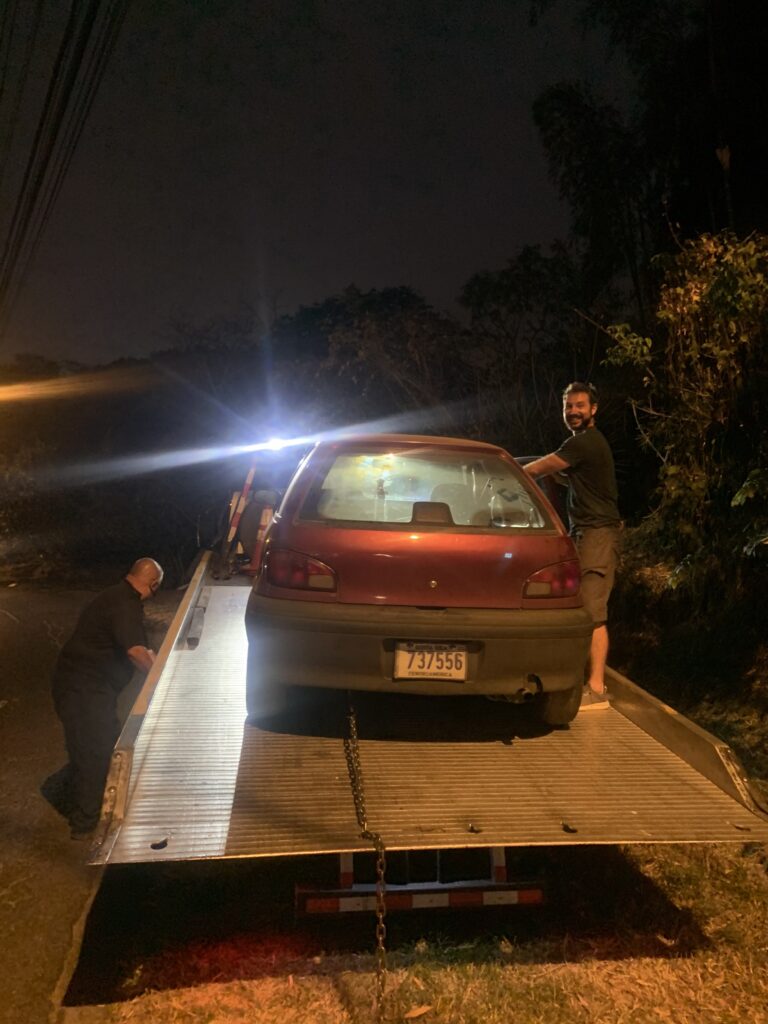
It took 5 days for Senor. Carro to get fixed but I was fine to wait around because I’d gone back to San Jose to spend time with my girlfriend. But then we broke up!
I felt truly miserable for a while; even though we’d only spent six months together, each one of them had been great… but in hindsight, I don’t blame her for her decision and no hard feelings whatsoever. She was an awesome person – and I wasn’t the right guy for her! And as for my own sadness, boo-fucking-hoo! Get over it. On with the show!!
But first:
For over the next month I moped about in Jaco; feeling extremely sorry for myself and partying every night away for weeks-on-end but no longer enjoying it.
I even managed to get into a fight with several large bouncers and after I was thrown out of the club; all 5’7 of me briefly sailing through the air before I crashed to the ground; just like in the movies, the door flew open and out came a belonging of mine – my trainer, which had come off in the scuffle.
It came hurtling towards my black eye-sporting head along with an angry cry of “and take your shoe with you to”!! Luckily I dodged and it banged off a lamppost behind me.
Shortly after, as I sat at the table wide-awake at 7am in the morning with bloodshot eyes and jittery hands; unable to sleep for the somethingth-day in a row, I realised the slippery steepness of the dark spiral down which I was sliding on down and decided it was time to make some changes. Time to get back to new Diving Squad missions! =D
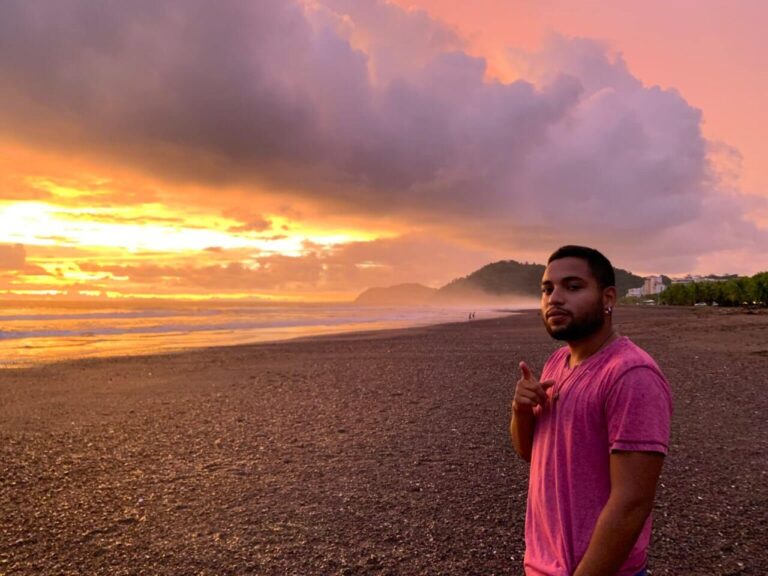
At the end of March (2022), I decided to drive back down towards Drake Bay to dive Isla del Cano again.
There were two reasons for this. Firstly, it was now manta ray season there and secondly I had a new underwater camera to try: the Sealife Micro 3.0!
Up until this point, I’d been using my trusty Paralenz Vaquita, to capture all of the underwater footage you’ve so far been drooling over in this chapter (2).
That’s because when it comes to shooting underwater video: the Paralenz Vaquita can’t be beat!
It’s the only underwater cam that shoots 4K at 60fps; or super slowmo at 240fps (1080p) and also the only one to feature underwater colour correction that automatically adjusts with depth.
That said, whilst the quality of the Vaquita’s videos is simply amazing, it’s not so great at snapping still photos as it only produces them with a fairly feeble 12mp resolution.
Now: there be a couple of other similarly priced and specced underwater cameras for scuba diver’s out there and one is the Sealife Micro 3.0.
The Sealife Micro 3.0 can only shoot 4K video at up to 30fps – that’s decent and the vids look really good but these specs are only half the frame rate of the Vaquita’s 4K at 60fps of which videos are noticeably better.
Also the Sealife Micro 3.0’s underwater colour correction has to be fixed at either shallow or deep.
However, the Sealife Micro 3.0 does have a bigger image sensor at 16mp vs the Paralenz Vaquitas’ 12mp and it also turns on much quicker and has a bigger display in which to see the shots you’re framing.
This makes it much easier to capture high quality photos with.
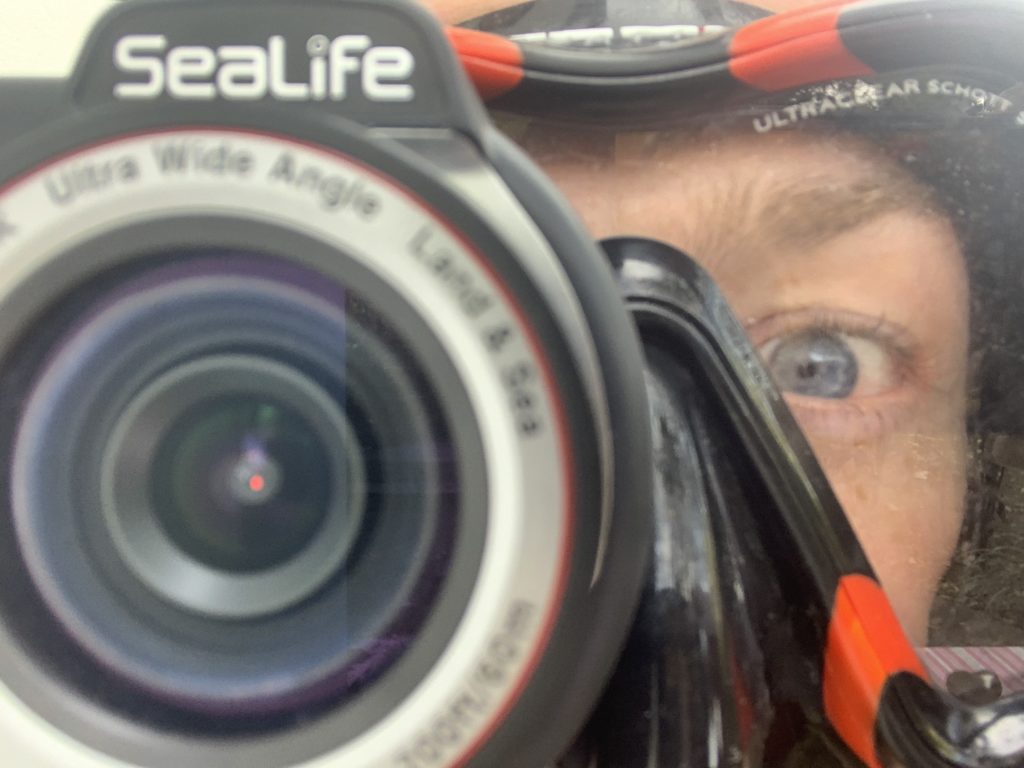
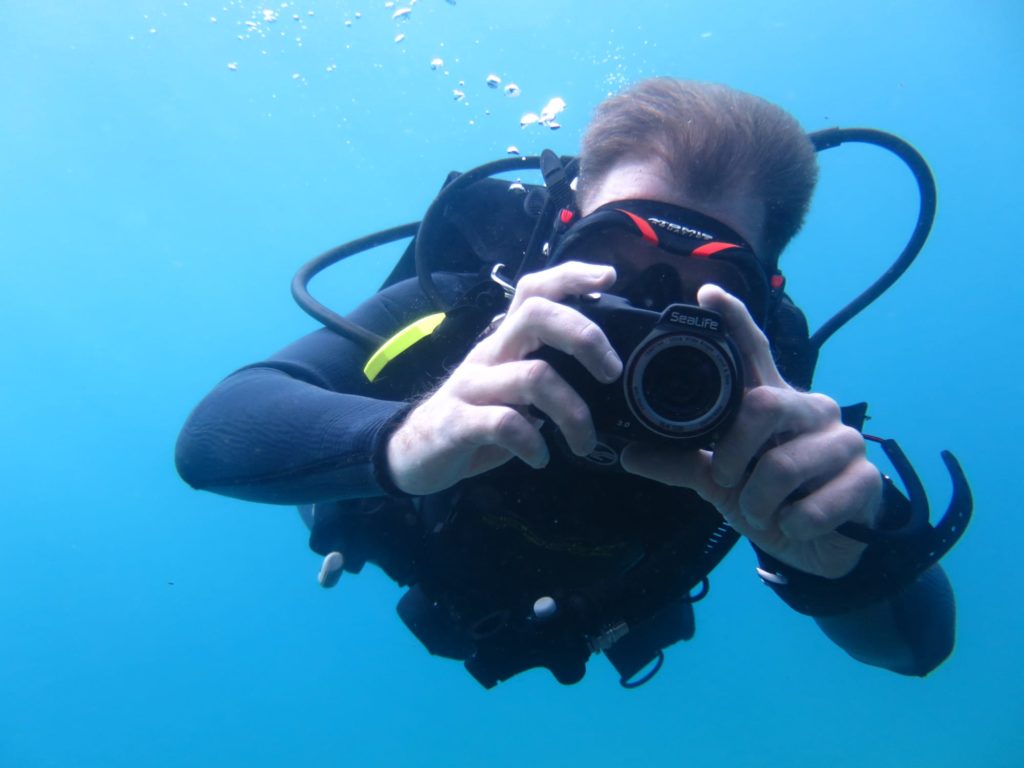
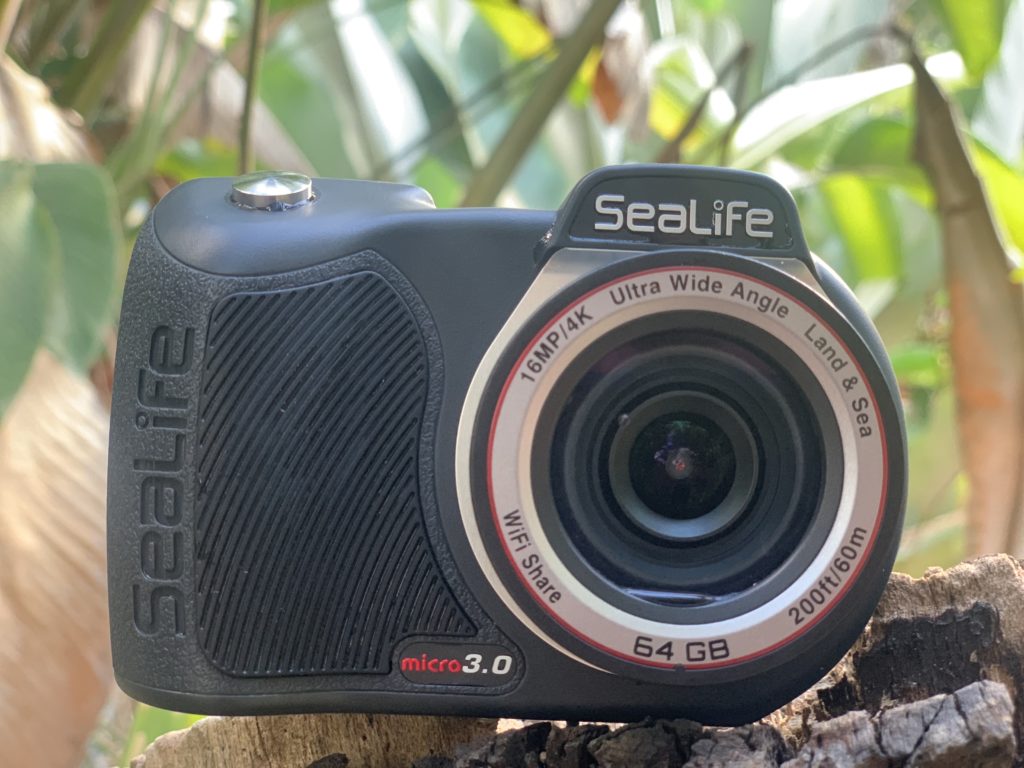
Like this:
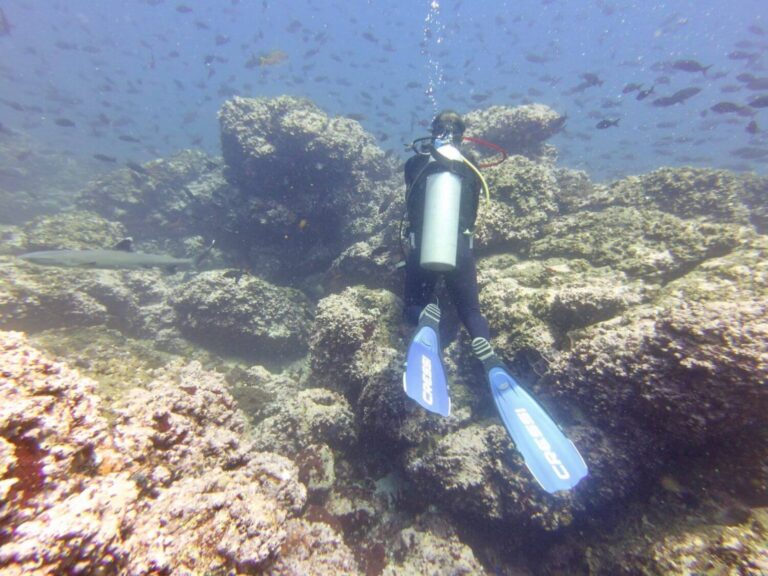
And also THIS:
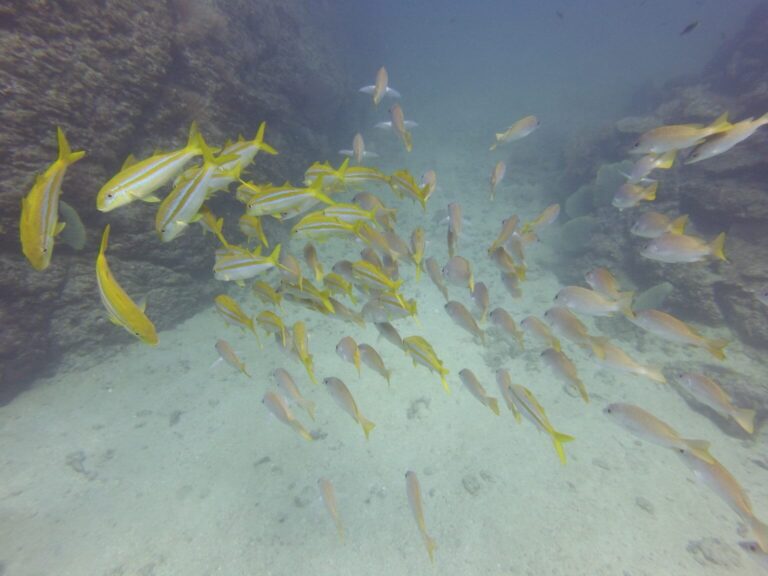
Oh yeah – you liked that!? Then get yourself a little bit of this:
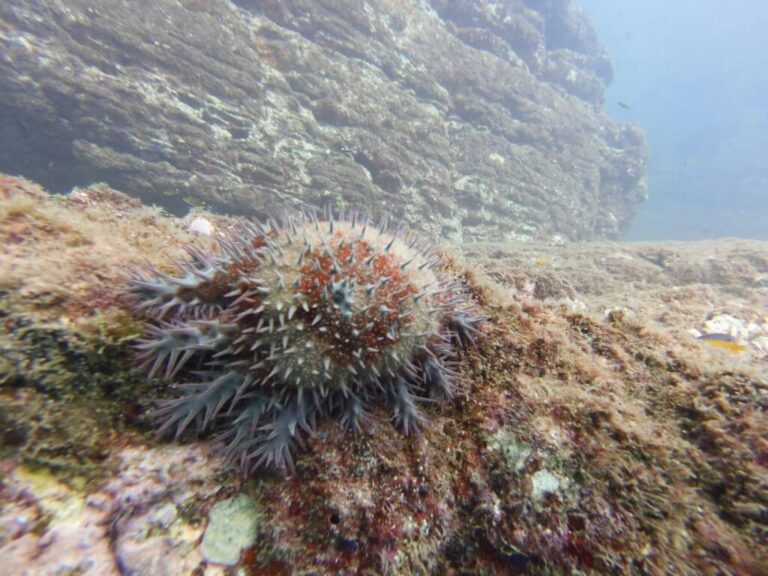
Still want more!? THEN HOW ABOUT SOME OF THIS:
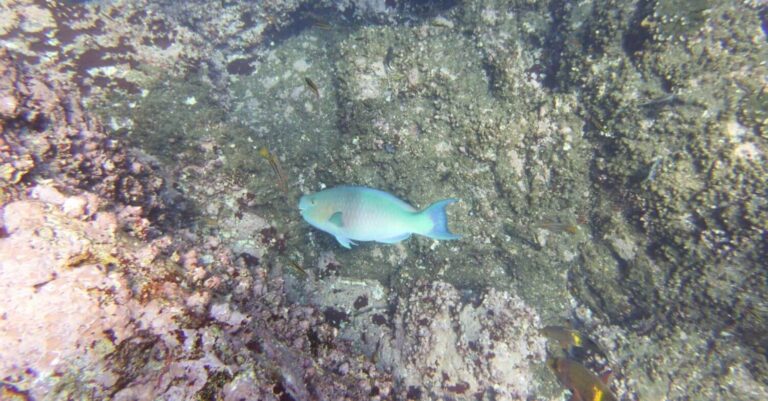
At several hundred dollars below one thousand bucks (a similar price to the Vaquita) the Sealife Micro 3.0 takes excellent quality photos from a range of angles and focuses, which it’s huge display makes easy to frame.
Plus, the Micro 3.0 powers on in just two seconds (vs the Vaquita’s whopping 18 second startup time) and has a longer battery life than the Vaquita.
As you’re about to see, the Sealife Micro 3.0 also takes very decent videos as well.
In this next movie, I filmed my own mug for the first time in one of my diving videos – as Juan; my good friend and Instagram guru told me that this was the missing ingredient in my videos.
I shot all of the underwater parts of this video using my Sealife Micro 3.0 so as you can see it takes great videos as well as photos although I think it’s pretty clear that with regards to underwater video, the Paralenz Vaquita captures the absolute best quality footage.
Nonetheless I was extremely pleased with the Sealife Micro 3.0’s photo-taking abilities, highly satisfied with it’s video and loved how straight-forward it is to use.
As you can see from the video, the water was a hell of a lot clearer due to the fact that it was now dry season. Also, after multiple unsuccessful attempts to see a Manta Ray up at the Catalina Islands; it was down at Isla del Calo that I finally saw a reef manta ray. Check out the full clip of my first manta ray encounter in the America’s below:
What makes manta rays so incredible? A number of things – for starters, they’re the biggest rays in the world!
Reef manta rays can grow to a disc width of up to 18ft (5m) although the reef manta I saw here was probably only around 13 ft (4m) wide.
The other species of manta: oceanic (or giant) manta rays are even bigger; reaching a disc width of up to 29 ft (8.8m)!
Despite their enormous size; these gentle beings mainly feed on plankton – although new evidence shows they also hunt small to medium sized fish.
Manta rays are totally harmless to humans – although they have long tails; unlike stingrays, manta rays tail’s don’t have barbs!
They are highly intelligent beings: having the largest brain to body ratio of any fish and exhibiting long term memory as well as the ability to recognise themselves in the mirror. Some manta rays that’ve become entangled in nets have been observed swimming up to diver’s for help.
These magnificent creatures are also highly social and when interacting with one another they’ve been known to brighten the white markings along their backs.
The markings of each manta ray are totally unique – much like a humans’ fingerprint and are used to tell individuals apart by scientists.
Also, each manta rays has its own personality – some are more social, others highly curious and a few appear to be particularly interested by diver’s.
So it was an honour to see a manta ray – even more so considering that thanks to humans they’re a highly elusive and rare species – some estimates put global local reef manta ray populations at just 1500!!
I also got to spend time with JP; one of the dive instructors at Drake Bay’s Adventure Diver’s.
Pretty much everything I’ve so far told you about Isla del Cano’s ecosystem, I learned from Adventure Diver’s dive instructor JP; he who had a truly insane knowledge of the area and was also bloody good fun to grab a beer with after a dive.
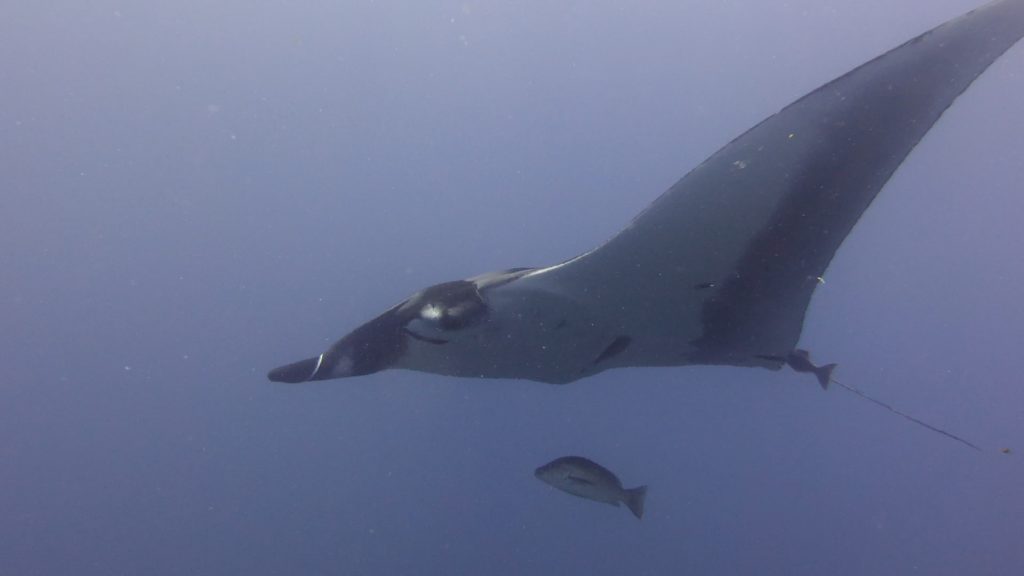
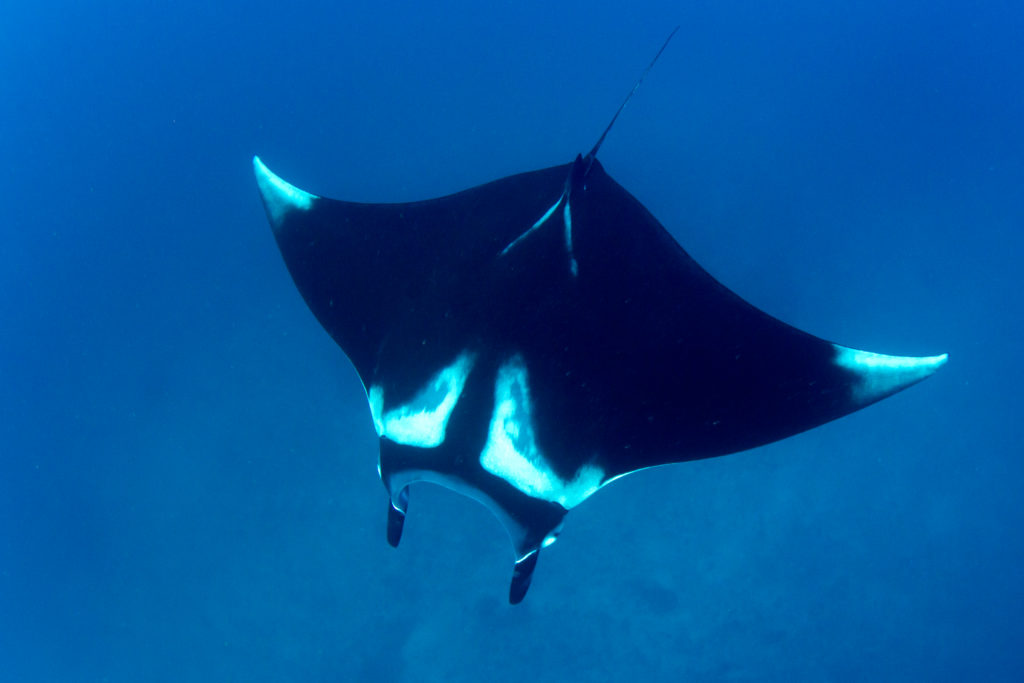
After a couple of weeks diving Isla del Cano, I decided it was time to move on – time to dive somewhere completely new that I hadn’t visited at all yet.
My next scuba diving destination would be… Panama!
On April the 2nd, one day before I planned to drive to Panama; I opened the door to Senor. Carro, climbed inside and turned the ignition key. Nothing happened.
This was the second breakdown event of my little red car.
I’d already paid for my first weeks worth of accommodation in Panama; so wasn’t willing to put off going there for as long as it took the car to get fixed.
Begrudgingly I left Senor. Carro in San Jose with a friend and the next day caught the bus down to Panama.
My first stop was Boquete town; nestled among the mountainous highlands of Chirique province.
It was a tranquil and spectacular looking place. I stayed there for a week; hiking by day and at night sitting under the stars reflecting upon all that’d happened since I’d first landed in Costa Rica nine months ago.
I knew that soon I’d discover what Panama’s diving was like on either side of the mountainous region; first on the Pacific and then the Caribbean; both of which could be seen from Alto de Nique; Panama’s highest mountain which loomed off in the distance, visible from my airbnb.
After seven days at Boquete, I travelled down to the small beachside town of Santa Catalina on Panama’s Pacific Coast.
Once a sleepy fishing village, Santa Catalina now has a rapidly growing backpacker scene thanks to both it’s popularity as a surf destination and it’s proximity to…Coiba Marine Park!
A group of 39 islands, some 14 miles of the Pacific Coast of north-western Panama, the marine park is widely considered to be the best dive destination in all of Panama.
Some scuba diver’s even cite Coiba Marine Park as the best pacific dive destination in all of Central America.
Human activity in the area has always been fairly low; partly due to the fact that up until 2004; the largest of the 39 islands: Coiba was used as a prison.
This combined with the park’s special protection status and its position within the Gulf of Chiriqui which acts as a buffer against El Nino temperature swings, means there’s a thriving marine ecosystem there.
Although it’s possible to make day trips to Coiba Marine Park from Santa Catalina; the distance between the two means you can’t reach Coiba Marine Park’s most remote, north dive sites.
Because of this, I’d signed up for a 2 night trip with lodging at the small fishing village of Pixvae in order to reach those less accessible, more off-the-beaten-track dive sites.
Pixvae lies 30 miles further up the coastline than Santa Catalina; closer to the northern region of Coiba Marine Reserve and has no tourist infrastructure as well as limited supplies.
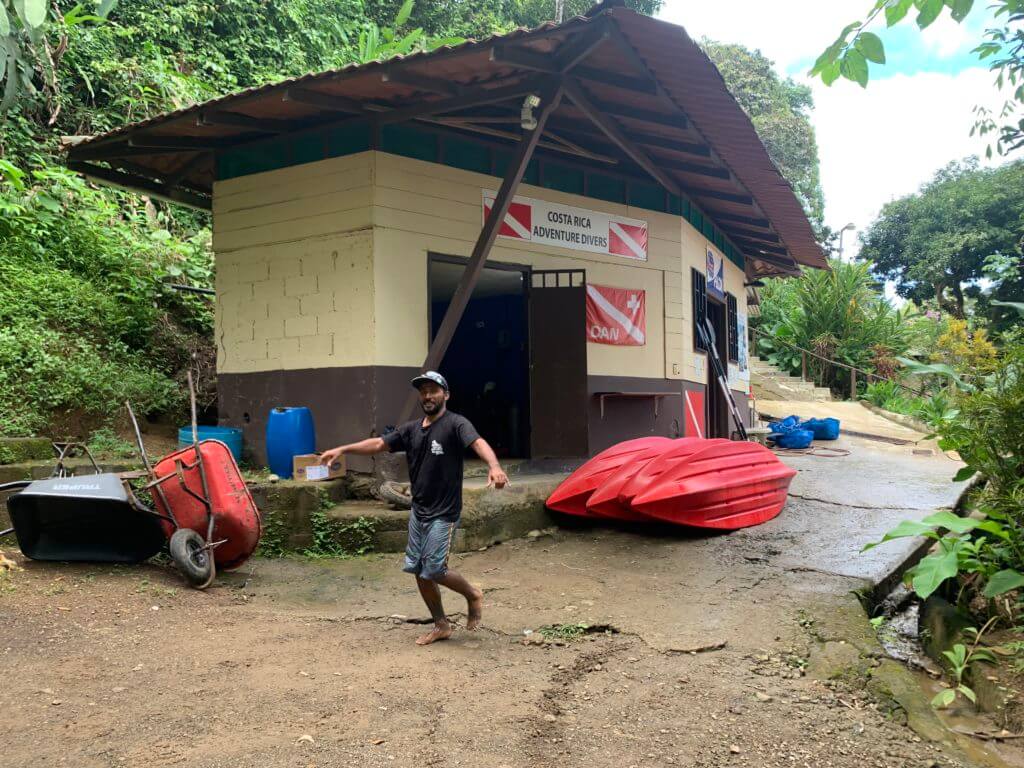
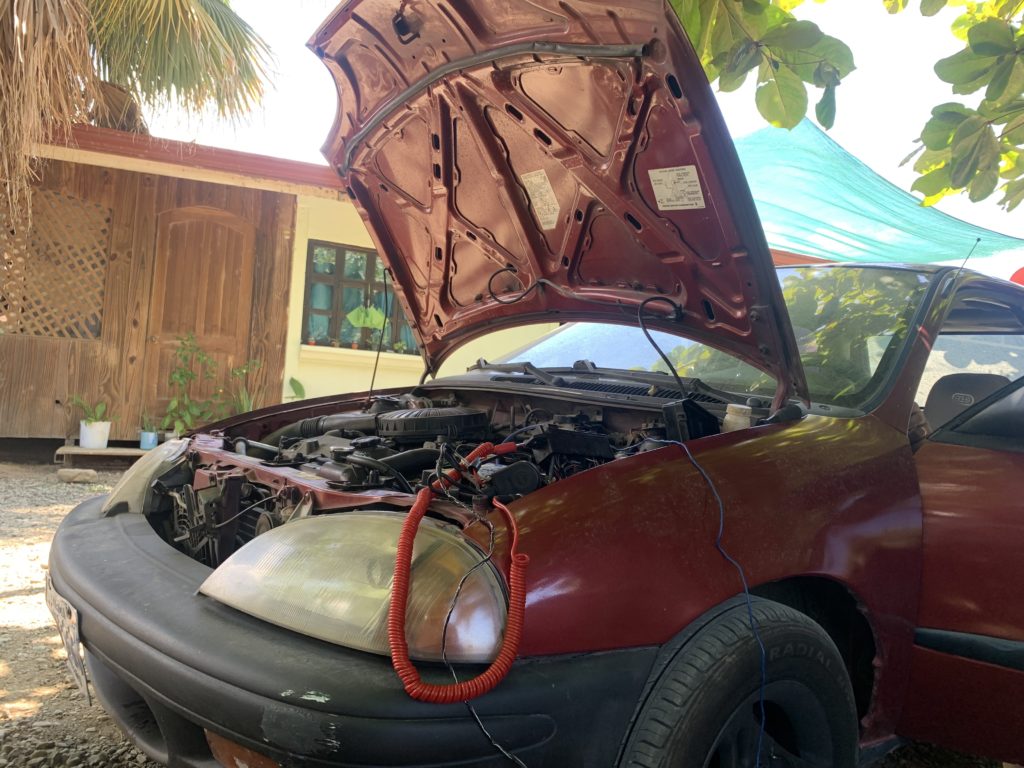
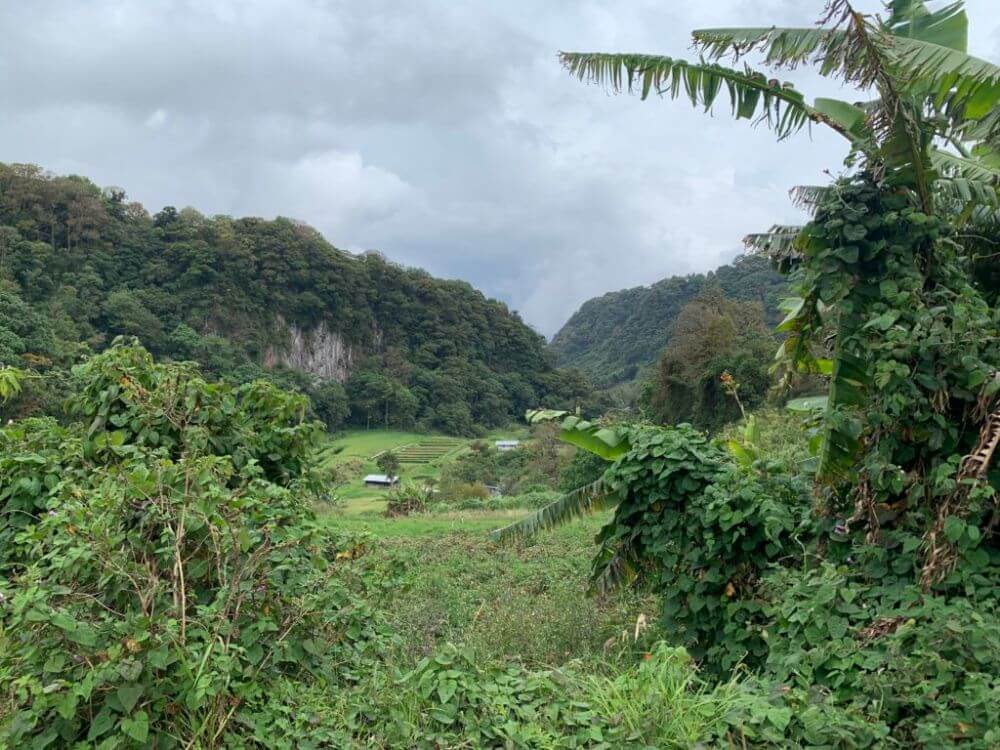
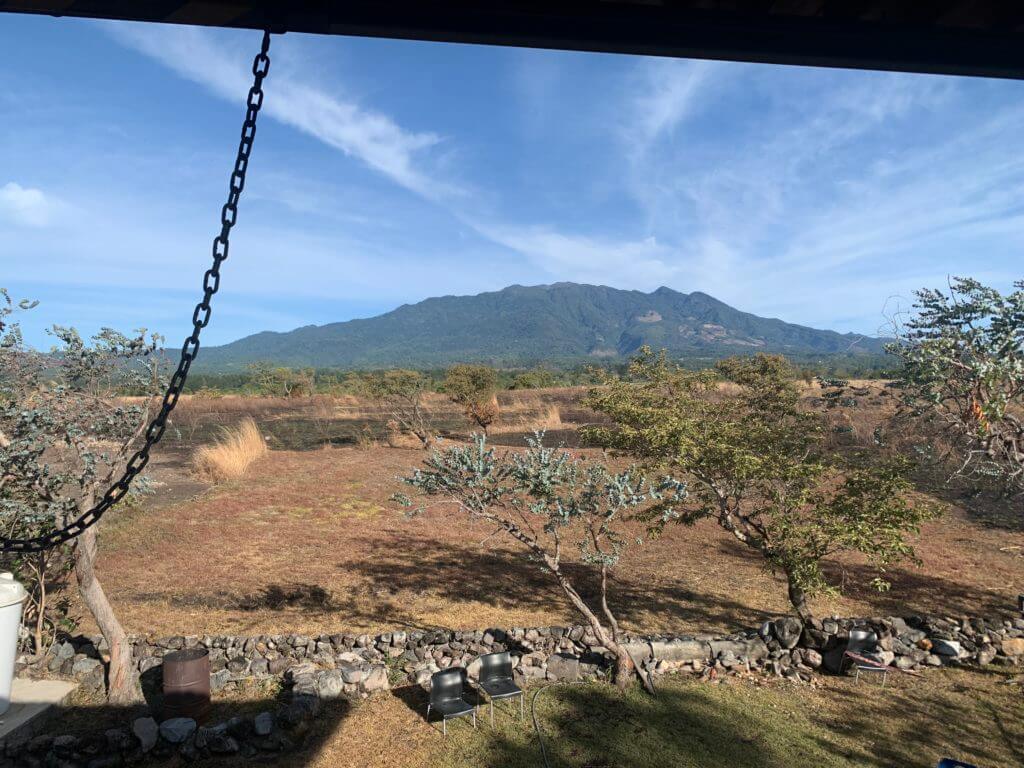
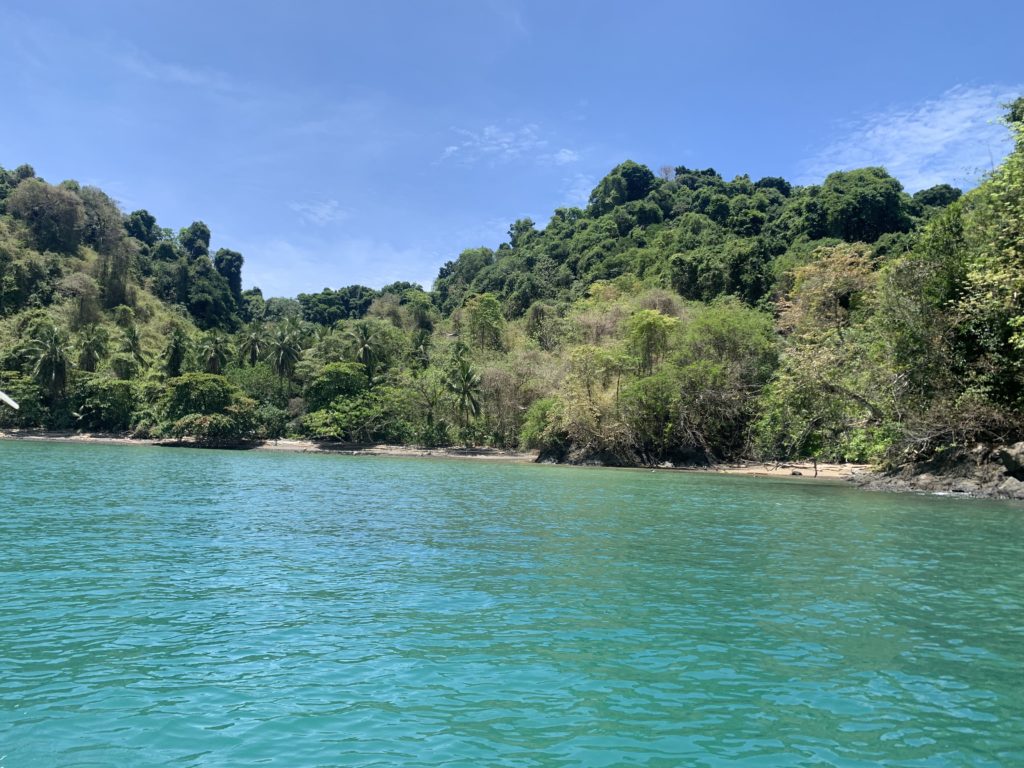
The only dive centre that I could find to offer an overnight diving trip from Pixvae was Scuba Coiba, whom are based in Santa Catalina.
The evening before the trip, I met Cory; one of the dive instructors at Scuba Coiba, where I signed the necessary paper work / away-my-life-if-I died and handed over my dive gear.
Early the next morning, we departed from Santa Catalina to Pixvae via boat.
It was a two hour boat ride and during it I met Laura; a marine biologist and fellow scuba diver from Spain who was heading to Pixvae for the overnight trip as well.
Laura had a real talent with her Canon camera; any time you see a photo of me scuba against a dark blue background in this chapter; it was Laura who took it!
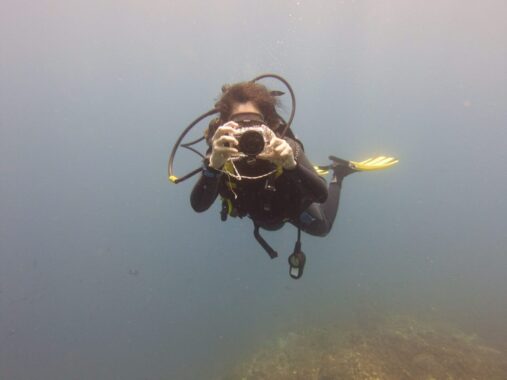
Getting to Pixvae took a couple of hours and on the way we stopped at two of Coiba Marine Park’s more southernly dive sites.
There we saw many divers as that part of Coiba Marine Park (the dive sites directly off Coiba island) was still close enough to Santa Catalina to be reached on half day trips from there.
However, despite the numerous dive boats, the water didn’t feel crowded as there were so many different dive sites for the various scuba diving operators to choose from.
The diving was easy and scenic; we stayed at around 32ft – 49ft (10 – 15m) and mainly saw colourful reef fish amidst some decent hard coral hiding various nudibranch and seahorses.
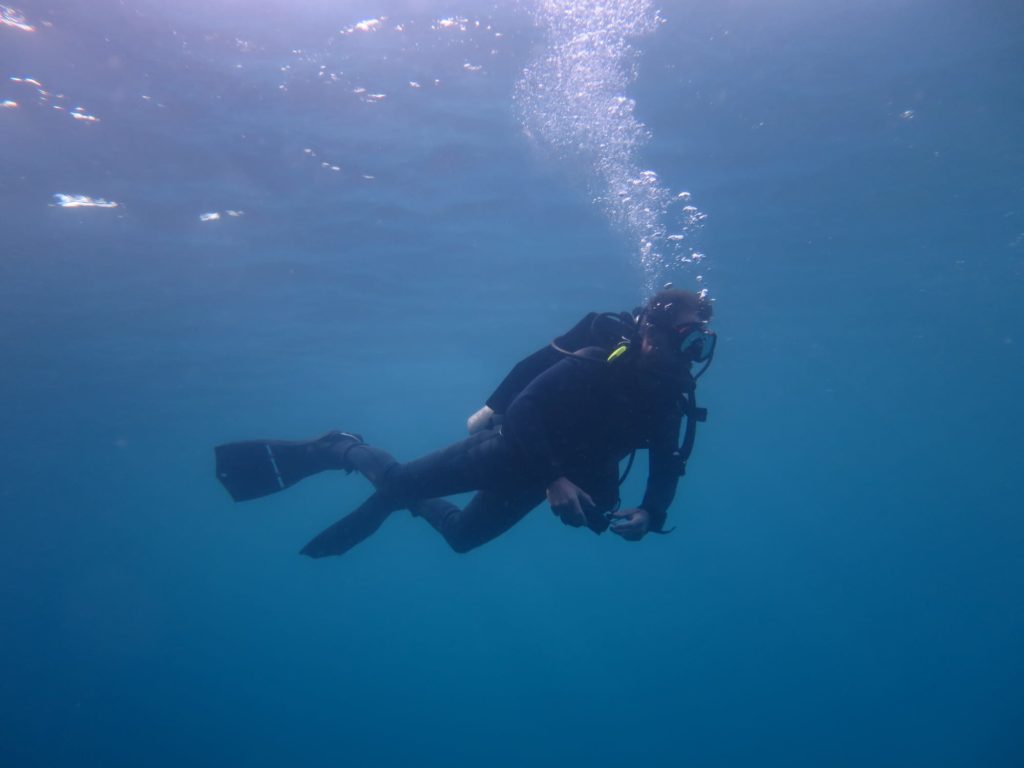
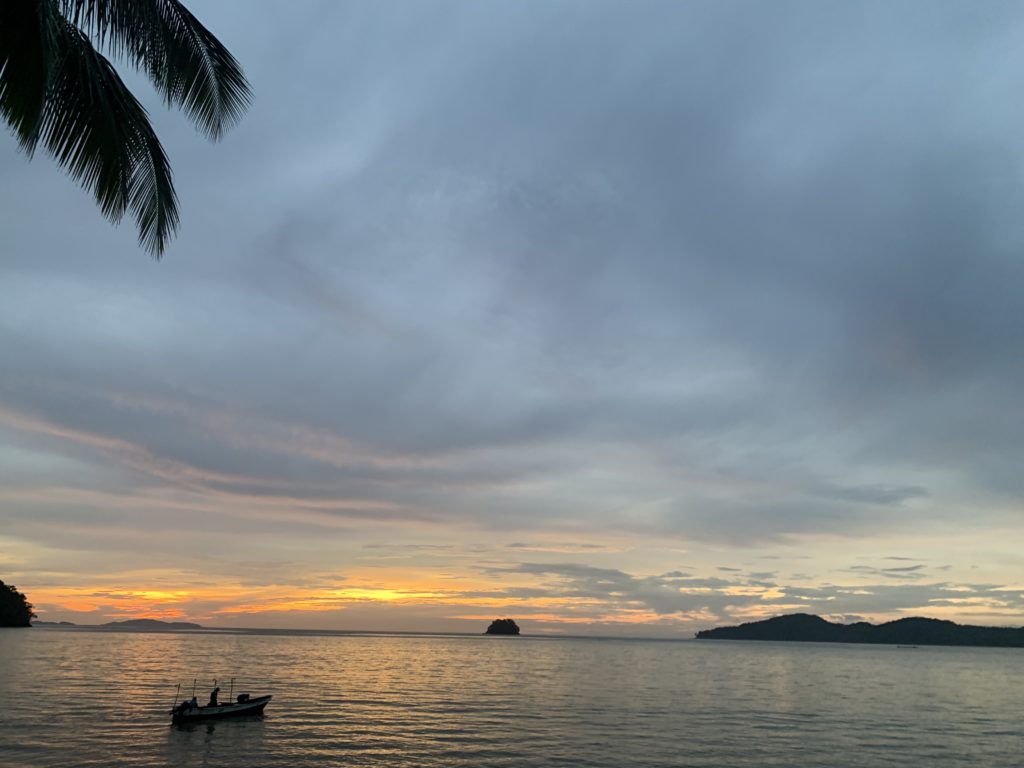
As late afternoon pulled in, the other dive boats turned and headed back to Santa Catalina but ours continued northwards until we finally reached Pixvae.
Pixvae is a tiny fishing village with a population of under one thousand and during my short stay, myself and the half dozen other people on my trip were the only non-residents.
It was a tranquil place, although even here reggaetone had wormed it’s way deep into the community: being perpetually blasted from several houses late into the night.
Nevertheless, the sunset views were spectacular and occasionally a frantic braying of beach dogs was almost loud enough to drown out the reggaetone.
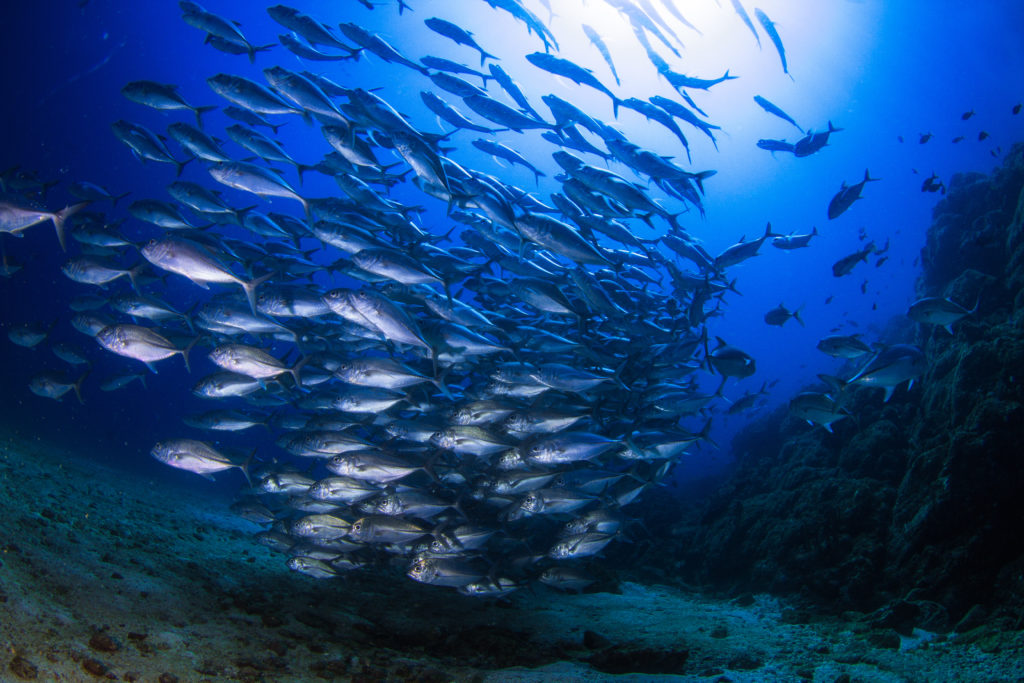
It was over the next two days that we got to discover the most remote northern regions of Coiba Marine Park, diving at sites where not a single other boat was to be seen.
At times the current was strong as we dropped down to 98ft / 30m where spectacular deep soft coral gardens of green and yellow grew.
At shallower depths, there was plenty of hard coral reef, forming several impressive pinnacles, however the main stars of the show were the large pelagic creatures.
I’d never seen such vast schools of pelagic fish before, with huge numbers of big eyed trevally, yellowtail snapper, tuna and batfish on almost every dive.
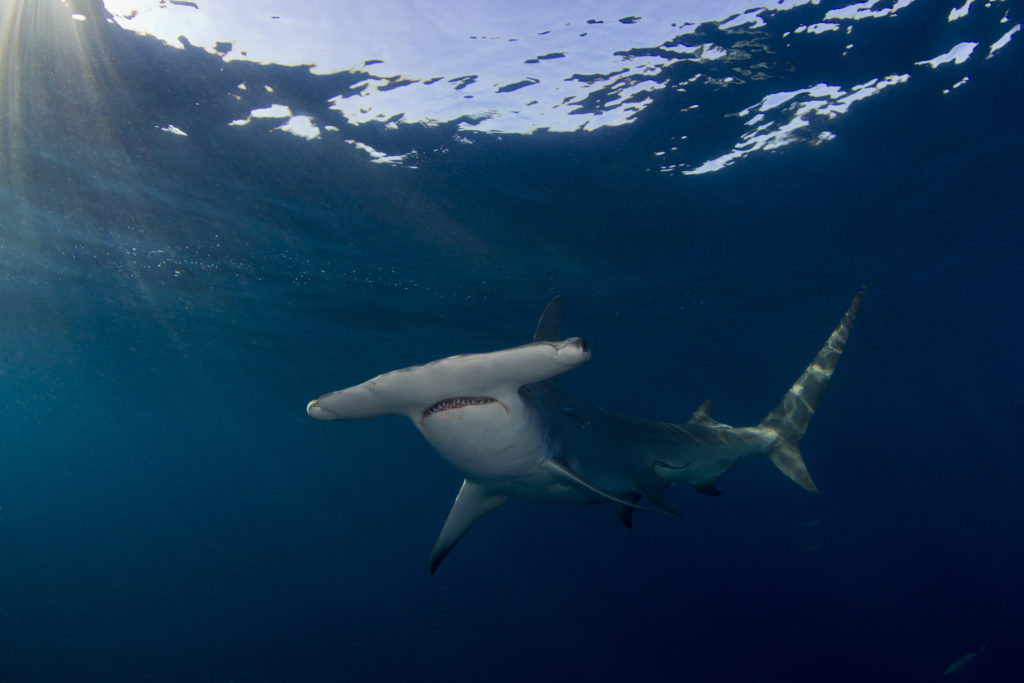
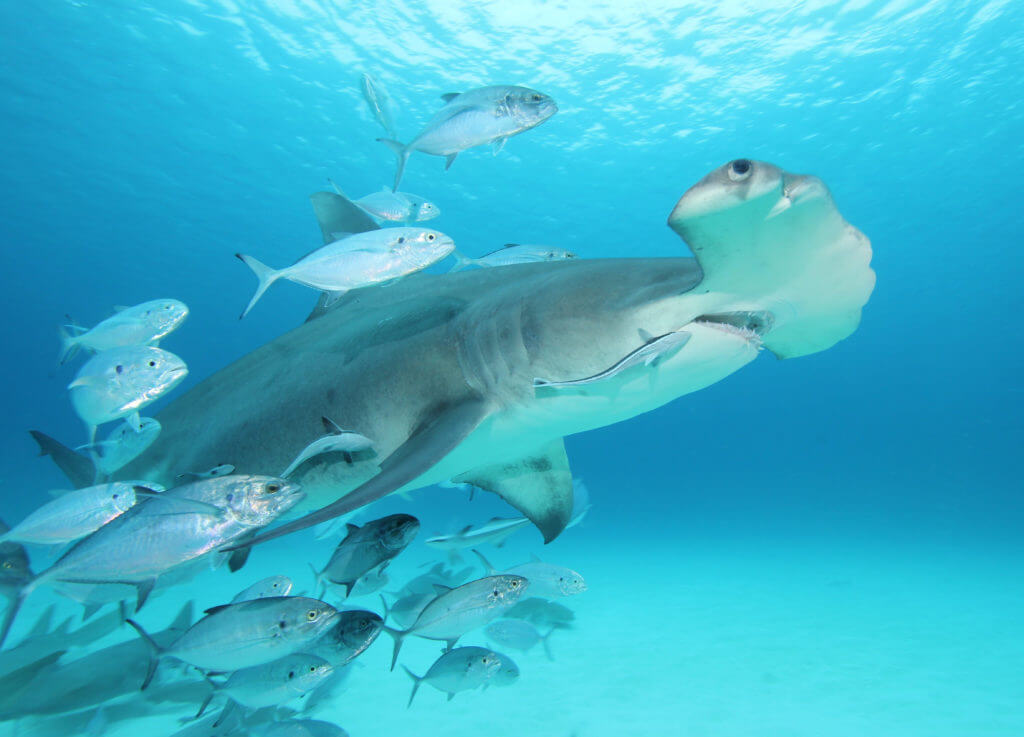
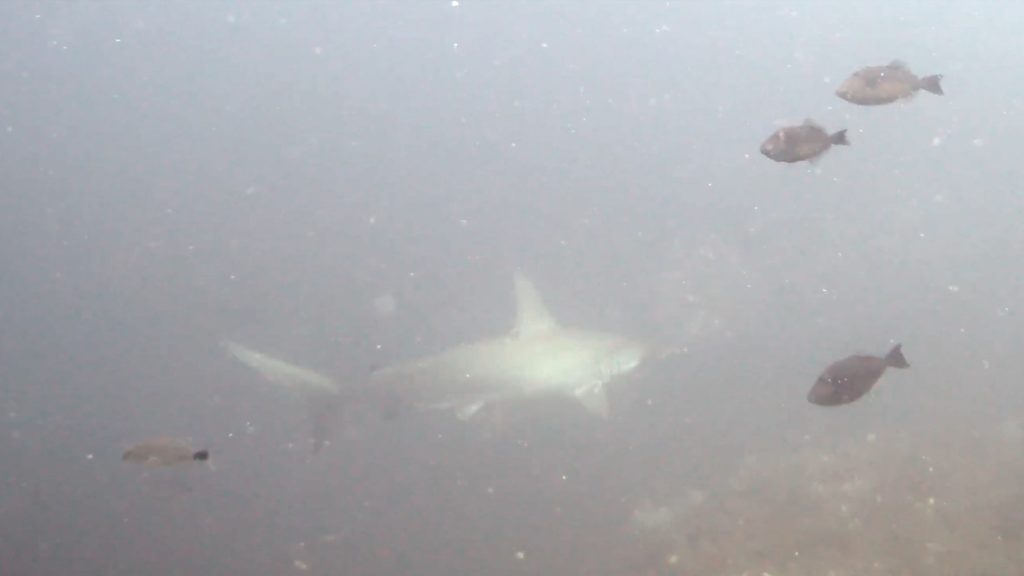
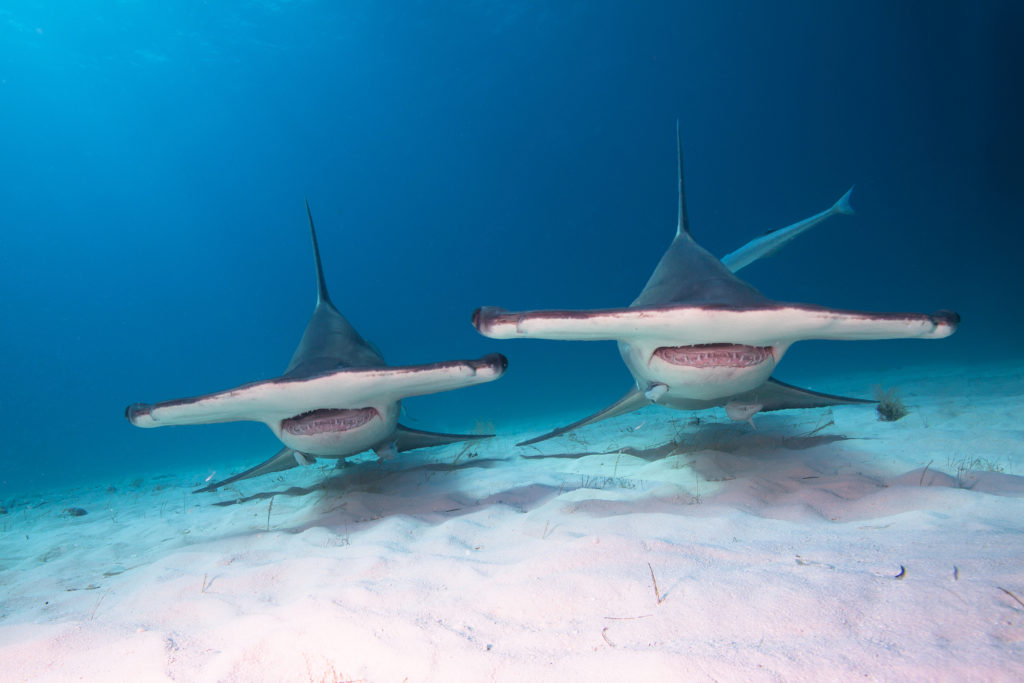
One of the main reasons I’d gone to Coiba Marine Park; was because from April – May; small groups of hammerhead sharks are regularly seen there.
Although there were no sign of any on the first day around the southernly dive sites; on our very first dive around the northern sites from Pixvae we saw several!
I remember staring in awe as the otherworldly, dream-like creatures swam past, each one around 7ft long.
With their flattened heads that laterally extend into a “hammer” shape (called a cephalofoil), hammerhead sharks are an iconic marine species.
Their wide-set eyes give them a better range of view than other sharks whilst the shape of their heads means their electro-sensory organs are spread over a larger surface area, allowing them to more thoroughly scan the ocean.
There’s several species of hammerhead sharks: the ones we saw were the largest to their kind: great hammerhead sharks.
Being fairly young individuals they were only around 6 or 7 ft long, but great hammerhead sharks often reach up to 15ft (4.5m) when mature and sometimes up to 20ft (6.1m)!
Intelligent, adaptable and inquisitive; these sharks are apex predators; feeding on a variety of prey including fish, crustaceans, cephalopods, smaller sharks and especially stingrays which they’re well adapted to hunt.
They sometimes use their hammer-shaped heads to batter stingrays; stunning them and allowing the hammerhead to go in for the kill. Other times, they use their hammer-shaped heads to pin rays to the sand whilst biting off their fins to kill them.
Although they could potentially be dangerous to humans, great hammerhead sharks have only been recorded as causing one fatal bite; unfortunately humans are much more deadly to them and as a result of over-fishing, great hammerhead sharks are now critically endangered.
Low water visibility was a major issue whilst I dived at Coiba; especially at the moments the great hammerhead sharks presented themselves.
Consequently neither I nor Laura got any decent photos of the hammerheads and my videos were barely usable; which is why I’ve used shutterstock images to show you what these mighty beings look like!
On other dives, we saw dozens of the hammerhead sharks favourite prey: southern stingrays together.
The cloudy waters they appeared out of made things all the more dreamlike as the wraith-like beings were swallowed back up by the murky waters as quickly as they’d been spat forth from them: in all directions: above, below and to the sides.
Southern stingrays usually grow 2 – 3 feet wide but can reach 5ft and are found alone or in loose groups as we encountered them here.
Their tails contain a venomous barb which they use to defend themselves but upon using it they loose it leaving them defenceless until they can grow a new one. Generally their quiet docile and laid back.
These rays spend most of their time buried in the sand (trying to hide away from those hammerhead sharks, their number-one predator!) and feed primarily on bottom-dwelling crustaceans and shellfish.
There were also plenty of whitetip reef sharks on every dive as well as turtles and more schooling pelagic fish and smaller reef fish than I’d ever seen anywhere in my life.
On our final dive, we explored what appeared to be the sunken remains of an ancient city; or at least that’s what the locals were sure it is.
It’s hard to tell for sure; but I’d be inclined to agree with them as the many huge underwater slabs and structures did look suspiciously manmade.
If it really is the remains of a Pre-Columbian city; it would have fascinating anthropological implications as indigenous societies at city-building status were never recorded in Panama…
For this trip, I filmed with both my Paralenz Vaquita and my Sealife Micro 3.0 to experiment with what it would be like mashing the videos from each together.
(I also continued to practice my presentation skills despite an extremely sunburnt face):
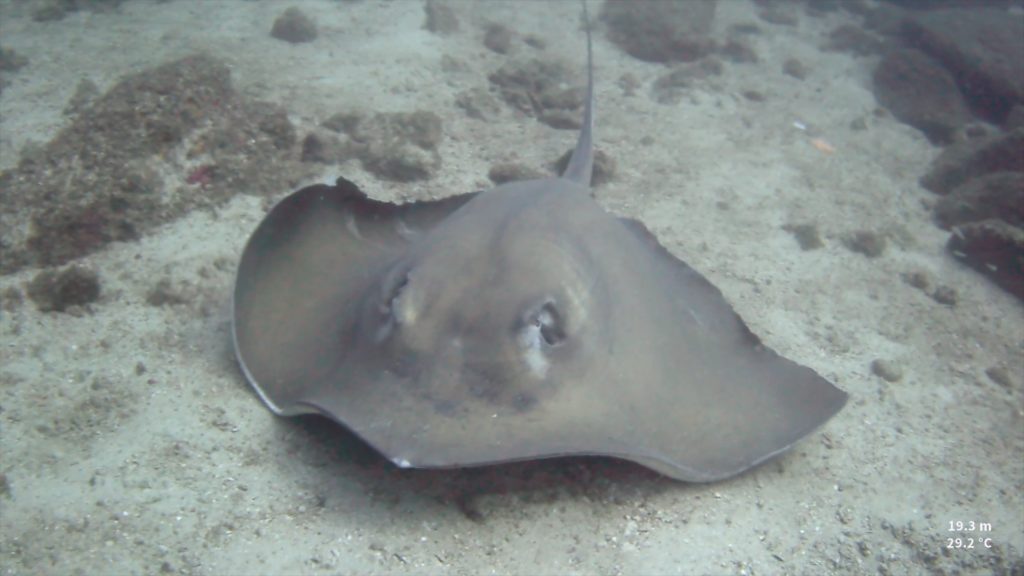
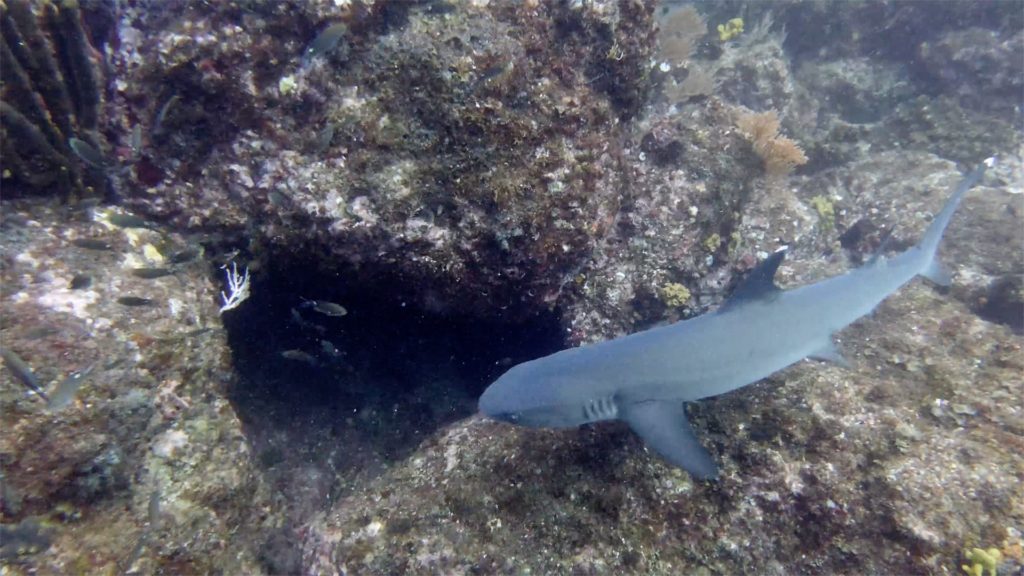
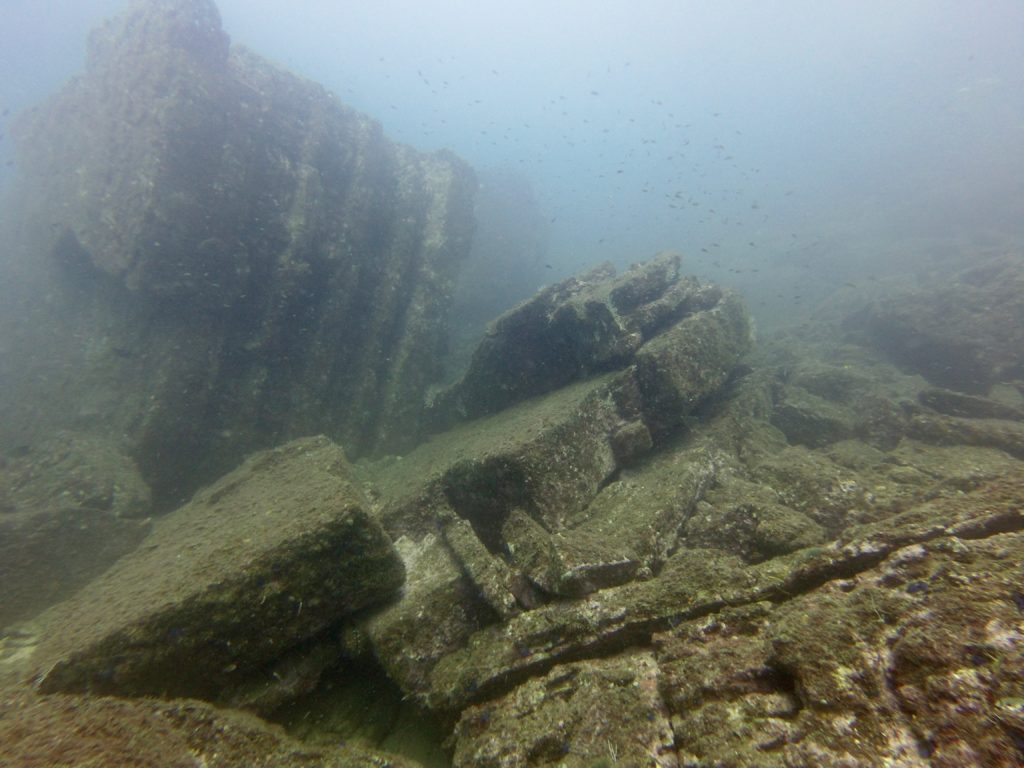
I felt like editing together footage from the Paralenz Vaquita and Sealife Micro 3.0 worked well; although I can tell which shots are from which camera and recognise the higher quality picture from the Paralenz Vaquita; that said the difference in quality isn’t so great that it interferes with splicing footage from both cameras together.
What was more of an issue was the excessively cloudy water that we encountered during so many of the dives.
If only there was some way I could use the Paralenz Vaquita and the Sealife Micro 3.0 at the same time… (eventually I do just that but not in this chapter).
Diving Coiba was one of the most exciting things I did in Central America; nowhere else did I see hammerhead sharks, nor so many southern stingrays, white tip reef sharks and vast schools of fish. And of course the potential lost city ruins!
In places, there was also some very decent coral reef; but the limelight was definitely stolen from it by all the large marine animals.
After my time at Coiba; I made for Bocas del Toro; which lies across the Boquete mountains on Panama’s Caribbean side…
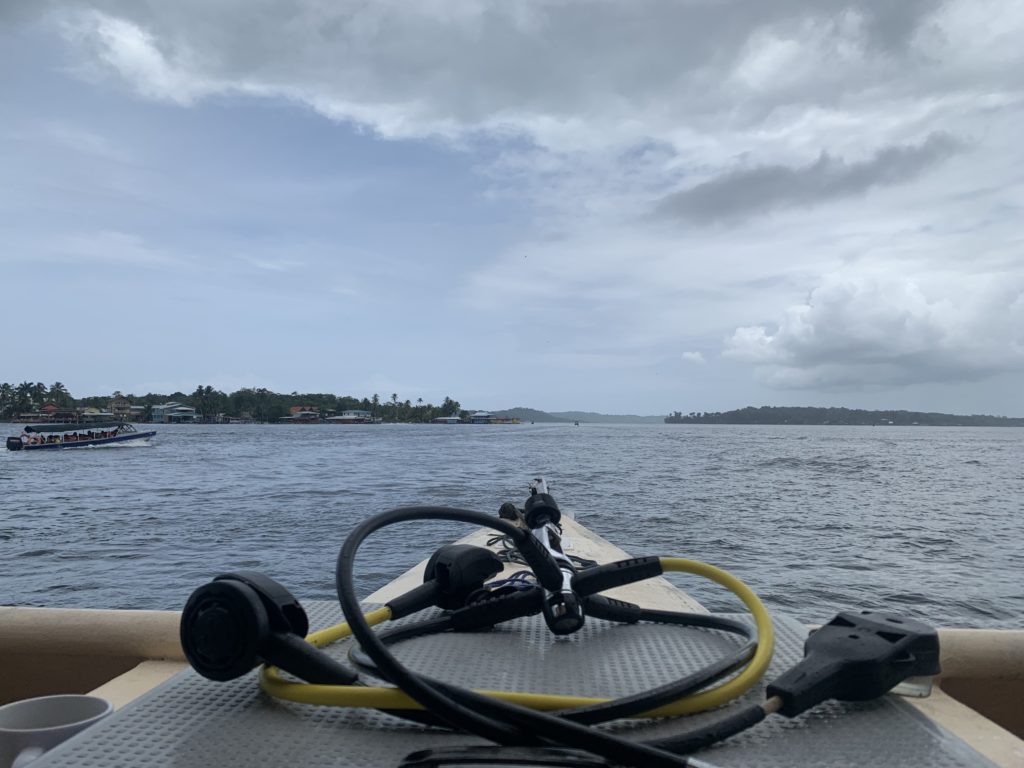
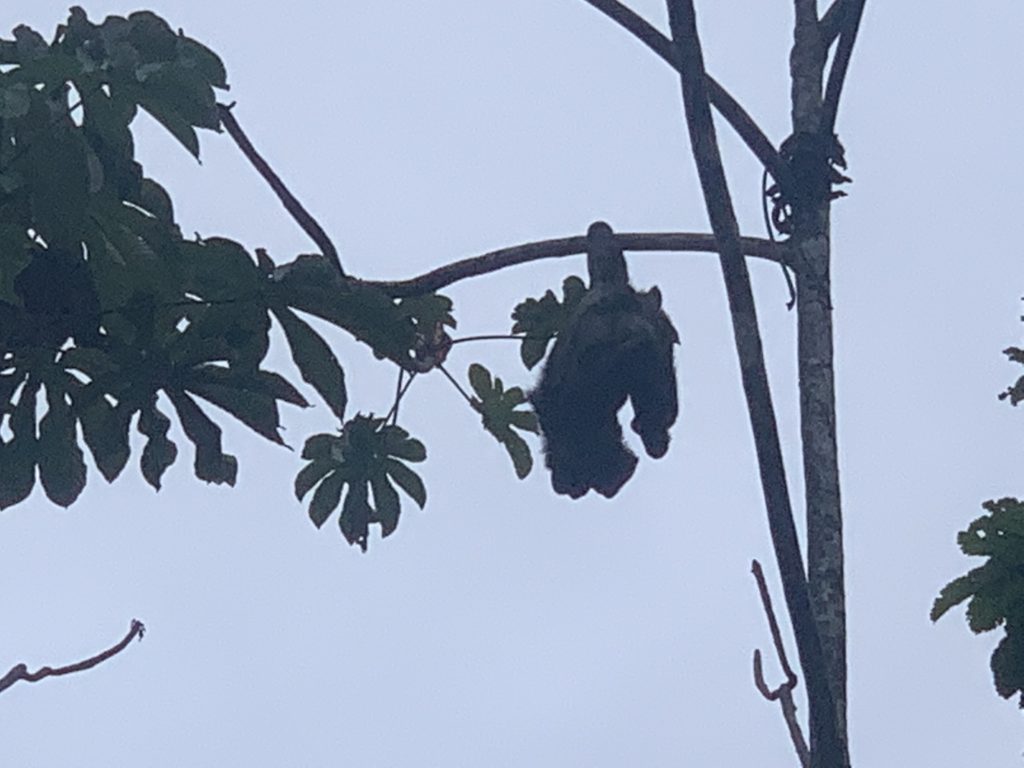
I’d heard wildly different accounts of Bocas. Some said it was the best diving they’d experienced in all of Central America; others told me not to bother going.
Bocas del Toro consists of several islands in the Caribbean a few km off Panama’s mainland; some are allegedly quiet but I stayed on Isla Colon in order to be close to the dive centres.
Isla Colon; with it’s pounding nightclubs, crowded streets and scores of young, party orientated travellers wasn’t really my jam, but I could see why it might appeal to someone aged 18 – 21!
If you rent a bicycle it’s easy to quickly escape the noise and find yourself venturing through pristine rainforest; indeed it was in that fashion I saw my first ever wild sloths: a mother with her baby.
On the other islands there’s a range of experiences to be had including an indigenous homestay, caving and various treks.
However if you go to Bocas to dive, you’re practically forced to stay in the thick of the tourist hub (Bocas del Toro town on Isla Colon) to be close to the dive centres; most of which are located there.
So that’s what I did and at night it weren’t easy sleeping over the noise of terrible karaoke and shrill moans of barely legal sounding backpackers bonking rythmlessly in the next room but there you go….
Let’s skip to the diving; which I’d signed up to do with one La Buga dive centre; they were hard to miss with the wooden cutout of the mask at the top of the entrance to their dive centre and bar.
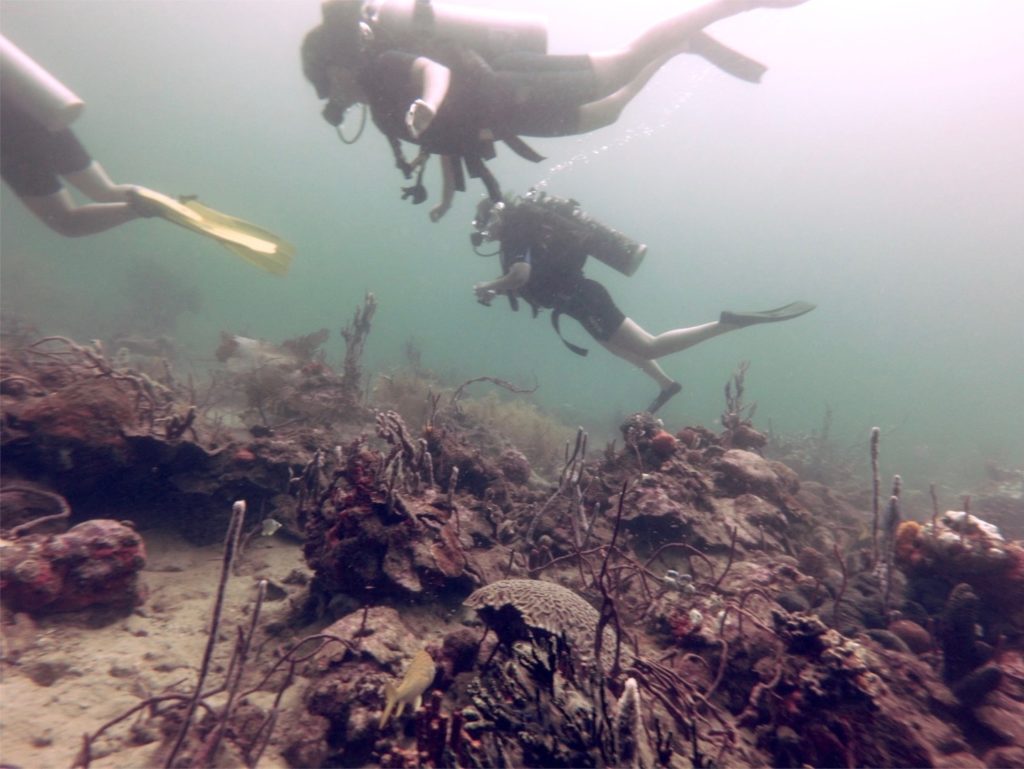
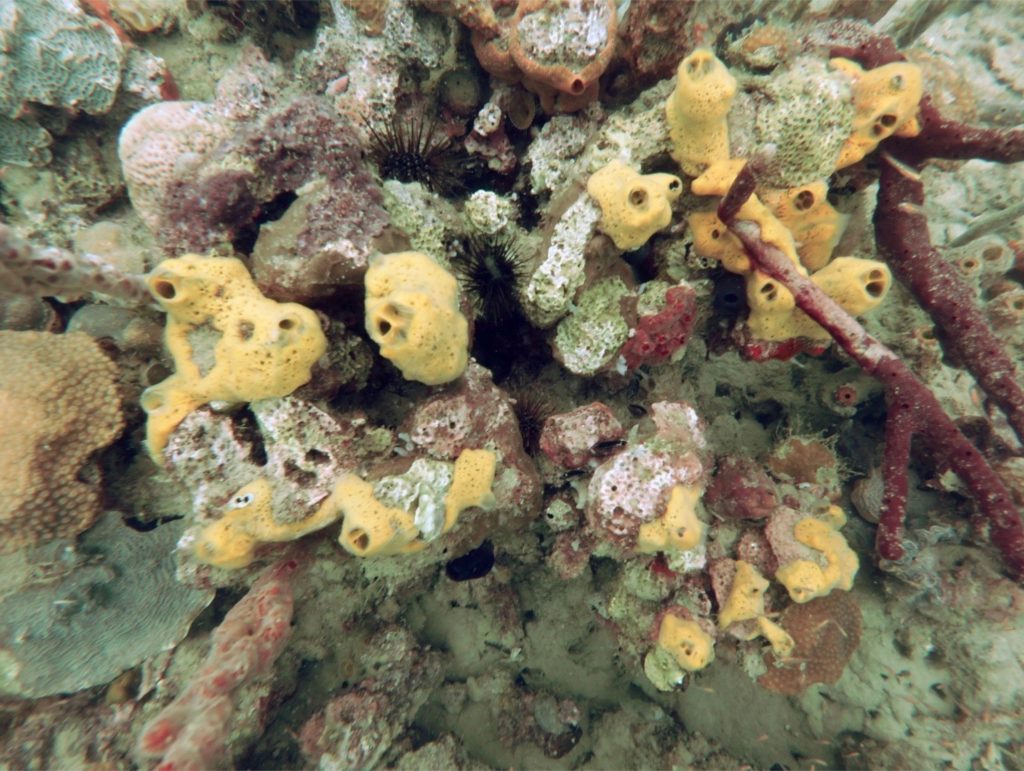
There’s over a dozen dive sites around Boca; most are located within Isla Bastimentos Marine Park: a 132.26 km squared area managed by the National Environmental Agency of Panama.
For most dive sites, it’s only a ten minute boat-ride and then it’s kit up, dive in and descend down.
The first thing that struck me about diving around Bocas was the diversity of the corals and sponges growing there; some reports say there’s 59 species of coral and sponges – other’s claim far more.
Well I didn’t count but there were a hell of a lot!
The most instantly recognisable players were the numerous whip corals; dark red and greyish green in colour; these long and thin…whip-like coral were everywhere!
Wrapped around the tips of many of the whip coral were brittle stars; their white and blue bodies nicely complimenting the reds and greys of their coral perches like decorative pieces of tinsel.
There was also a lot of brain coral; usually orange or purple as well as yellow mustard hill coral, white finger coral and also fire corals, leaf lettuce corals and huge vase sponges to name a few others.
Without a doubt, this was the healthiest, most abundant, most biodiverse coral reef I’d seen in all of Central America; partly due to it’s calm, warm waters and nearby mangrove forests.
From what I heard; it seemed that the marine ecosystem of Bocas del Toro was very similar to that of Costa Rica’s Puerto Viejo some 100 km further up north Central America’s Caribbean coast.
Recall that I visited Puerto Viejo at the end of 2021 but couldn’t dive there because the water conditions were too rough at that time of year!
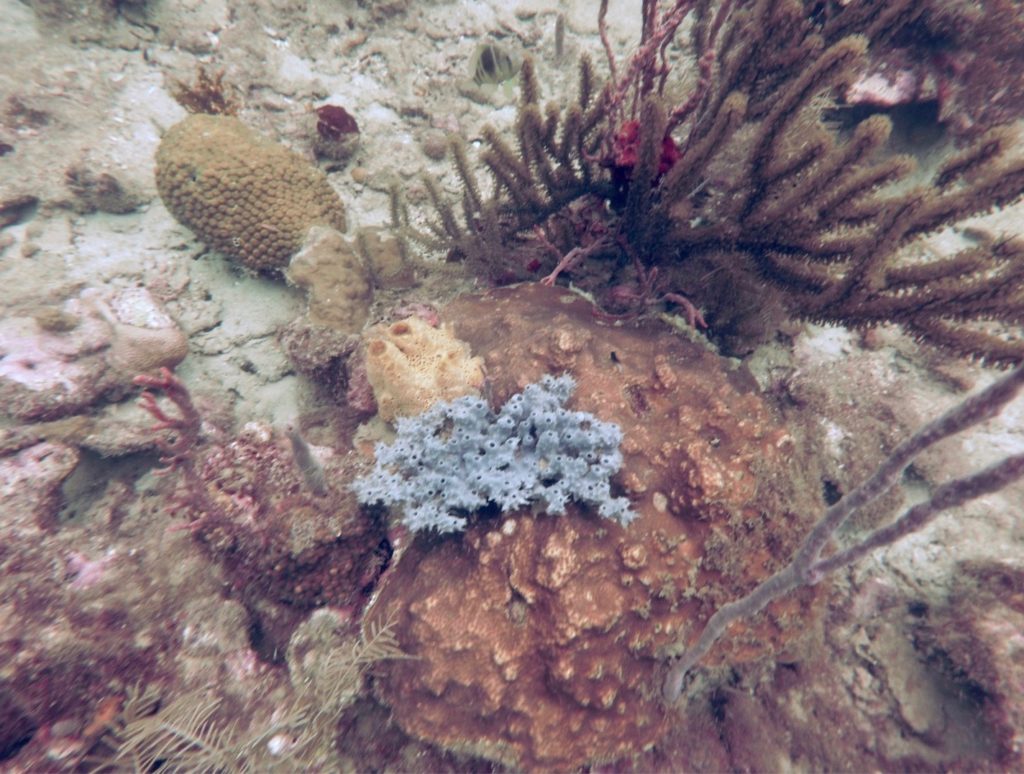
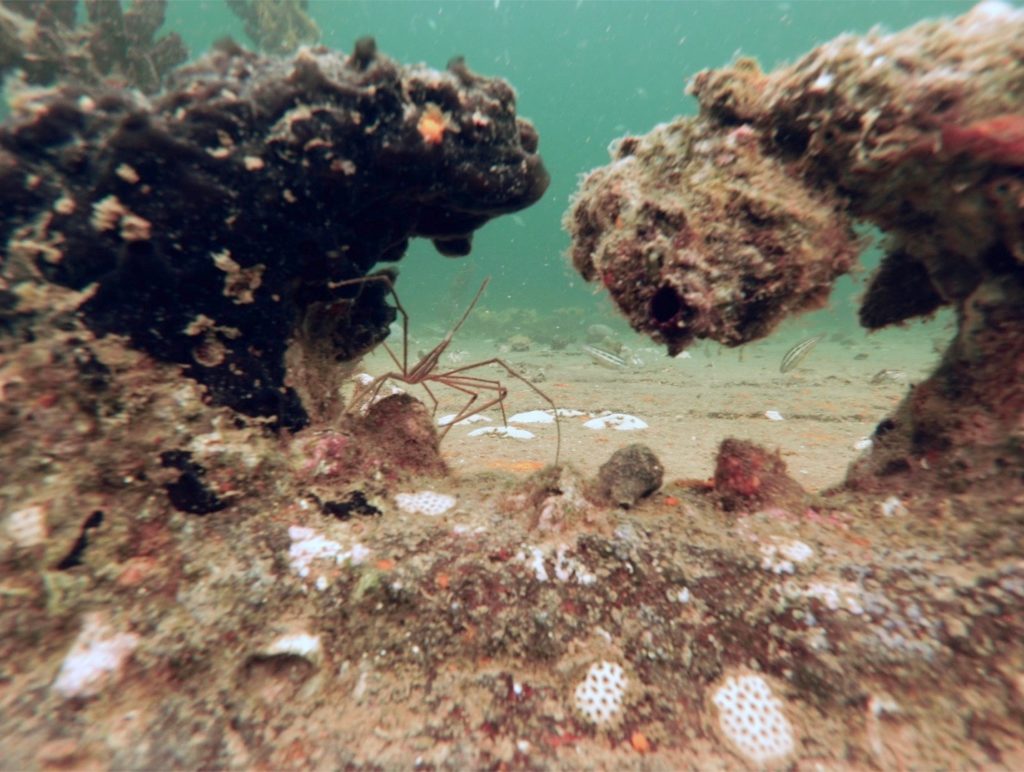
All 6 of the dives at Bocas del Toro I made were shallow; usually at around 39 feet (12 meters) or less and this combined with the calm waters devoid of any current made the diving extremely easy and carefree.
It struck me that this would be a truly excellent place for someone to learn to scuba dive; I can’t imagine an easier setting.
Something really bummed me out though: the fragile coral structures – especially the whip corals, got kicked and broken by scuba diver’s – even dive centre staff: so much!
I’d never dived somewhere before where the reef was taking such an obvious daily beating from divers.
I wandered how many years the reef can withstand such a relentless hammering if everyone’s like that. I’ve heard of places in Thailand where over the years the reef got whittled away to nothing in such a fashion.
This really got me thinking about the ethics of tourism; prior to it’s development as a tourist hub, the Bocas del Toro archipelago was fished much more aggressively and there wasn’t any restorative work being made on the reef there.
However; it’s really important that tourism is managed in the most stringently environmentally friendly manner with strict protocols and the highest quality of performance required from all staff.
My heroes at Mission Blue wrote an incredible article about sustainable tourism at Bocas del Toro.
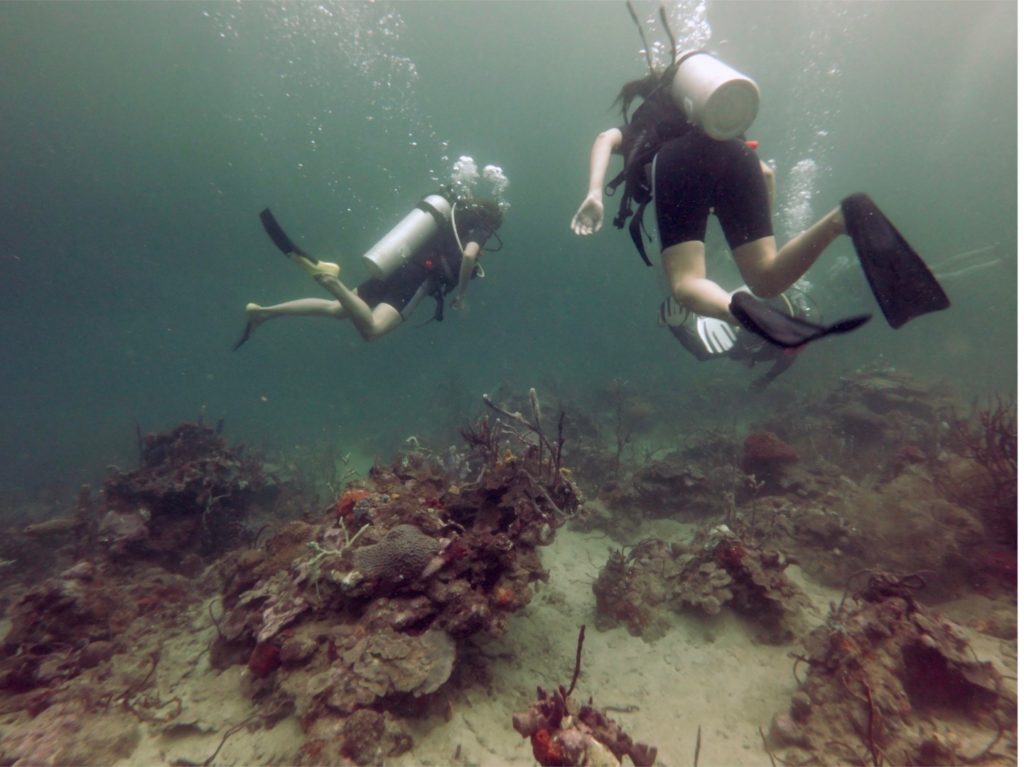
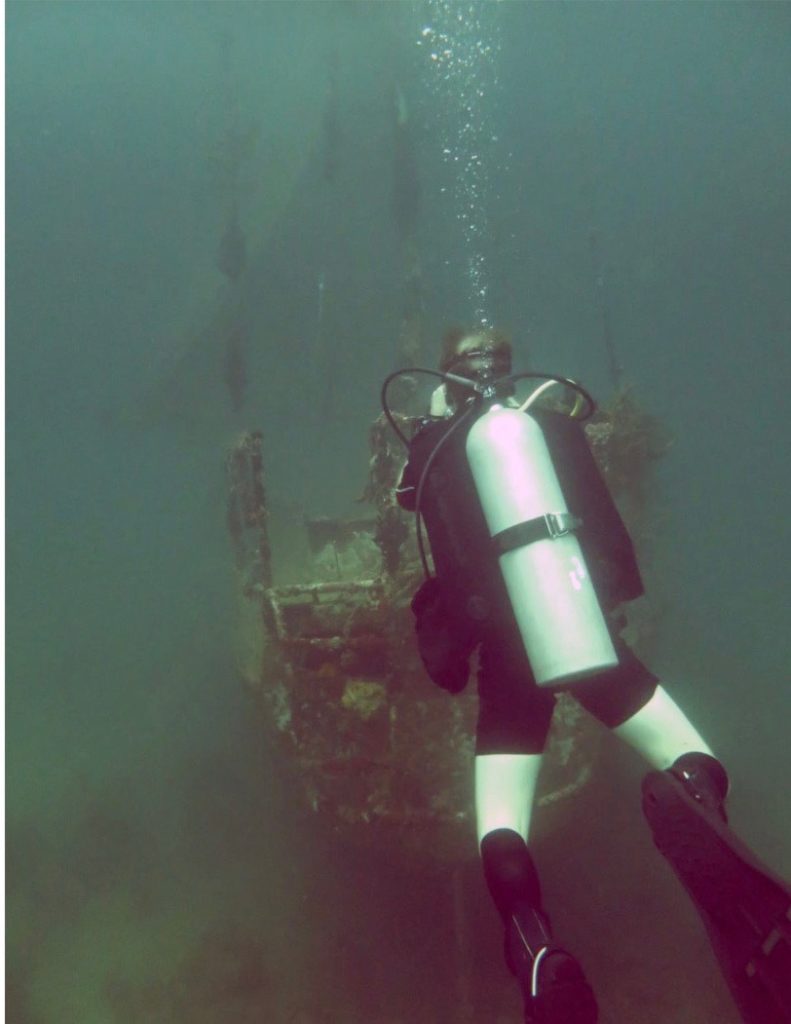
Ok…back to the diving! Nestled among the coral were fanworms, sea urchins, cleaner shrimp and tons of arrow crabs; with their pointed bodies and spindly legs, these small and flamboyant looking crustaceans are striking in their appearance.
There were also scores of orange fish larvae less than a centimetre long as well as a great many juvenile forms of common Caribbean reef fish including goatfish, sergeant fish, butterfly fish, snapper, trumpetfish, porcupine fish and parrotfish.
It seems the waters of Bocas are very much a nursery as most fish I saw weren’t fully grown – we also glimpsed a very small southern stingray and a couple of medium sized green turtle.
In total there are three smallish-medium sized shipwrecks around Bocas that you can explore.
These wrecks are great for observing the coral reef growing on them and you can even venture inside and explore one.
Overall, Bocas del Toro was a beautiful place to dive: brimming with life and showcasing insane diversity of coral and sponges. No wander scientists study coral biodiversity and resilience there.
The colours were amazing and the small critters never-ending. It was also probably the easiest to scuba dive location I’ve visited.
For anyone wanting to learn to scuba dive or marvel at shallow coral reef at its finest, Bocas del Toro would be the place to go.
That said, in terms of sharks, fully grown rays and turtles, pelagic fish and other big marine animals, there wasn’t any! I suppose this is why some folk weren’t impressed.
Check out the video I made below, filmed entirely with my Sealife Micro 3.0:
In hindsight I felt that the intro to this video was pretty weak. I didn’t much like my presentation style here – I was far too stoned whilst recording it and still experimenting with the overall style and presentation persona.
I wanted to act in a way that was totally fresh to the usual style of blog presentation; to surprise and even shock my audience with what I said and how I said it whilst also keeping the introduction to a minimal length of time in order to free up more time for the underwater footage.
With a desired 15 second time cap; that’s enough time to introduce the location; but not enough time to say anything significant about it; so instead I’d opted to simply say where I was in my intros and then for the last few seconds play around with some ad-libbed improvisation.
I quickly discovered that re-shooting my self made each successive take feel progressively less fresh so I resolved to not actually have any script (besides “let’s dive in” at the ends!) and try to make each take totally different to the last.
In my mind, this particular narration take just didn’t work out that great but it was the best I had.
As far as the actual underwater footage went however; this came out as pretty strong – it was really nice having all that beautiful reef to film.
However my time spent filming it, really pressed home the need for met to get a macro lens so I could film things like coral surfaces and tiny creatures such as the arrow crabs much closer and from different perspectives.
I was mainly filming during my time in Bocas del Toro, but I did continue to experiment with the photographic abilities of the Sealife Micro 3.0 churning out some images such as this:
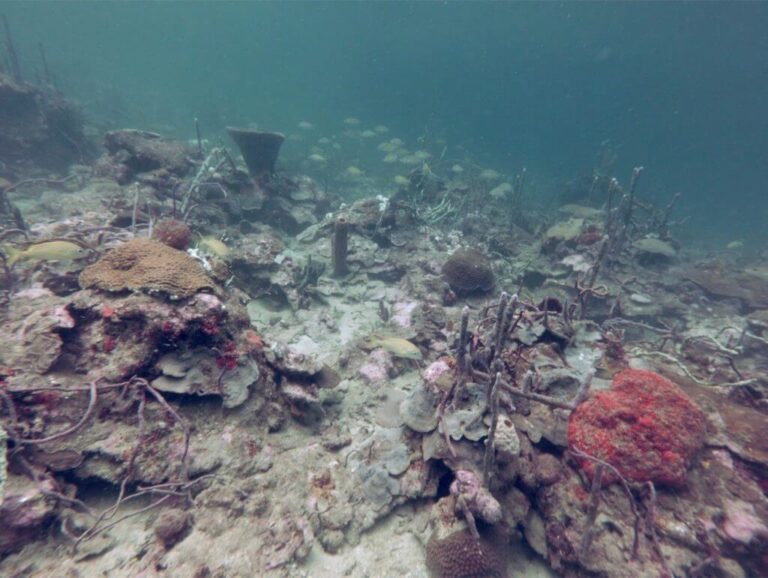
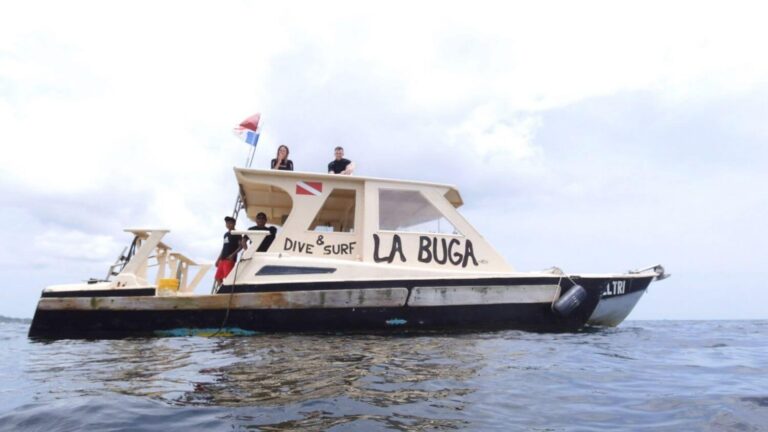
After my time diving Bocas del Toro; I headed back to Costa Rica to retrieve Senor. Carro and have one final blowout fortnight in Jaco….
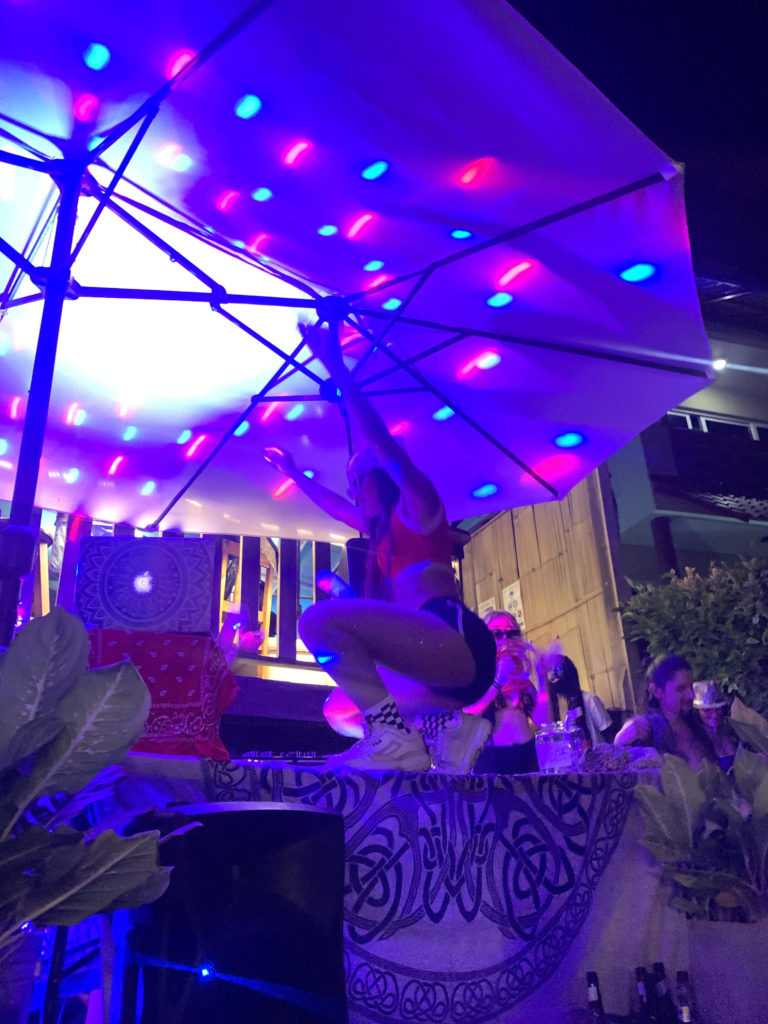
With Senor. Carro now allegedly completely fixed and after a tediously long process of acquiring the necessary paper work to drive it out of Costa Rica; I was ready to continue exploring new dive destinations.
We’re approaching the end of this story.
By now I had scuba dived around much of Costa Rica as well as dived Panama to it’s south; I decided my next point of call should be to the north of Costa Rica: the Corn Islands of Nicaragua!
(I’d actually been in Nicaragua the previous October; but hadn’t had time to dive. Instead I’d visited Ometepe, an island consisting of two volcanos set within the largest freshwater lake in Central America and the 10th largest in the Americas).
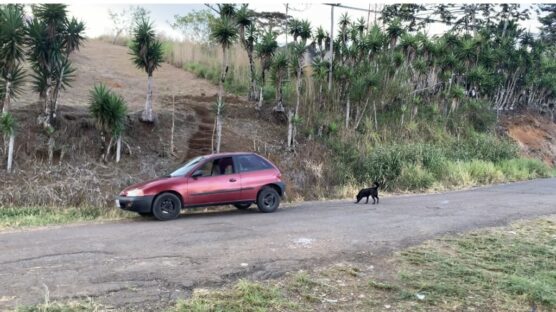
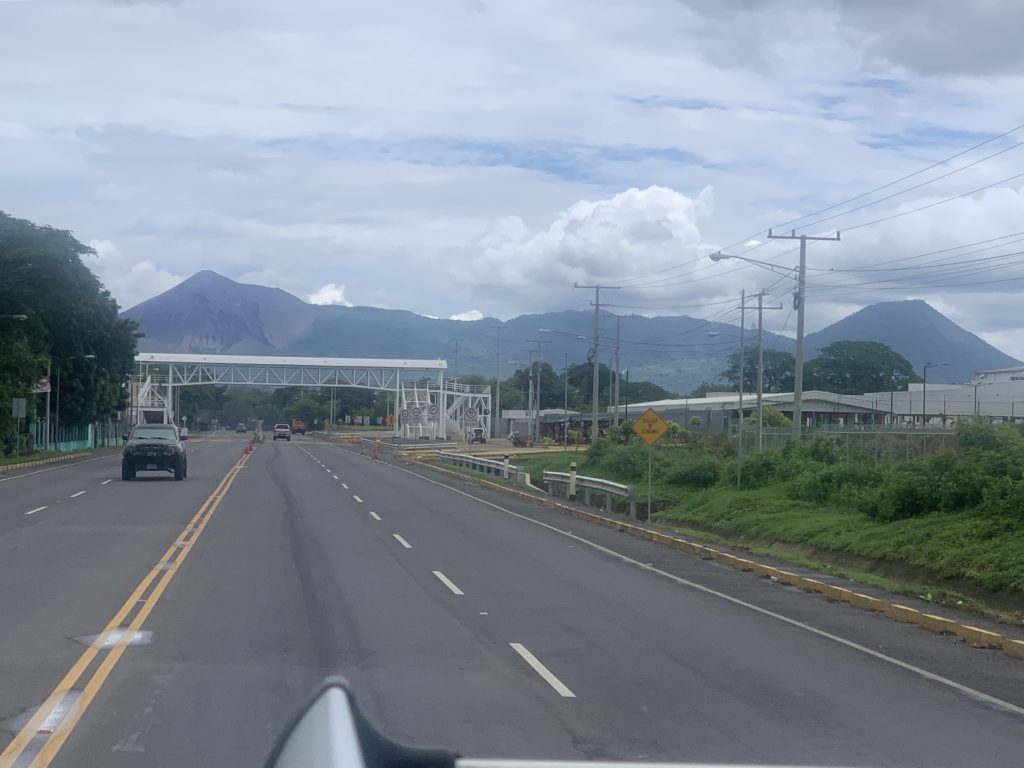
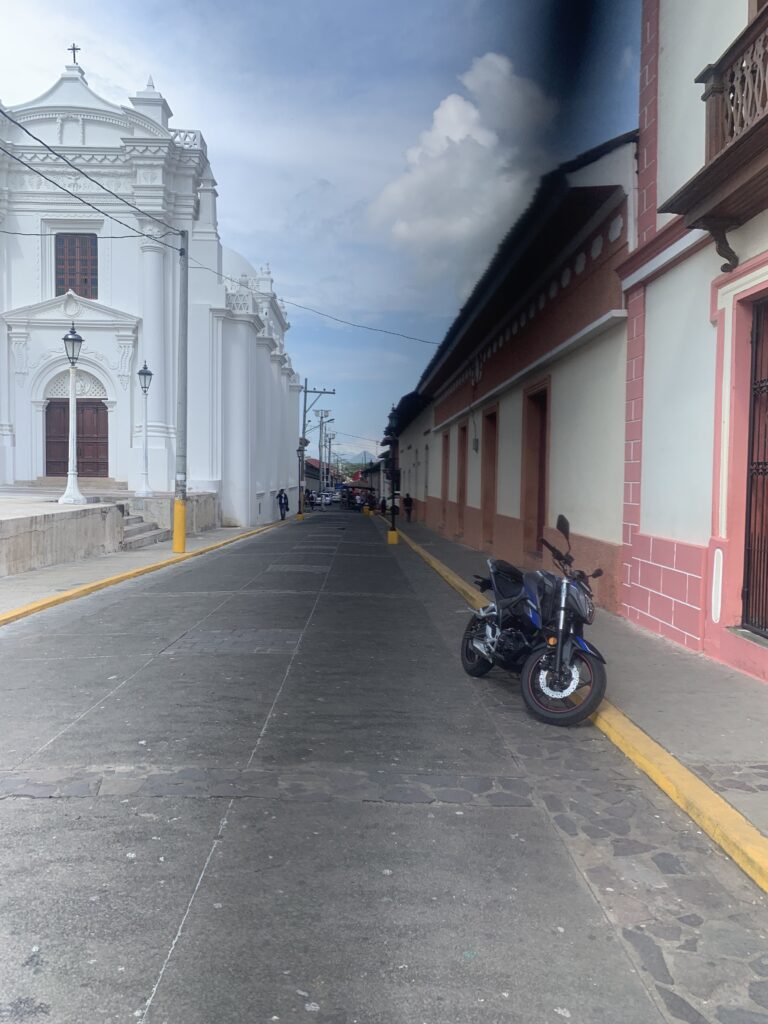
And so, in the middle of May, I drove Senor. Carro 481 km from Costa Rica’s Jaco all the way to Leon in Nicaragua; with two Jaco-ian passengers in tow.
It was a scenically pleasant journey and despite one of my passengers screaming near the start: “OH GOD ALEX! I DON’T WANNA DIE”!!…
…to which replied I – “Christ – have a little faith!”…
…we had a wonderful journey!
Senor Carro raced over pothole riddled roads alongside the beach, hammered down the motorway, overtaking everything in sight and in the distance spied jungled steeped volcanos blotting out the horizon.
For much of the journey, a torrential downpour hammered against Senor Carro’s windshield, sneaking through a loosened gap to patter down onto the girl in the front passenger seat before fogging up the windows. Rainy season was upon us once more.
We dealt with this using the window-de-fogging-device (my t-shirt) and later I sealed up the loose crack in the windshield with a healthy dollop of glue. Well I think it was glue. The label was in Spanish.
After a couple of days driving and dropping off my two passengers at their respective locations (Liberia in Guanacaste and Granada in Nicaragua); I found myself arriving alone in the historical town of Leon; far up in northern Nicaragua and close to it’s Pacific side.
I wasn’t there to dive (which would be at the Corn Islands); instead I’d gone to explore for a week; which I did as I wandered the old streets of the historical era town; gazing at colonial buildings and visiting the largest cathedral of Central America.
Leon was an interesting place to visit; in places the culture and history was amazing; in others the levels of poverty and obvious hardship; quite overwhelming.
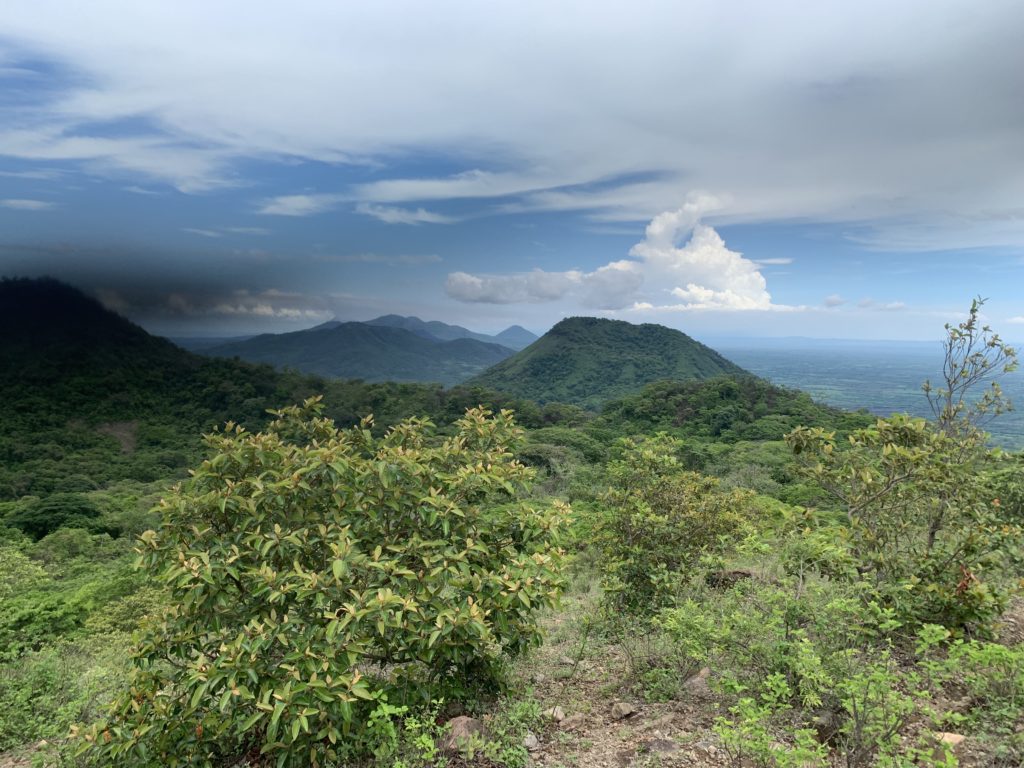
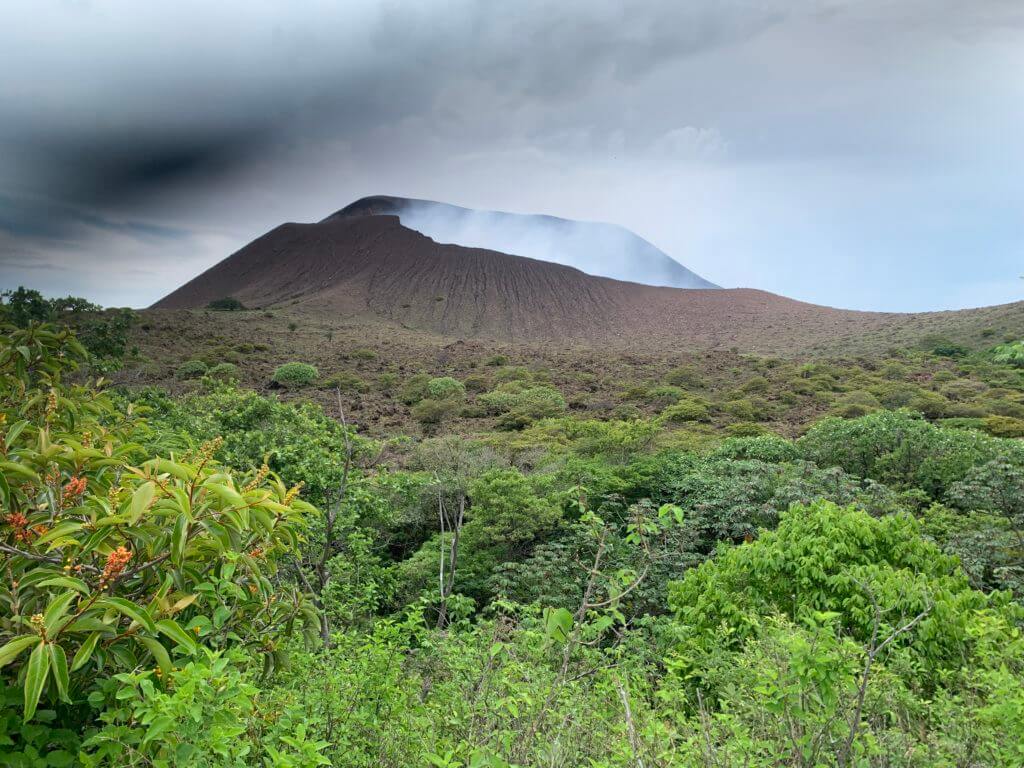
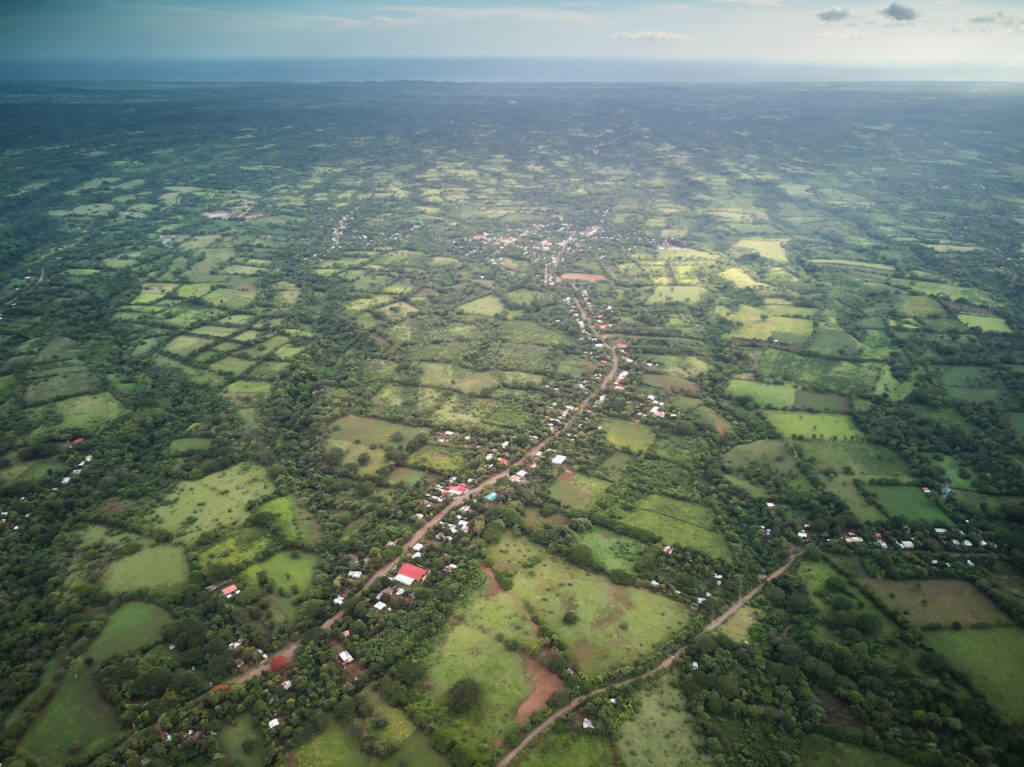
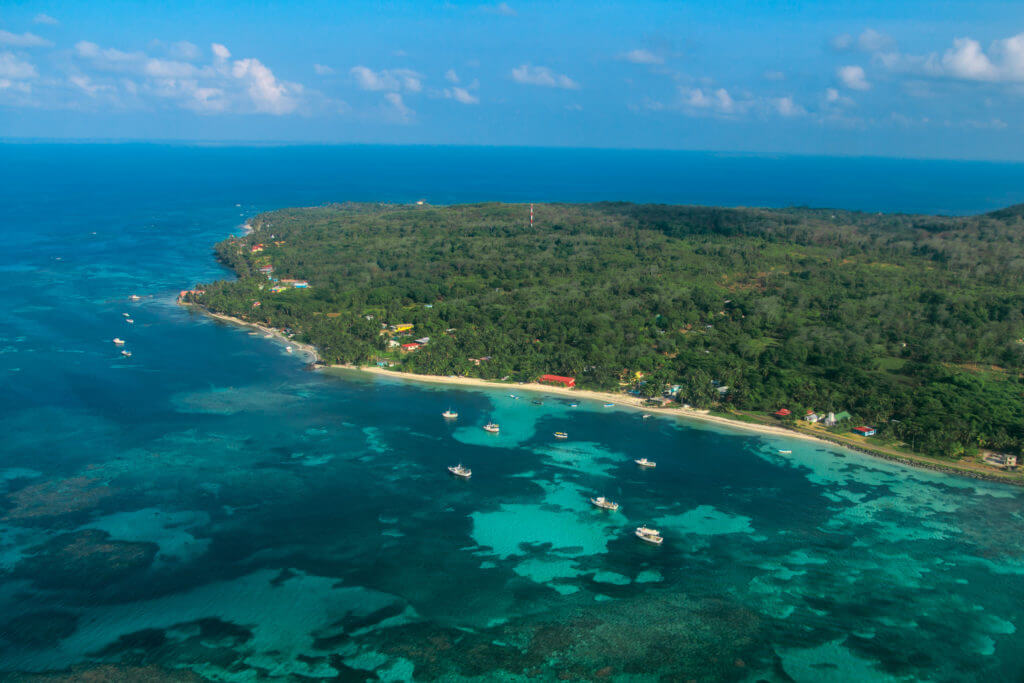
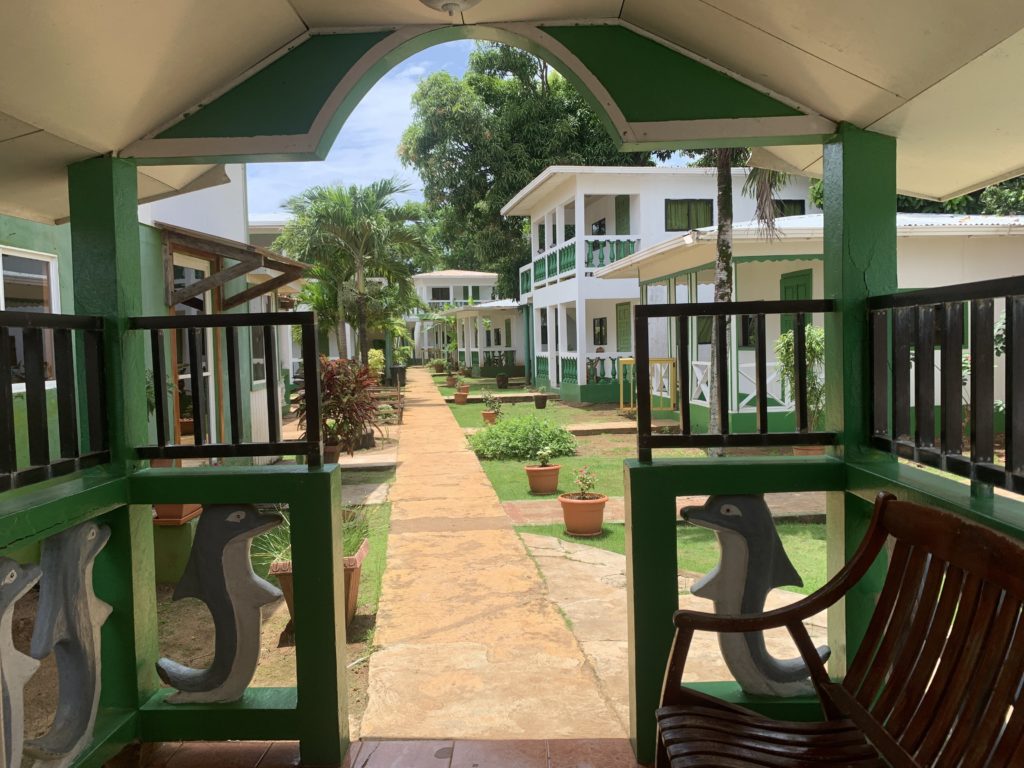
Whilst staying in Leon I made a day trek up to Telica; one of the most active volcanos in Nicaragua.
It was a long and difficult climb for someone whose fitness was at an all time low and along the way I realised just how badly I needed to get back to the gym after all of this.
When we finally reached the top; my guide (also an Alex) and I; standing at the very edge of the crater had an Alex-contest to see who could throw a boulder the furthest into the air before it went crashing down into a molten abyss.
We stopped after a low rumbling made us wander if we’d somehow triggered an eruption; but luckily nothing happened.
After my week in Leon; it was time to drive back down to Managua; Nicaragua’s capital.
I must confess that less than 1 hour into my journey I was pulled over for speeding by a cop. The ensuing conversation was in Spanish – translated into English I think we were saying this:
Cop: Do you know how fast you were going?
Me: Forgive me Mr. Cop. I think you are a good cop. My speed-meter no works.
Cop: You were going very fast. You need to come with me to the station.
Me: A good cop I think you are. I want to give you money instead… for your hard work. How’s five dollars?
Cop: You are trying to bribe me? What kind of cop do you think I am!?
Me: Ten dollars?
Cop: Ah. Gringos. Ok.
And away I sped once more.
I’d originally planned to drive from Managua to Bluefields on the Caribbean coast; where I could catch a ferry over to Corn Islands, however, I learned that to drive to Bluefields so would involve putting my car on a boat.
This sounded like a huge amount of hassle considering how despite a year of living in Central America, my Spanish still hadn’t evolved much further beyond phrases like dame todos los frijoles (give me all the beans) and how I still regularly confused words like cuchara (spoon) with words like culo (ass)…
(I would later attempt to sell my car at a lawyers office speaking only in Spanish but that’s another story)…
So; I left the car in Managua; guarded by a friend and her two ferocious miniature-poodle-like creatures and caught a tiny plane with La Costena airlines.
It was less than an hour of rickety plane flight over the many rolling bean fields of Nicaragua, spliced up by snaking rivers that twisted through the land, before we reached Big Corn Island.
Although Big Corn has a decent dollop of dive sites and a couple of dive centres on it; I planned to make a beeline for the much quieter, smaller Little Corn Island.
The morning ferry was cancelled and so what should have been a ten minute wait for a twenty minute boat journey turned into an all-day wait in the sun with only a small handful of beans to keep me going.
Several other would-be boat passenger; amongst themselves began to talk – this new group of friends they decided lets go for a walk but I slipped off for a smoke.
Eight hours later, I finally found myself stepping off of the ferry onto the jetty of Little Corn Island bay. Little Corn island; with it’s near empty white beaches, meek spattering of low-key restaurants and colourful local houses a little further back towards the island interior, struck me as a place shut off from the rest of the world and indeed it was.
It only took several minutes to walk from the jetty to Hotel Los Delfins which was where I was staying.
The reason I’d chosen to stay there was because Hotel los Delfins was part of a co-establishment with Dolphin Dive Centre which it was directly next to and with whom I’d signed up to dive.
I figured that by residing directly next to my chosen dive centre I could stay in bed for just a few minutes before the morning’s dive briefing…
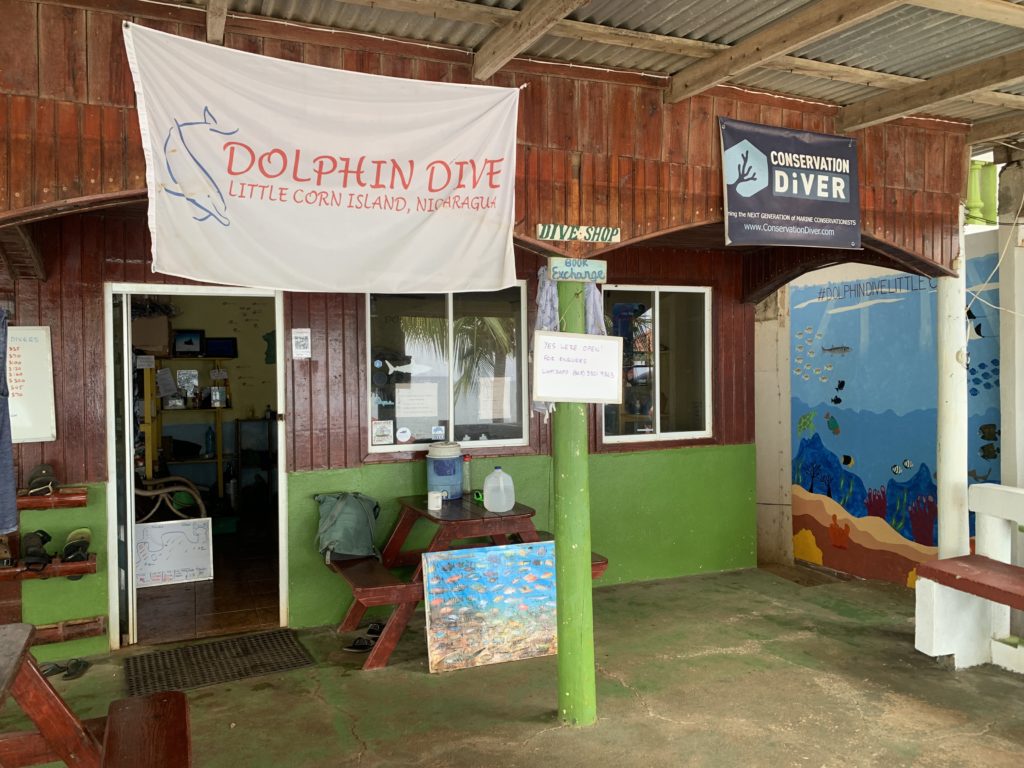
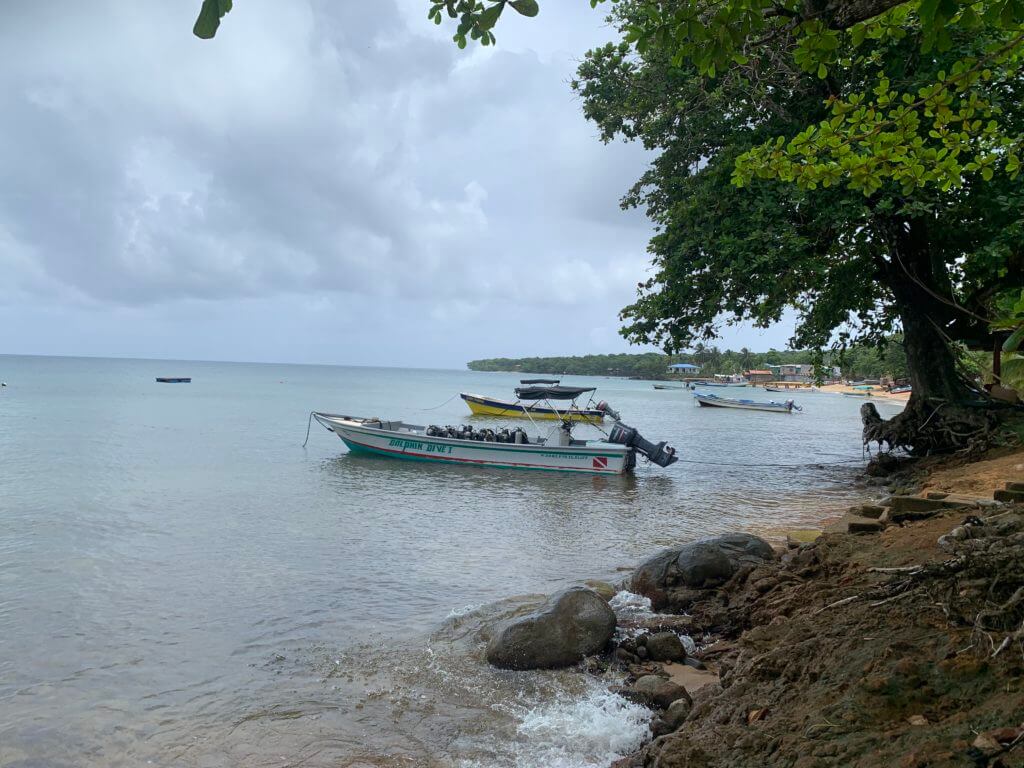
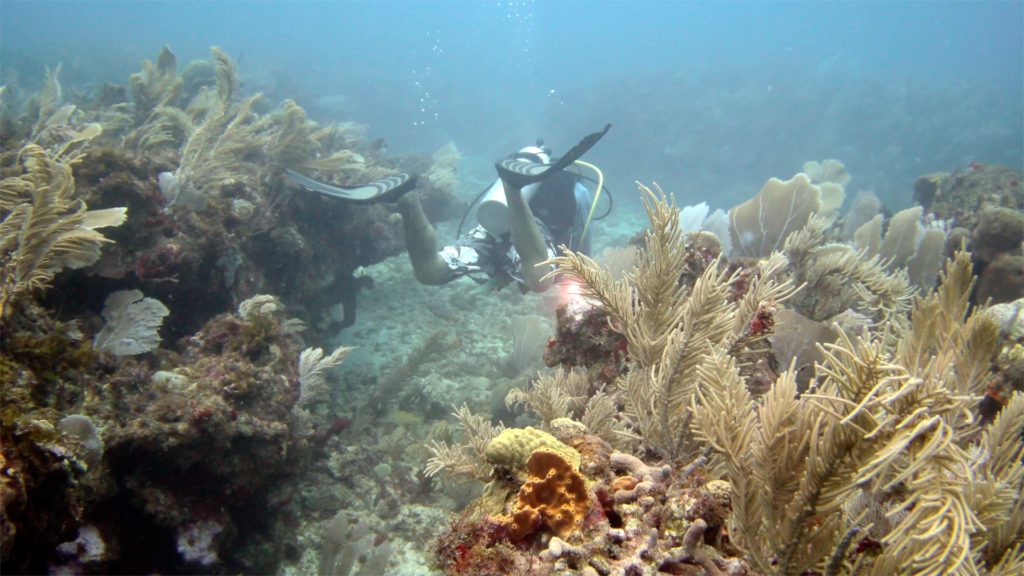
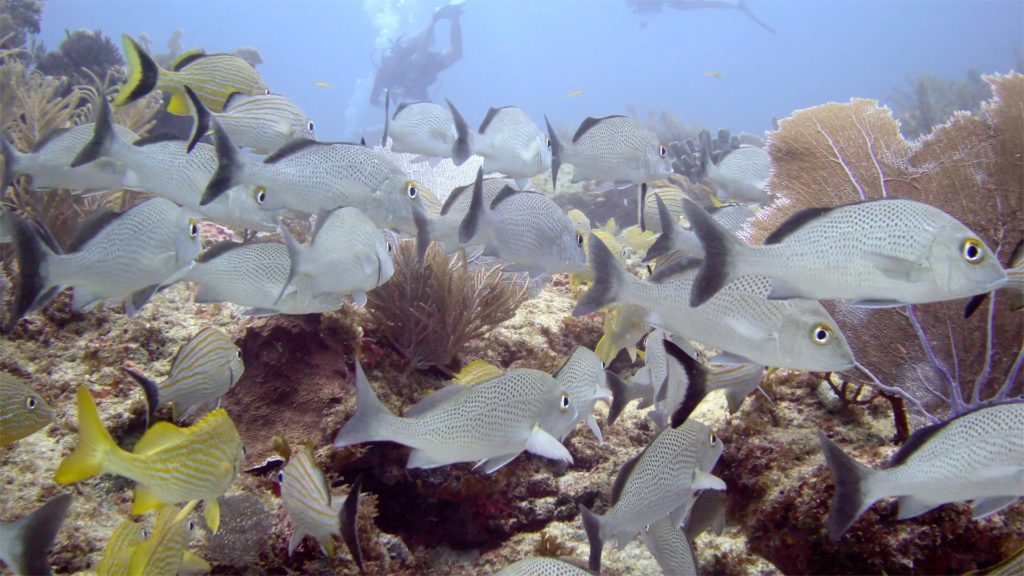
Things panned out pretty much just like that as the next morning, I awoke; groggy eyed and hungover, to snatch a nutritional breakfast of RedBull and stumble into Dolphin Dive Centre half way through the dive briefing.
Barely paying any attention to the remaining half of the brief (for a great diver had once told me that he didn’t believe in dive briefings as they spoil the sense of discovery), I wandered around Dolphin Dive looking at it’s various maps, fish id boards and white board listing cool sightings on recent dives.
Dive centres are a little like bars or music venues – no two are alike and all have their own unique vibe; Dolphin Dive was no different; a sense of adventure and awesomeness hung in the air.
It was a pleasure to meet the staff and fellow guest divers: just days later, we’d be drunkenly belting out terrible karaoke in the local pub together…
We spent our first day diving around the northern area of little corn at the dive sites “jarhead” and “long rock”; both of which blew me away for how beautiful and abundant the coral reef there was.
Seemingly as far as the eye could see there stretched a living carpet of varied coral with dense clusters of yellow seafans and orange sea whips that rose and fell in the current like colourful lungs expanding and contracting.
In places, the reef rose momentarily and then fell away to form small ridges and shallow canyons that we could swim through, surrounded on every side by the colourful reef.
Countless colourful fish darted this way and that, sheltering among the coral from the giant barracuda prowling through the open waters overhead.
Spiny lobsters and barracuda poked out of holes and crevices only to shrink back when we drew close.
A southern stingray swept overhead, momentarily casting a wraith -like shadow on the sand beneath me.
It was an incredible first day of diving, but the best was still to come…
The next day I went on a very special dive indeed- probably the coolest dive I had that entire year.
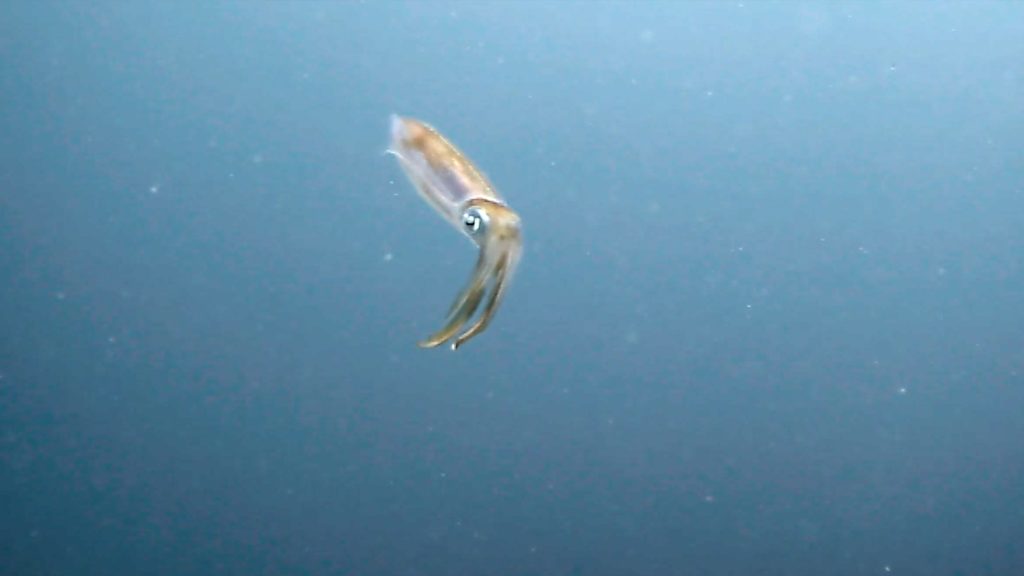
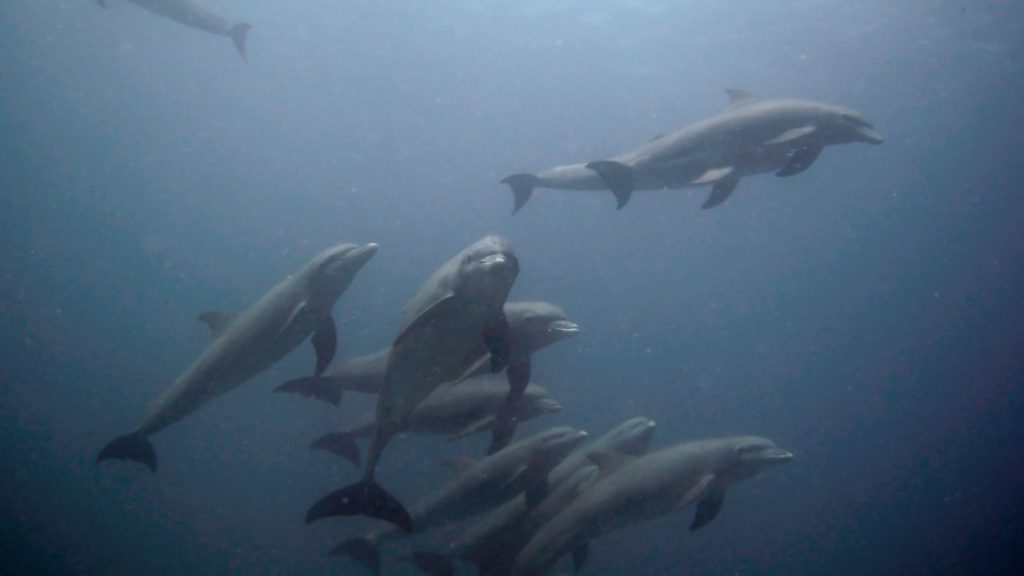
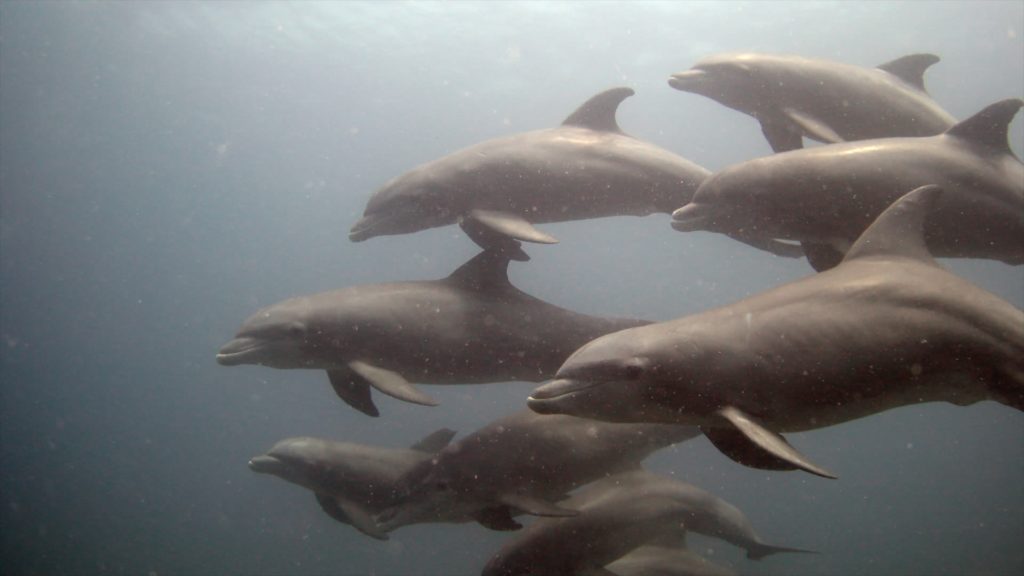
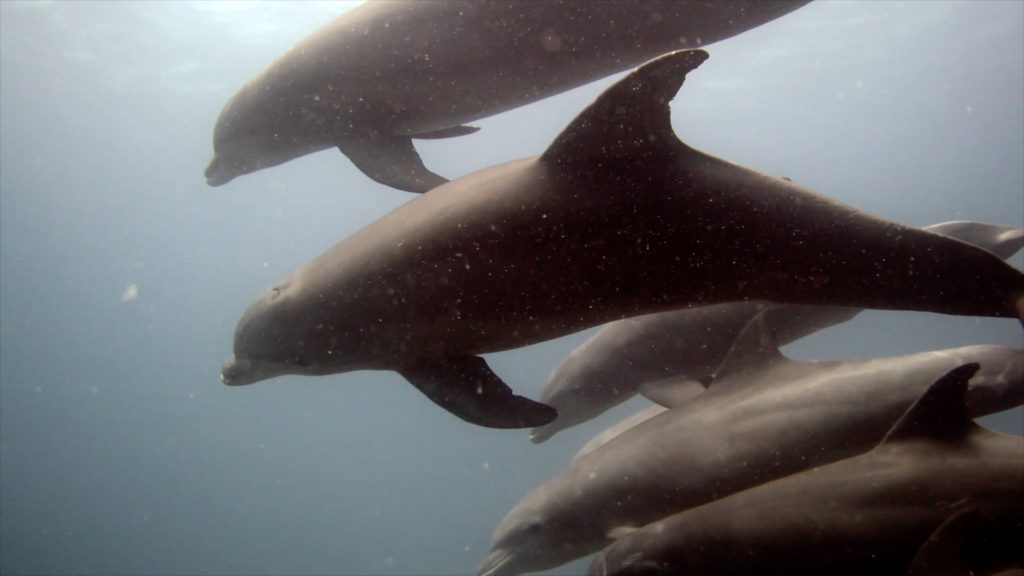
We made for the dive site Casa Blanca. Things were off to a good start when I saw my first ever live squid – or more specifically my first ever twenty live squid.
They were swimming in a perfectly straight line; maintaining the same distance between one another; it reminded me of a murmuration of birds.
The squid were almost entirely transparent making them hard to see from a distance – but as we drew closer several individuals began to change colour.
Pulses of green and yellow rippled along their soft bodies as they regarded us with huge beady eyes before they shot back, disappearing away into the blue.
I didn’t think things could get any better after that but right at the end of the dive, a pod of eleven bottlenose dolphins appeared out of nowhere!
They swam directly in front of my camera before proceeding to make several curious loops around me and the other divers – check out the full video here!
It was perhaps the most memorable experience I had in all of my time diving Central America and it left me totally blown away!
Something I love about these dolphins is how even throughout this brief encounter; you can see some of their distinct personalities and playful intelligence.
Check out the individual closest to the camera at 0:36 – 0:46. Look how she or he starts swimming in a slightly ridiculous fashion; rocking their body back and forth in that exaggerated manner before swimming normally again.
I’m certain that dolphin was messing with us; saying to the others “check it out, I’mma make those dumb-ass humans think we swim like this! Ha – it’s working – that one with the red and black arm markings is totally filming me – blue planet 2 here we come”!!
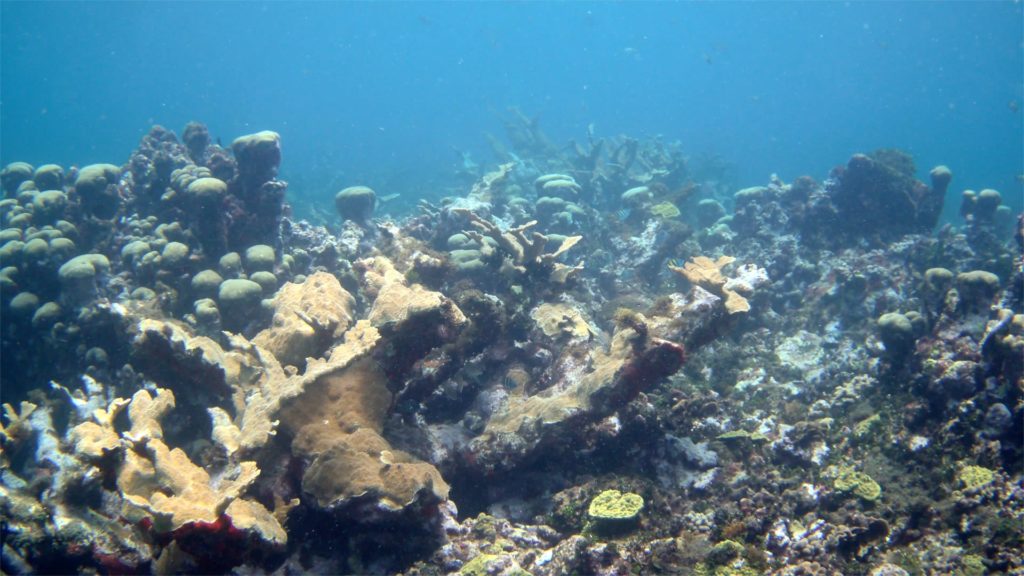
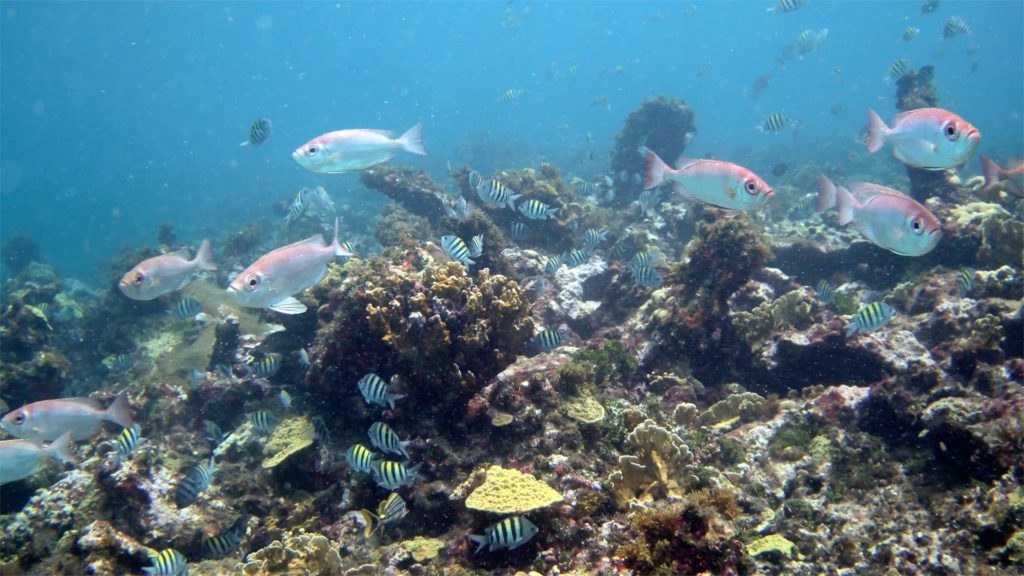
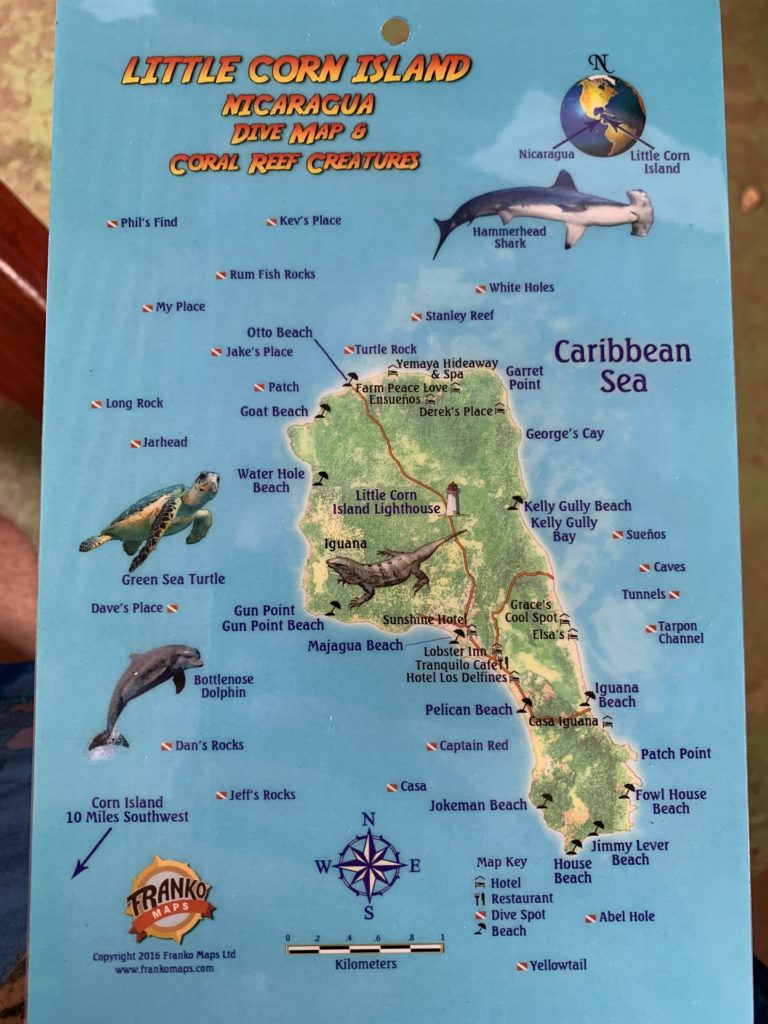
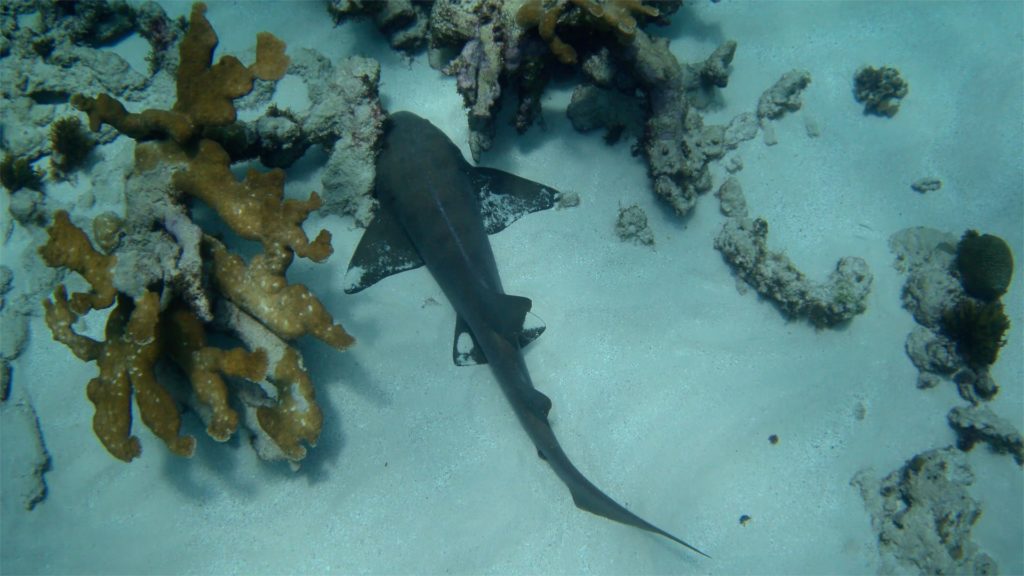
The next day we visited a dive site called white hole and it was here that the reef of little corn was at its most spectacular.
There were some truly massive patches of elkhorn coral, an endangered species that I’d never seen before and which grows in the shape of an elks horns; bigger than a person and a stunning fiery orange in colour.
Among it, there were all manner of other coral species including dense carpets of red staghorn coral dotted by green lettuce and purple lobe corals; with blue vase and pink great star corals rising up amongst them between bright orange sponges and with many more seafans and sea whips waving about in the current.
Angelfish, porkfish, sergeant fish and jawfish… clownfish and soldierfish with goatfish and more fish – plus pufferfish and squirrelfish with cardinalfish to and many other kinds of fish in every colour you could wish…
…darted and weaved; floated and hovered; shot and glided amongst the intricate coral reef like tiny pieces of colourful confetti swirling around a giant living pinata of every layer, shape, colour and texture you can imagine. At one point an eagle ray circled all the way around us before darting off and another time we spotted a huge turtle cruising through the waters in the distance.
In total I saw four nurse sharks. Most were five to six feet in length; with their dark grey skin and pointed fins, they looked distinctly sharky; although these slow-moving bottom dwellers have also been dubbed the “laziest sharks in the world” and indeed most were simply loafing about on the sand, waiting for nightfall when they would become ever so slightly more active to cruise along the sea-bottom hunting for bony-fish, crustaceans and small rays.
The laid back nurse sharks are endemic to the corn islands; indeed around white hole you are almost guaranteed to see them and this was one of the initial reasons I had travelled all the way to Nicaragua to dive.
Sadly, my beloved Paralenz Vaquita, with which I had resolved to capture all of my underwater footage at the Corn Islands with, hadn’t charged overnight due to a power cut and it ran out of battery some ten minutes into the dive.
Fortunately; being underwater noone could hear me shouting “ah no – there goes another one! Ahhhh fuckin ‘damnit“!! which I did for a good minute or so as several nurse sharks that I was unable to film swam by.
Then I settled down. Perhaps it was a sign form the sea gods to make sure I didn’t only ever view their mighty domain through the lens of a camera.
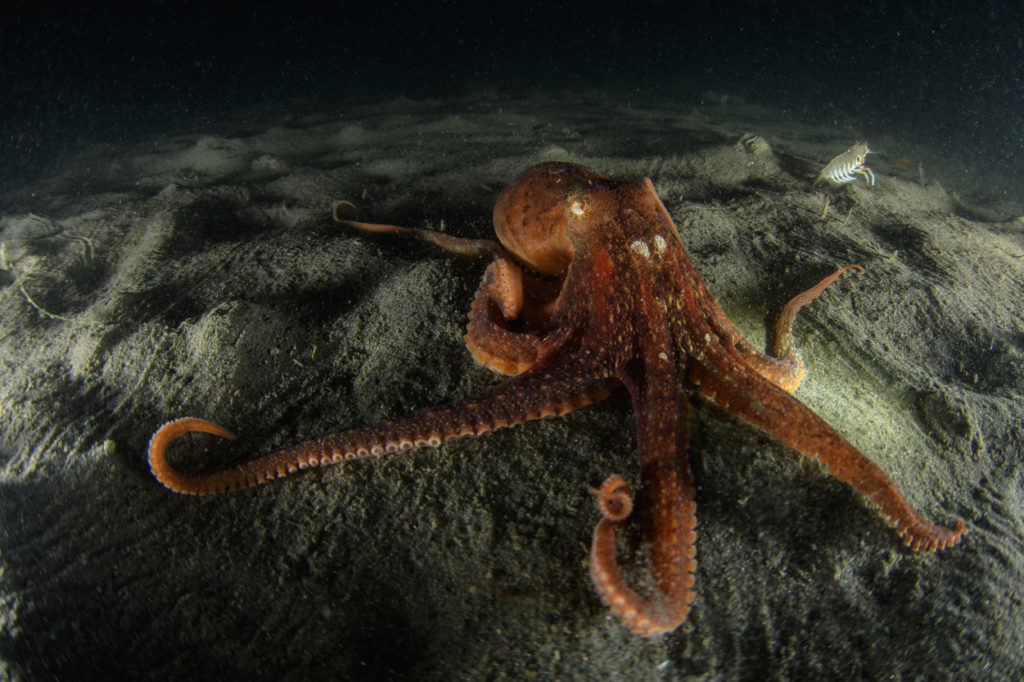
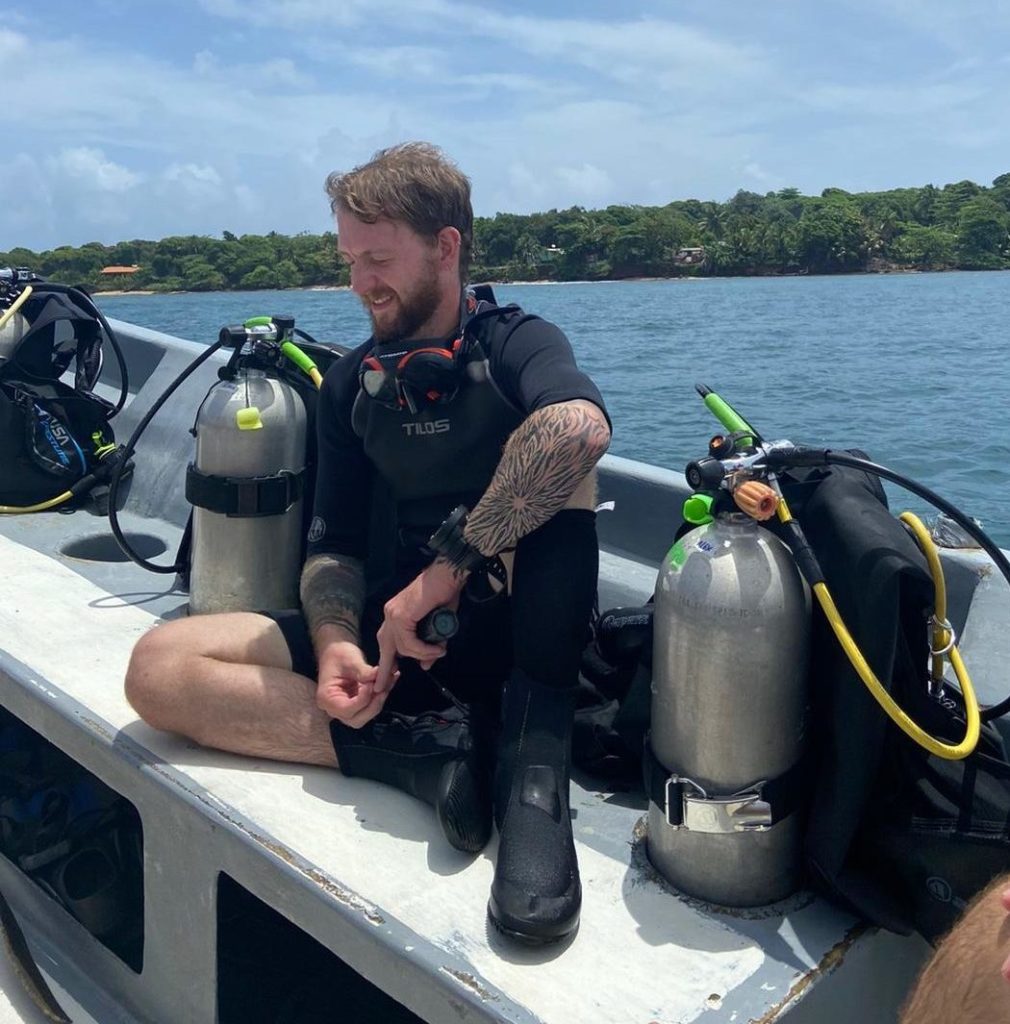
Over the next several days, I made more dives around little corn.
One sunset, we went on a night dive and drifted through the pitch black water; torches in hand to see rays hunting octopuses, dart crabs mating, huge remoras and a thousand pink eyes of shrimps staring out at us between the cracks and crevices of the coral.
The water was alive with plankton; tiny shrimp and worm like creatures became attracted to the lights of our torches; swirling around them like living clouds and then, small schools of fish that hunted them so close to me I could feel their scales occasionally brush past my skin in the dark.
At one point, we all stopped and turned off our torches. The water became alive with tiny, speck sized florescent plankton that lit up around us; glistening like stars or a swarm of fireflies.
And then it was time to leave.
All in all, the Corn Islands were a very special place to dive.
I consider myself extremely lucky to have seen all the things that I did – the dolphins and nurse sharks, the squid and coral reef, the fish and rays and finally the florescent plankton at night.
Diving the Corn Islands of Nicaragua was definitely an all-time highlight of my year spent in lower Central America. Like everywhere I visited, I hope that someday I’ll be able to go back there and that the marine ecosystem will be as healthy if not more so than it was before.
Here’s the vid:
Shot entirely with the Paralenz Vaquita, I was really pleased with how this video came out. Comparing it to my earlier projects; I felt like the camera was a lot steadier; the shots more varied; the editing more interesting.
I had also finally started to get the hang of post-processing colour to enhance video image; the royalty-free music I’d chosen fit perfectly and there were lots of great subjects to film.
I did get some looks by a couple of backpackers whilst dancing around on the camera for the beach intro scene, but I felt like this narration was short and punchy; informative enough and matched well the overall vibe I was going for.
There’s always room for improvement and I really want to make my videos the best they can possibly be, but I definitely felt like I’d come a considerable way.
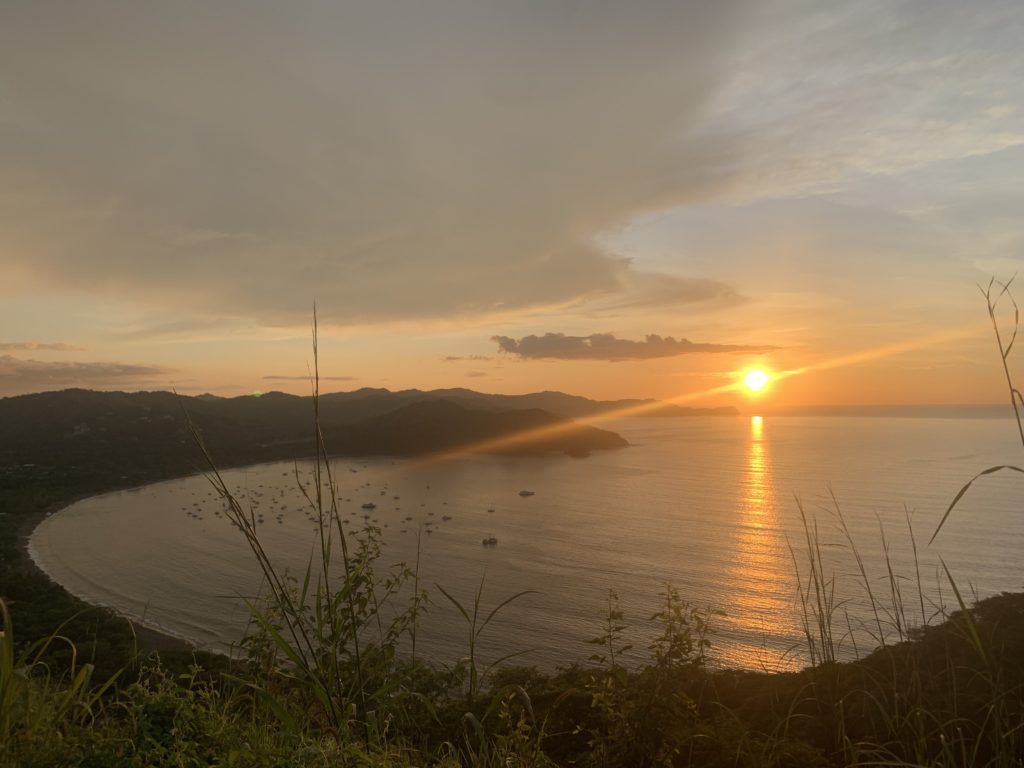
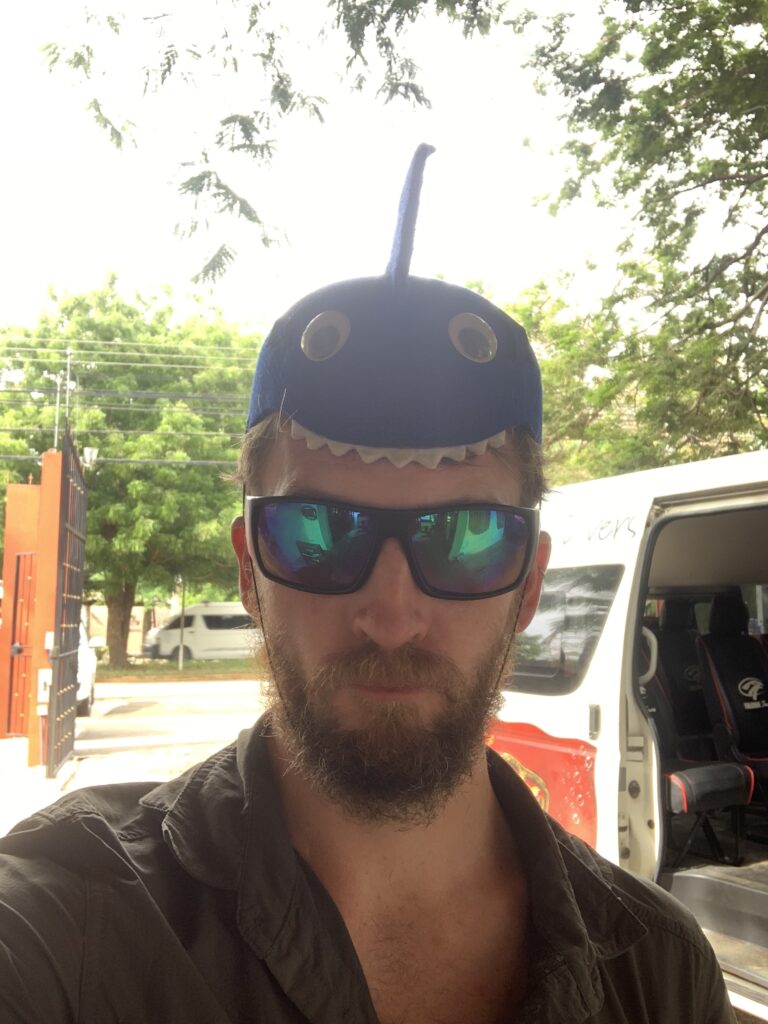
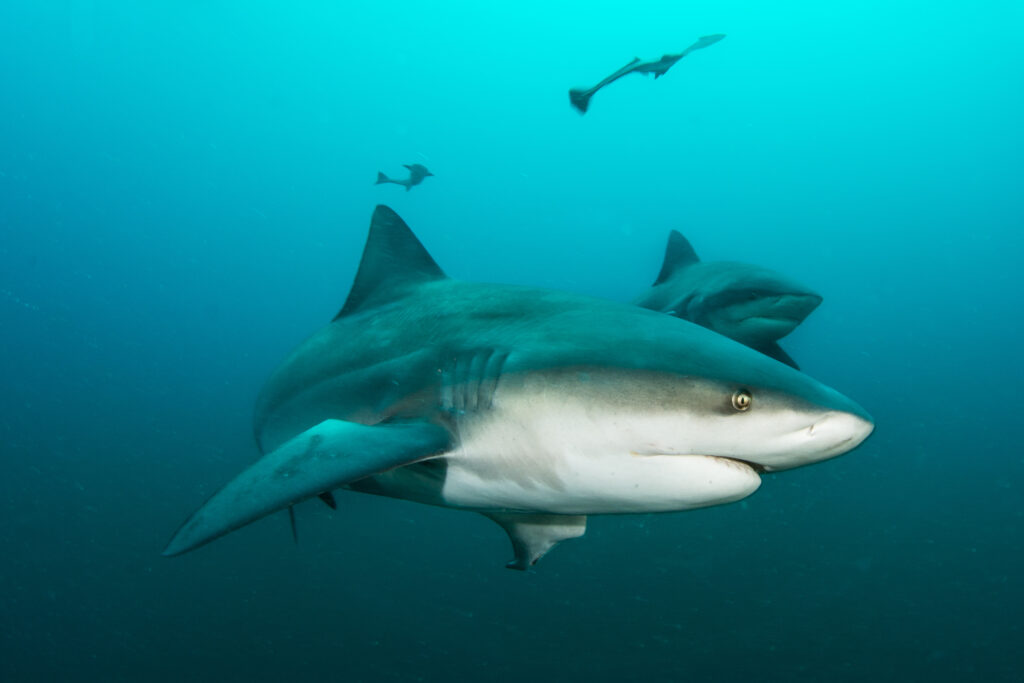
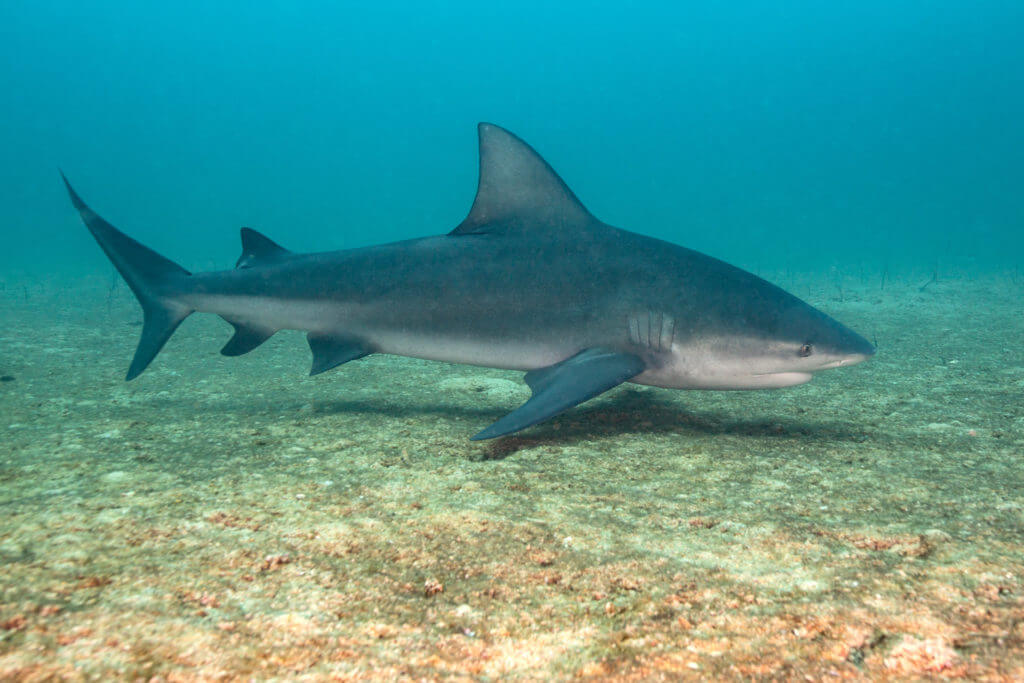
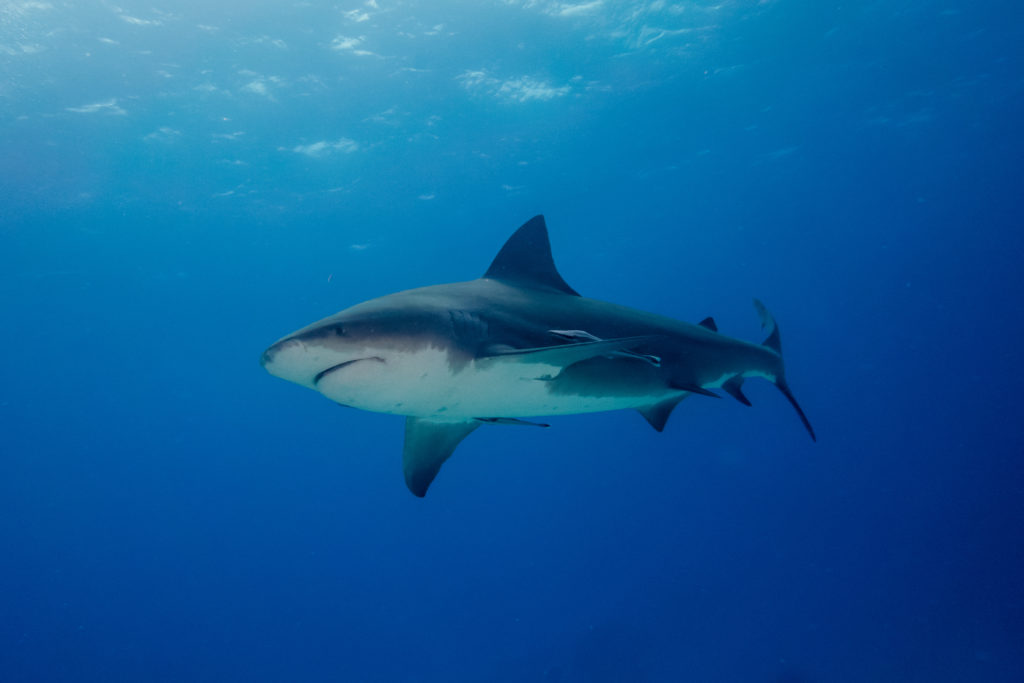
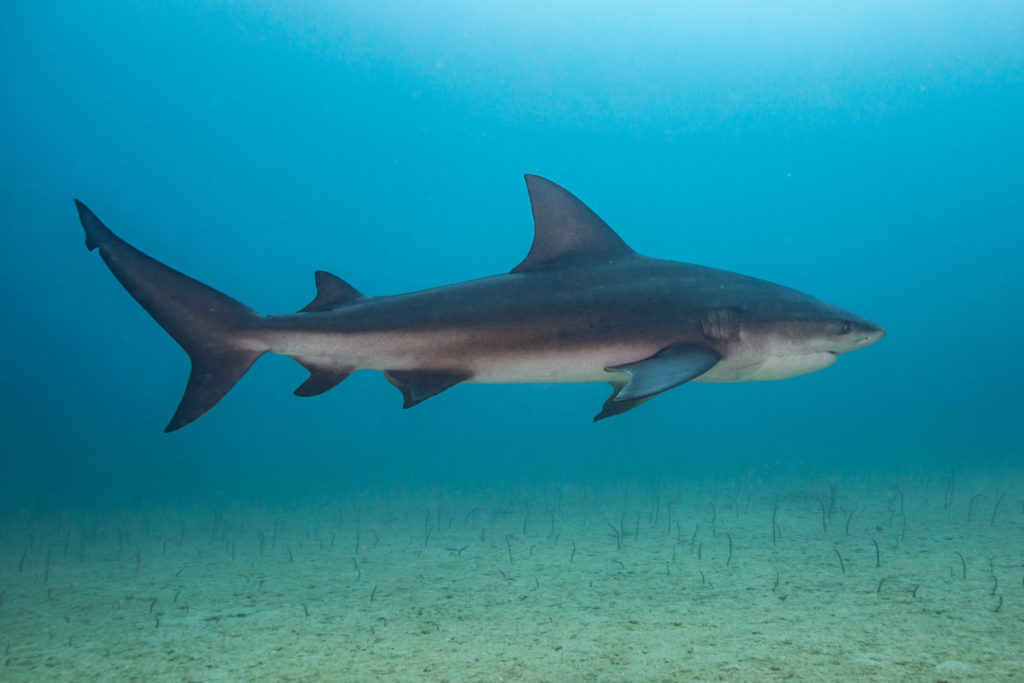
On the day that I flew from the corn islands back to Managua and reunited with Senor. Carro; it was the 31st of May: 360 days after I’d first flown into Costa Rica back in June 5th 2021.
It was Costa Rica that I now drove back into.
My destination: Playa del Coco – I had one final mission: A final attempt to see bull sharks at the Bat Islands near Playa del Coco!
June is supposed to be one of the best times of the year to see them there; the water’s are not so rough as to deter dive boats from visiting and visibility isn’t too bad either.
It was a long 282km drive from Managua to Playa del Coco; the last few hours of which I made in darkness against a torrential downpour.
The AC had broken once more meaning that the windows fogged up terribly and in the last hour the headlights started to switch on and off; a bad sign.
Luckily Senor. Carro got me all the way to Playa del Coco….where it then immediately broke down literally as I arrived in town. Ahhhh come on!!!
With the help of some passers by, I got the car push started and drove it the final 500 meters to my airbnb. But after I turned it off, it would not come back on again.
This was slightly problematic as I actually had a flight to catch out of San Jose in 5 days and before then I needed to dive the bat islands, drive back to San Jose, meet Gerardo to sign the necessary documents to get Senor Carro ready to sell and arrange all of my belongings for a long international flight.
However, for now I’d made it to Playa del Coco; where after having messaged back and forth with no less than five dive centres in the previous few days, I’d finally found one (Rocket Frog Divers!) who had enough other interested diver’s to be going to the Bat Islands on the 1st of June.
So I hunkered down and went to sleep, dreaming of sitting atop a mighty bull shark that tore through the waters; devouring my foes.
The next day I awoke and leaving Senor. Carro lifeless behind, walked whilst carrying my dive gear 1.5km to Rocket Frog Divers where we shortly departed down to Playa Coco and embarked on a ninety minute boat ride to the Bat Islands – also known as Isla Murcielagos.
Let’s take a brief moment to recap what a Bull Shark is.
Usually 8ft (but up to 11.5 ft) long and weighing up to 130 kg, they’re some of the most muscular and powerfully built sharks in the world, with a bite that is even stronger than a Great White Sharks.
They prey on smaller sharks, turtles, dolphins and sometimes (usually by accident) people – and they have even been found in rivers due to their ability to survive in freshwater.
Because of their aggressive nature, wide distribution and love of living near highly populated areas; bull sharks are actually considered by most experts to be the most dangerous sharks in the world, with great whites and tiger sharks coming in second and third place.
(Of course no shark is truly that deadly – the number of fatalities inflicted on humans by sharks is extremely low, whereas the number of fatalities inflicted on sharks by humans has driven many shark species to the verge of extinction).
So far over my year diving Central America; I’d see countless white tip reef sharks at playa del coco, isla del cano and coiba… hammerhead sharks at coiba…and nurse sharks at the corn islands but not one bull shark – despite having made three trips up to Playa del Coco to try and spot one. Fourth time lucky right!?
After a manic and bumpy 90 minute boat ride in hailing rain; we made it to isla murcielagos (the bat islands); which were little more than a couple of jagged rocks sticking out of the sea which crashed against them chaotically.
We suited up and dived down as quickly as we could.
We’d been told to get below the surface as quickly as possible and stay in the group at all times; it would make us appear like a pack and probably deter any bull sharks from attacking us.
There we waited on the sandy sea bottom where the water was cloudy yet again due to red algae reducing visibility to about 30ft.
Several moments passed and then a hulking silhouette appeared out of the water before crystallising into an adult bull shark that swam past us less than eight foot away.
No photo, video or description can do justice to the power and energy with which an apex predator such as this carries itself. You could tell that these bull sharks ruled their aquatic kingdom and they knew it!
(Except for when they encounter killer whales, a few of which have adapted to eat them…)
It was an amazing sight to witness that bull shark glide past us so calmly before it was swallowed back up in the murky waters – we didn’t have to wait for long before we saw another – and another!
They appeared all around us in every direction; there must have been several although I never saw more than two together at the same time.
Alas, the cloudy water made my video quality extremely low; which is why the images to the right are actually from shutterstock) – but check out the clip I got all the same:
It left an awesome taste in my regulator to have finally seen a bull shark after trying four times in the same place over the span of a year. When it comes to filming and photographic nature; you need persistence, timing, luck and good weather conditions.
Some nature photographers, such as those venturing after Siberian Lynx have spent literally years waiting to get the right shot.
Senor. Carro had been repaired once more so I drove to San Jose in Costa Rica and two days later; on the 5th of June 2022, exactly one year after I’d first arrived in Costa Rica: I left. Some day I’ll go back to visit all my friends and the places I dived as well as finally scuba dive Costa Rica’s legendary Coco Island. But it won’t be for a while.
When I’d first arrived 365 days before; I didn’t have any solid plan but I think a vague part of me had expected to settle down and live in Costa Rica!
Back then, I still had no real idea just how much work and exploring I have yet to do for Diving Squad and over the past twelve months; after much trial, error and experimenting, I’ve decided upon the best way to move things forward.
People often say that it’s a huge world we live on; one could spend ten lifetime’s on earth and still only experience a tiny fraction of all the places, cultures and experiences it has to offer. Usually, that’s just talking about the land – there’s over twice as much ocean! An infinite supply of Diving Squad missions.
Moving forward, I plan to dive as many new places as possible before I’m dead. I want to witness the world’s most famous dive destinations whilst also venturing into new frontiers that people have never heard of before; to see what aquatic life is like across a range of environments and conditions of this mighty water planet we ironically call Earth. Throughout, I plan to thoroughly document the state of the ecosystems I witness; so that others who later dive them will have something to compare their own observations with.
I hope that during this information gathering process; as well as educating people I can also entertain them; using new techniques to grab the attention of those who may not otherwise have listened.
I will continue to improve and enhance my Diving Squad movies – I plan to use new underwater camera equipment; starting with macro lenses as well as incorporate new strategies, styles and themes when making underwater movies in addition to continuing to develop new styles of editing, post-processing and story telling.
I met so many inspiring people during my year in Central America; some I’ve mentioned, others I haven’t but to all of you: I want to say thanks for the gold nuggets of wisdom, the side-splitting funnies and the beautiful shared experiences. Stay awesome everyone!
I’ll close Chapter 2 with one final video showcasing some of the very best moments from a whole year driving and diving around (lower) Central America:
And now to you dear reader: for making it all the way through this chapter (2) of the Captain’s Log – thankyou!!! It means a lot that you were interested enough to lend me your time and journey through this vortex of memories with I to experience the adventure afresh together!
Now it’s over to you: leave your thoughts, ideas or own experiences in the comments section below – you have the power!!